fall inside a hole
Girders
First written March 27, 2024Piers, Bridge Girders, Block Bridge Girders, and related track risers have existed since the very first plastic and wood highway vehicles set to give track elevation.
Bridge Girders (1950s)
Early Bridge Girders (はしげた) sat entirely beneath the track and had molded "fins" that fit into the rails on the underside of the elevated rail section. These girders typically came in blue or sometimes reddish-orange in sets and later individually.
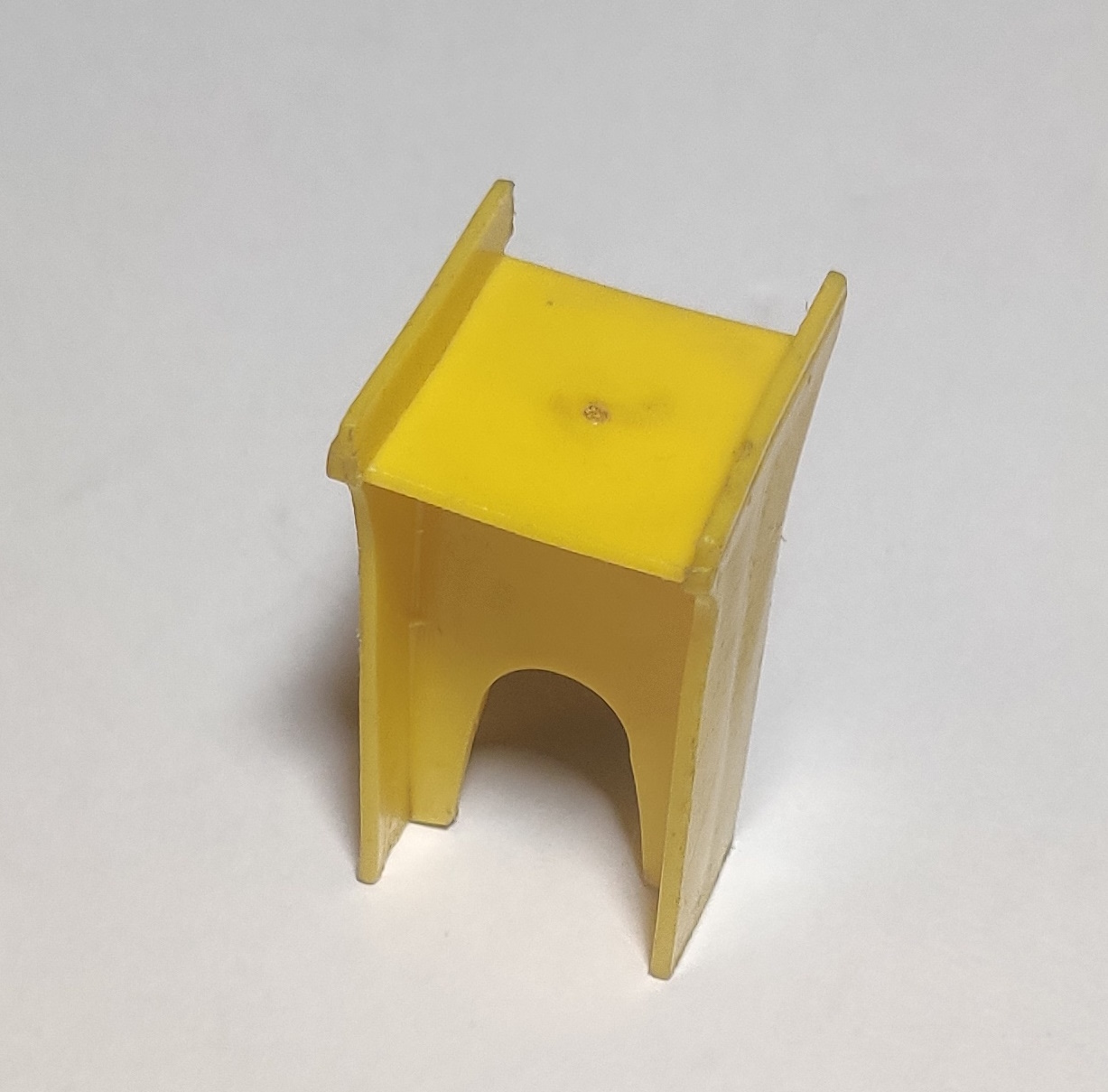
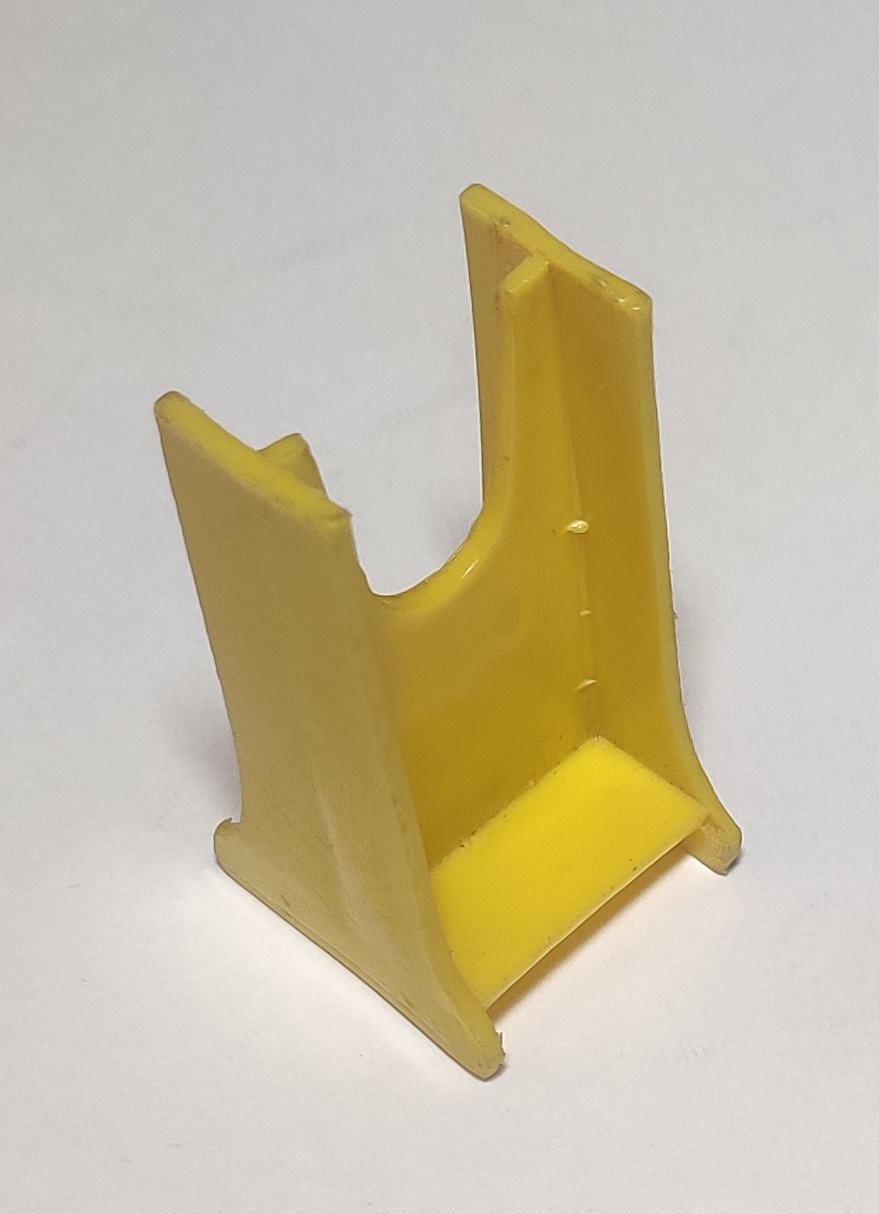
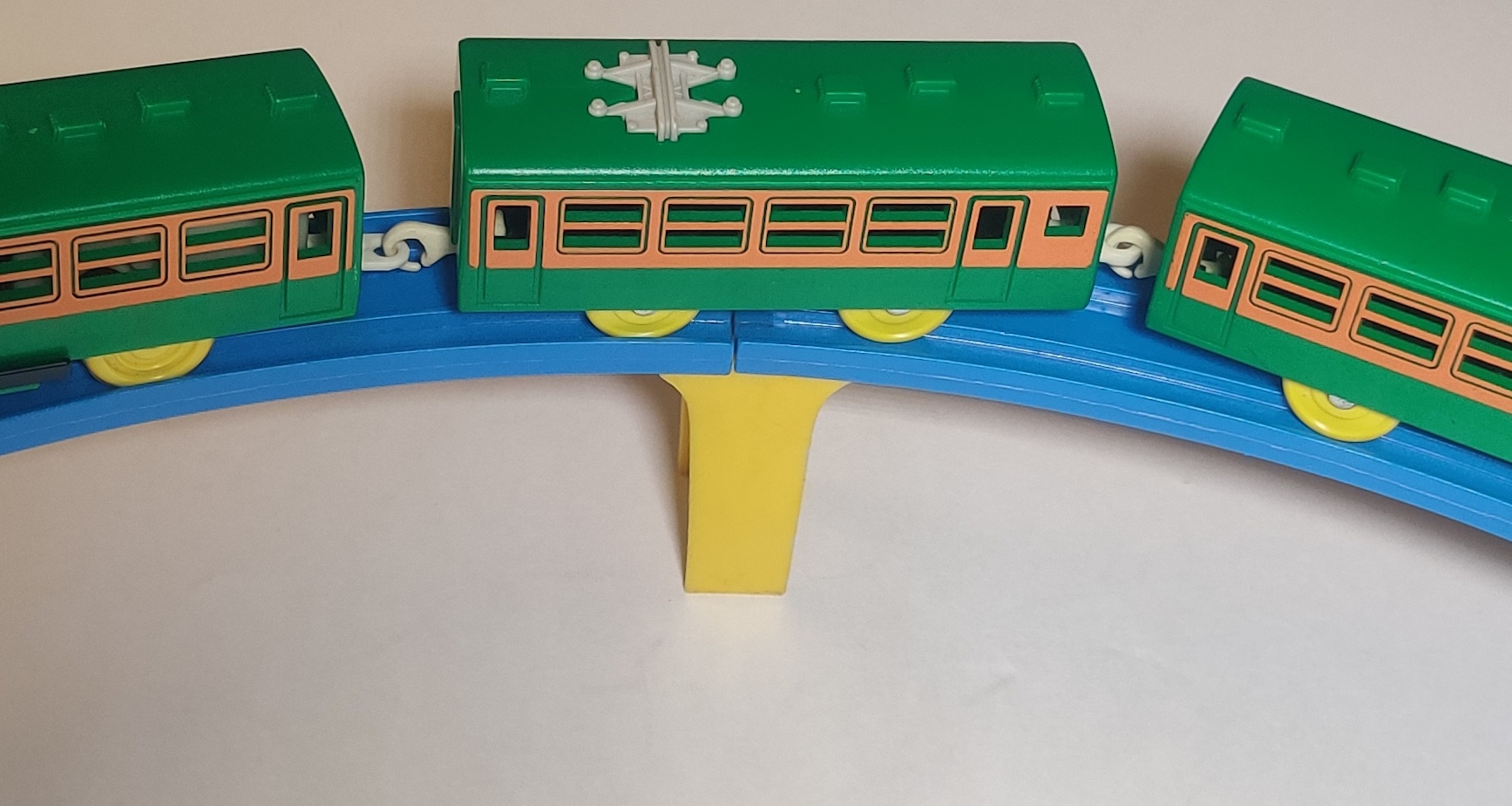
These girders were also sold in yellow in a pack of six individually into the early 1970s before going out of production around 1973. Some other examples of these girders can be seen in the Plarail Museum.
Bridge Support (1964)
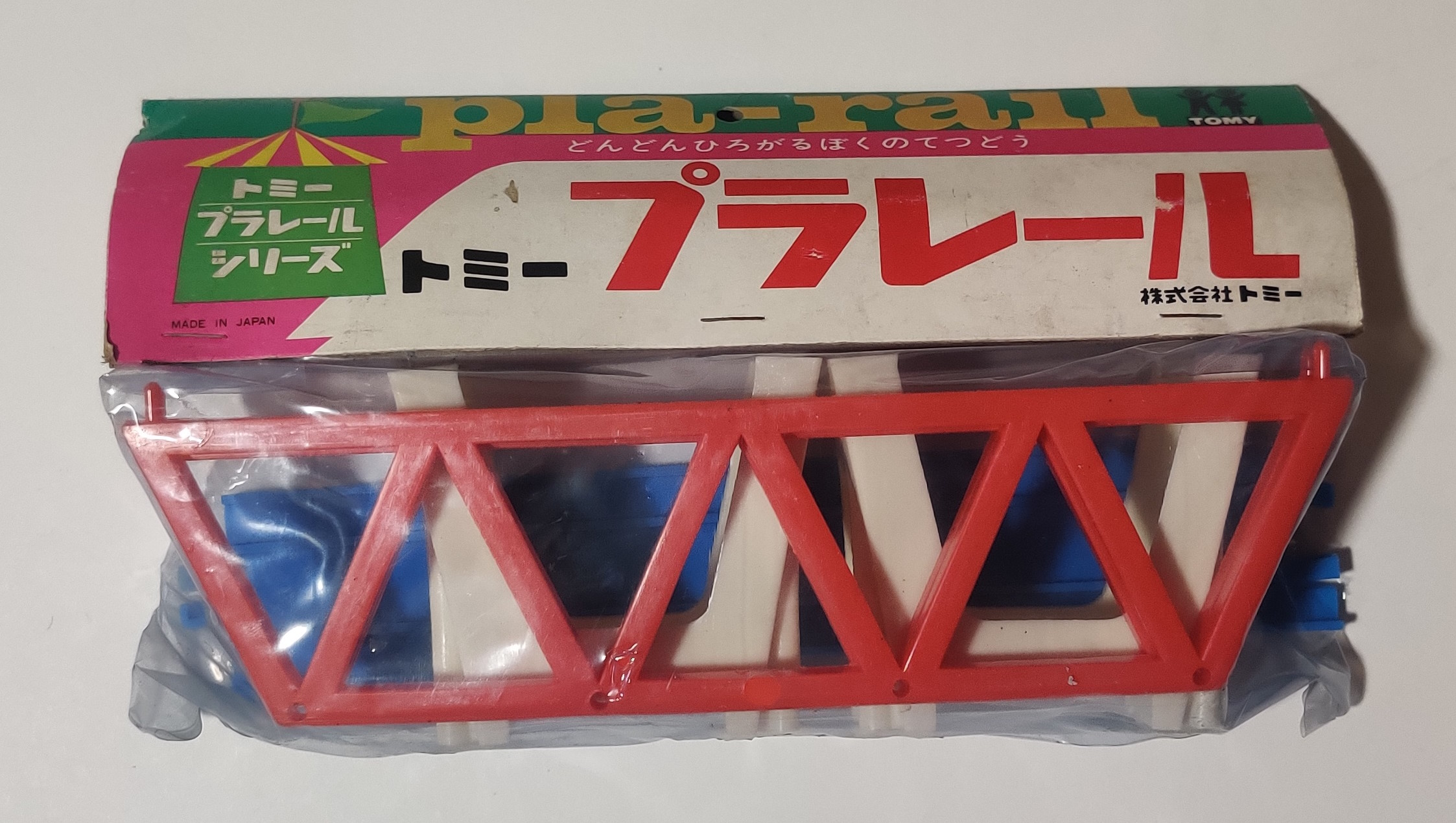
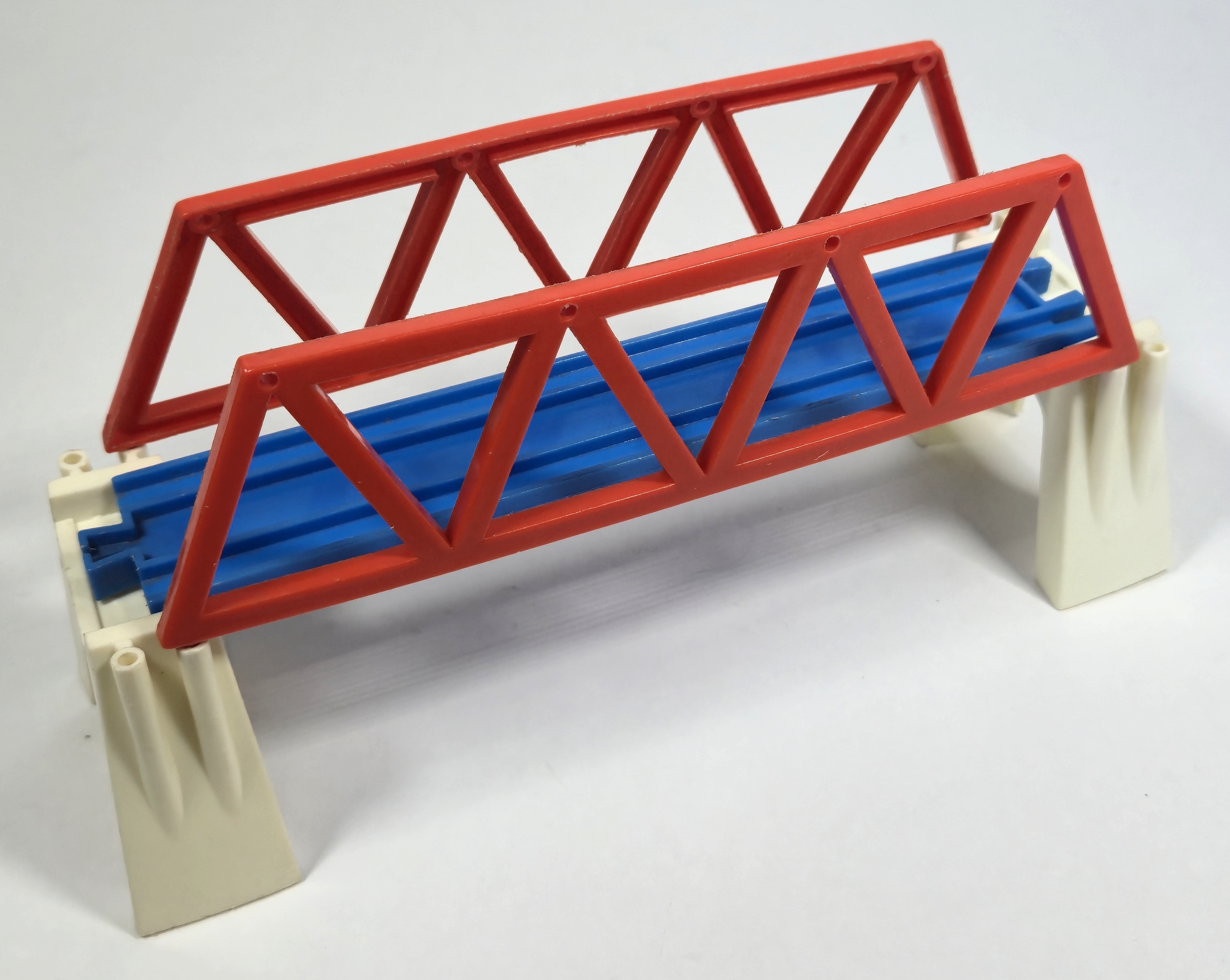
Around 1964 when the Iron Bridge was released it included two white bridge supports with a wide stance that splayed outward at the top to include inset pips.
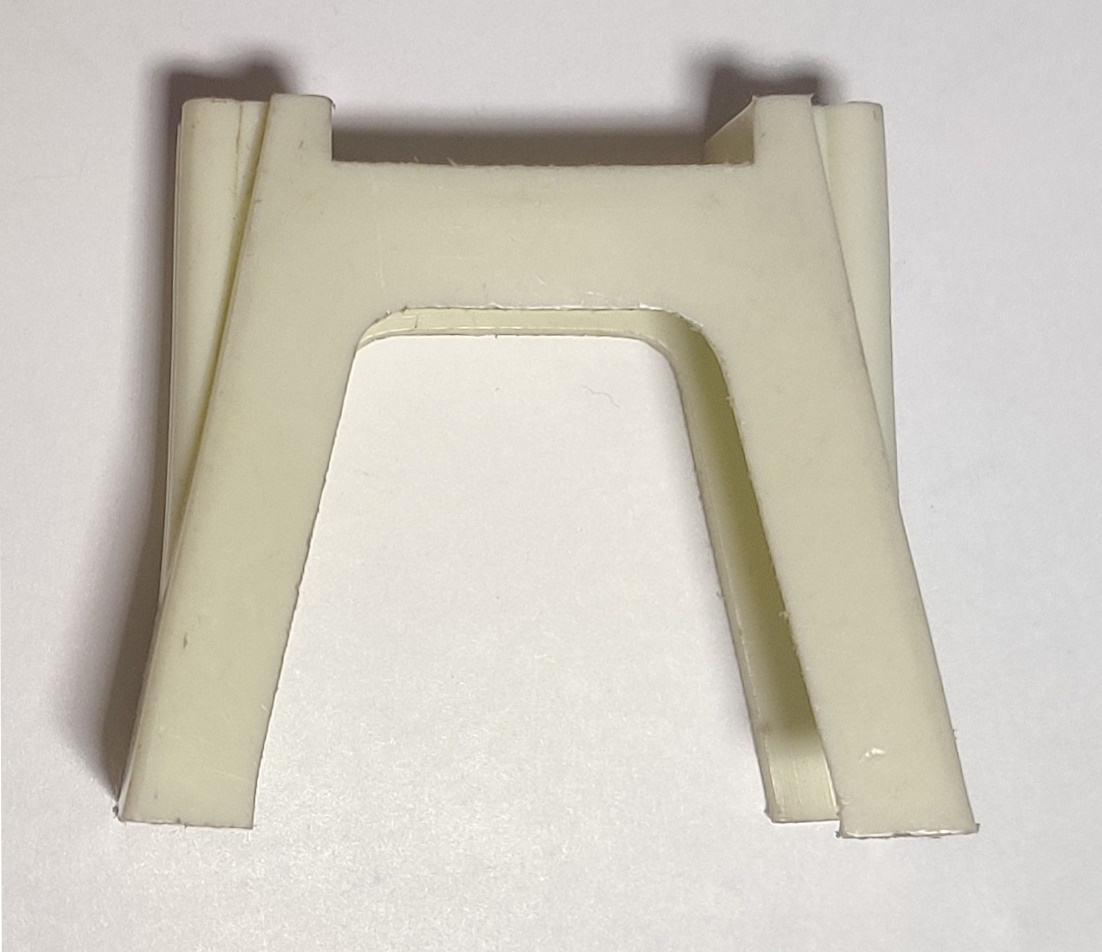
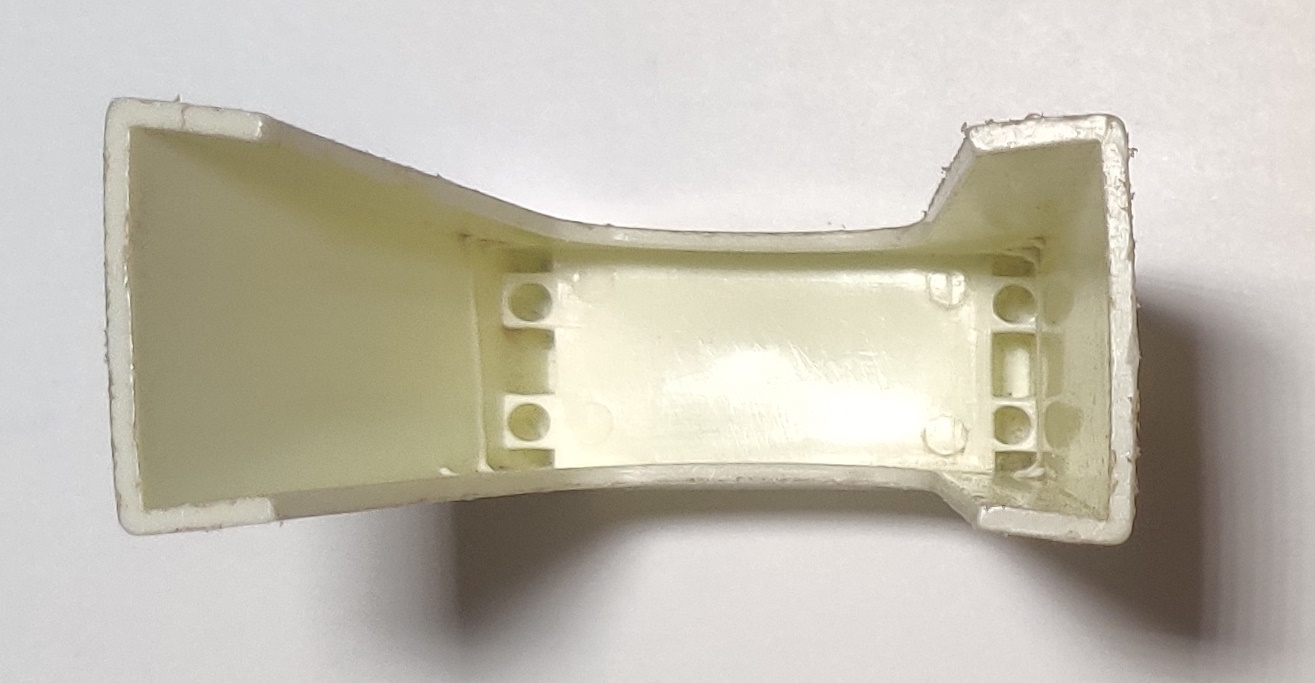
These supports were used into the early 70s until the individual Iron Bridge release was updated to use the newer larger yellow Bridger Girders also used in the first Big Iron Bridge around 1973.
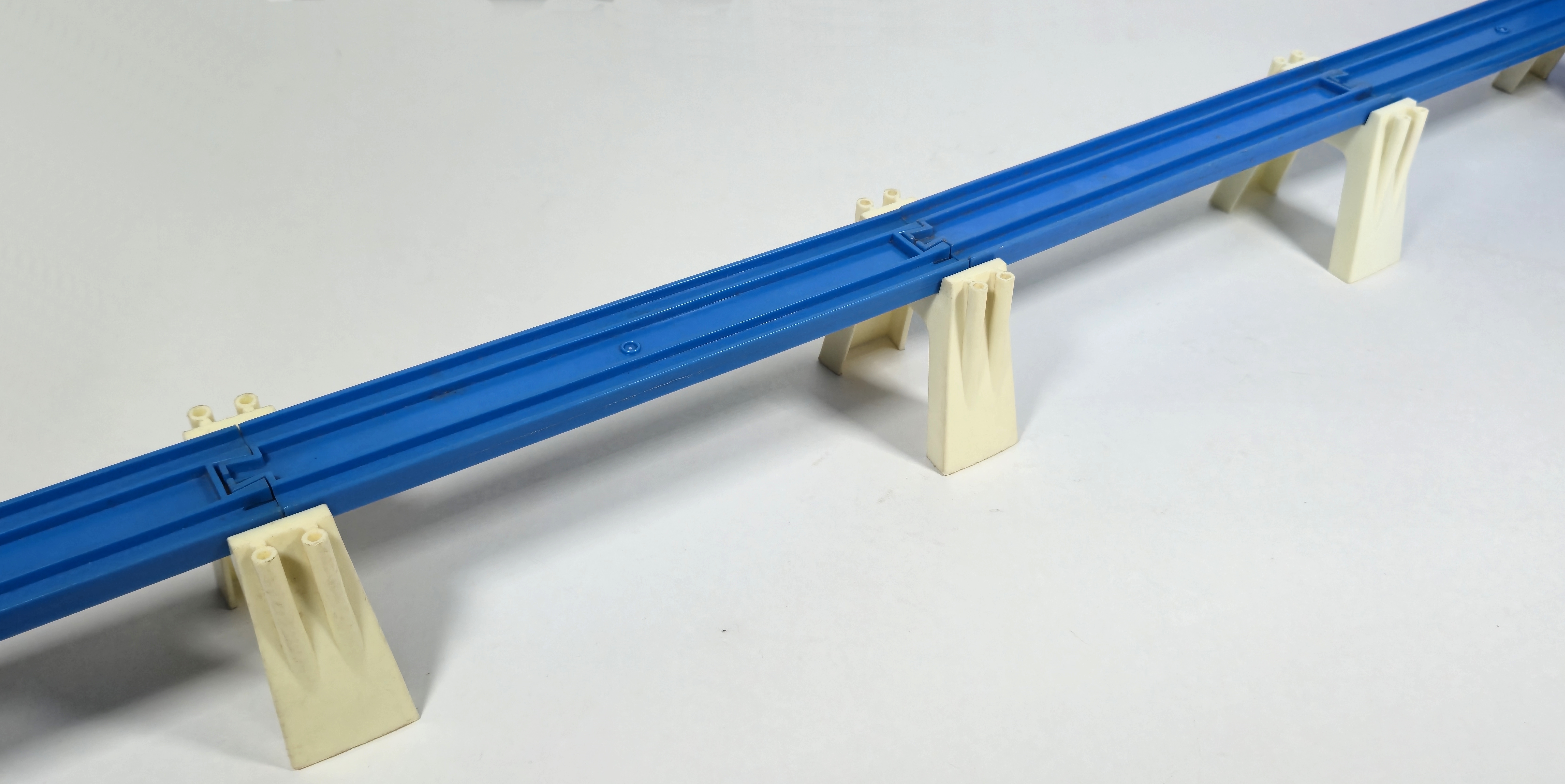
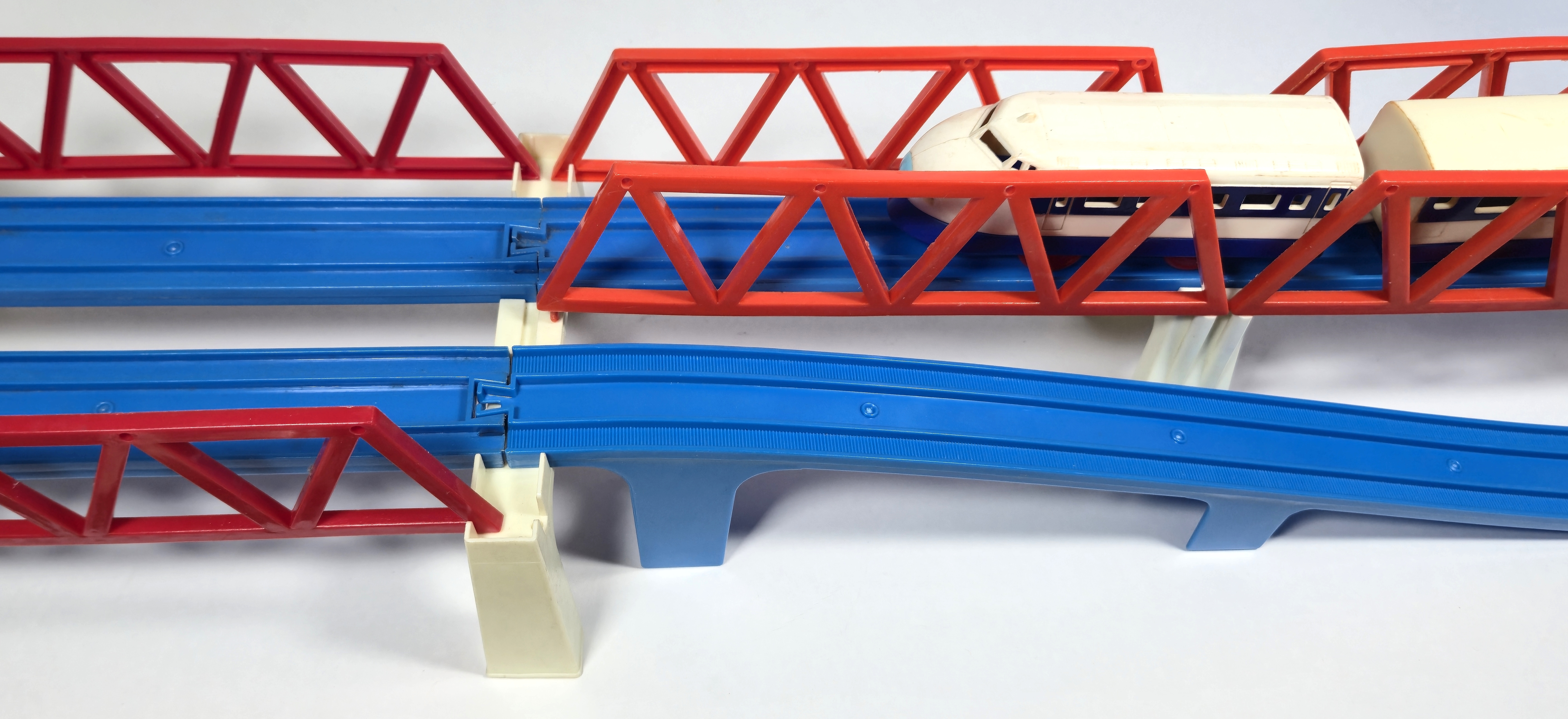
These girders are really elegant, perhaps the most out of any Plarail track support, and they work very well in longer spans and with the double track version shown below.
J-15 Double Track Bridge Girder (1968)
|
<-- J-14 Block Bridge Girder <-- J-14 "New" Block Bridge Girder |
J-16 Double Track Railroad Crossing --> J-16 City Station --> |
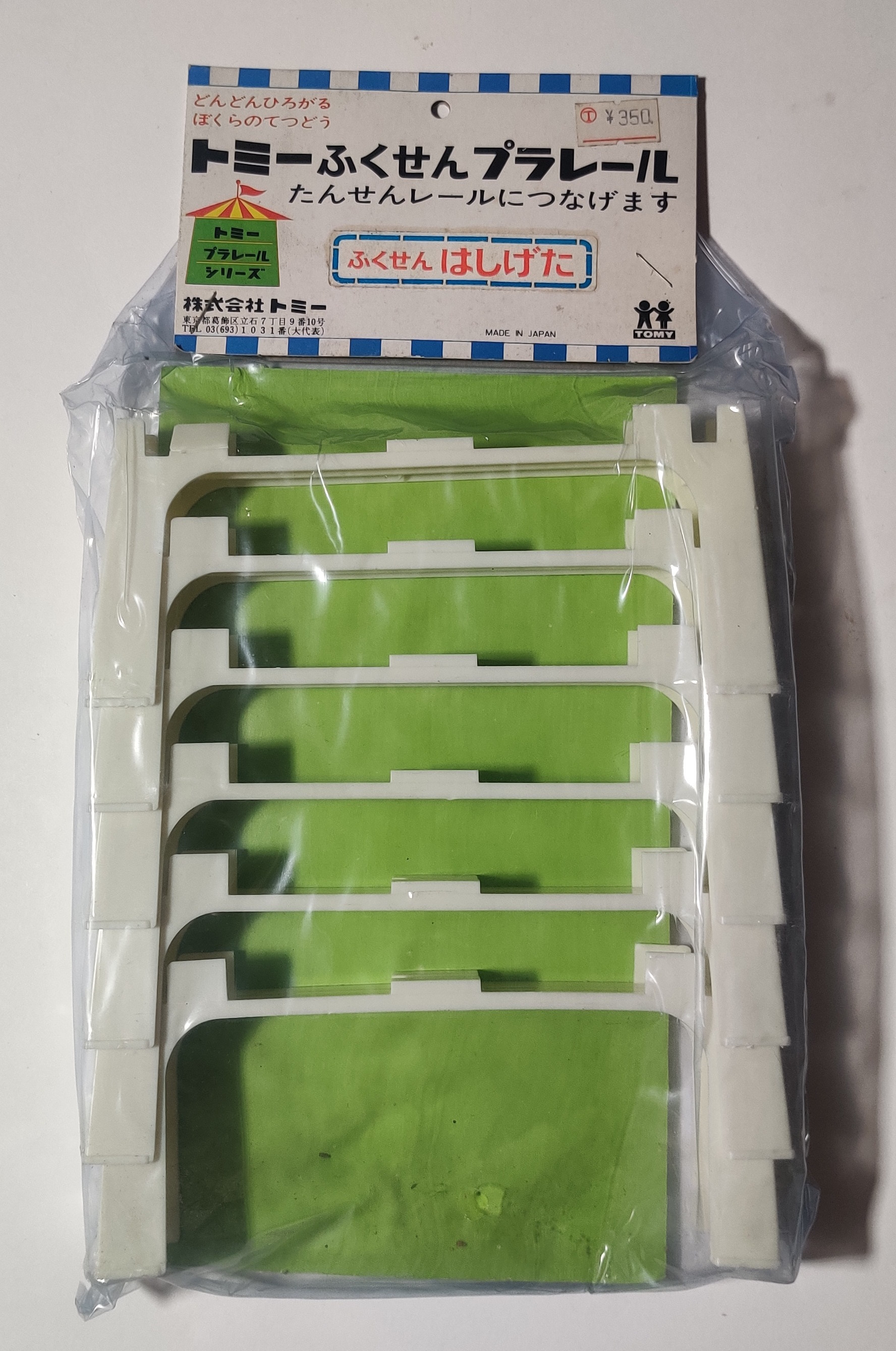
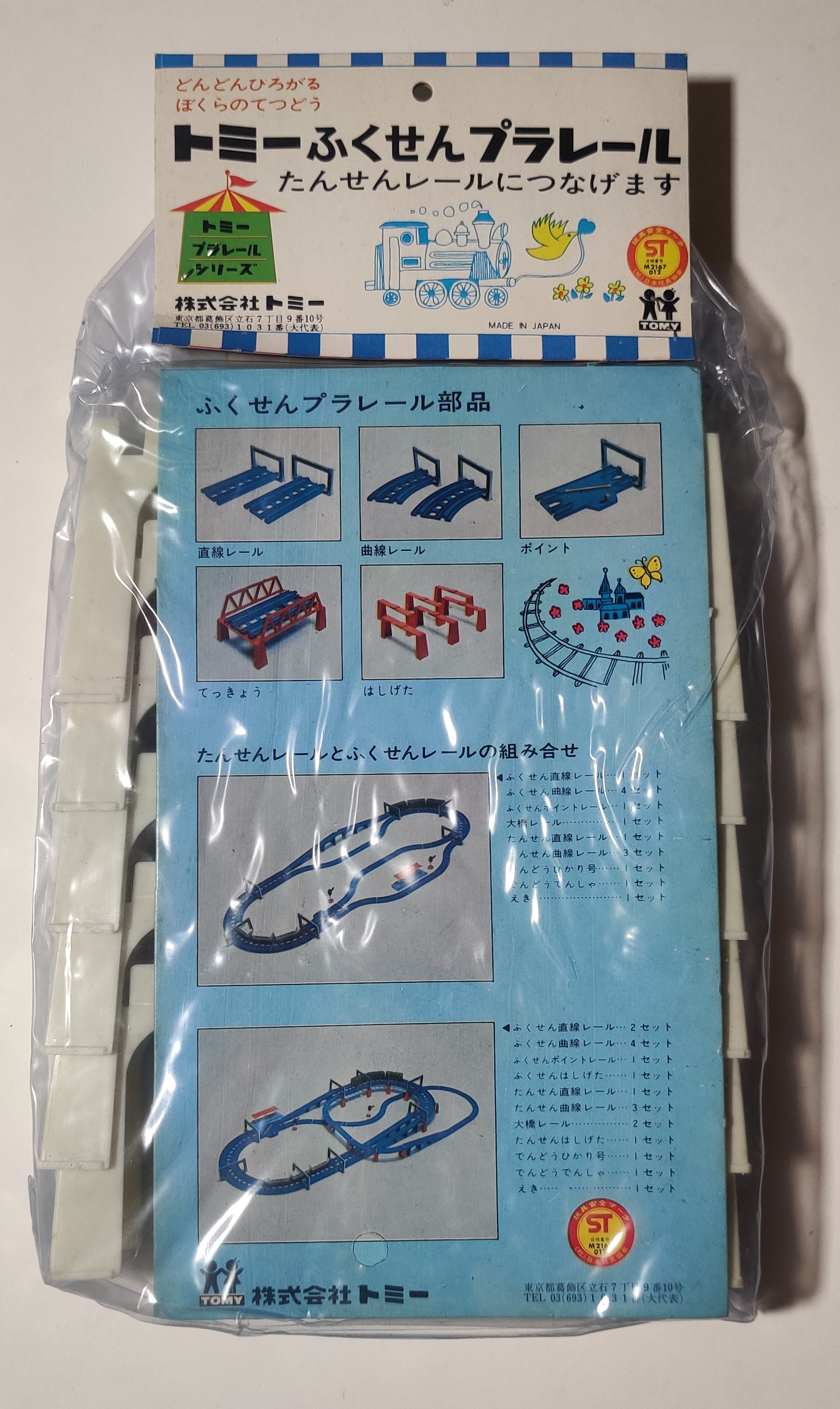
In 1968 alongside the introduction of the double track rail standard new Double Track Bridge Girders (ふくせんはしげた) were released in a similar style to the white girders sold with the period Iron Bridge. These girders accommodated two parallel-running tracks. The back of the packaging shows the prototype reddish-orange style of double track girder that appears to match the orangey single-track piers of the time.
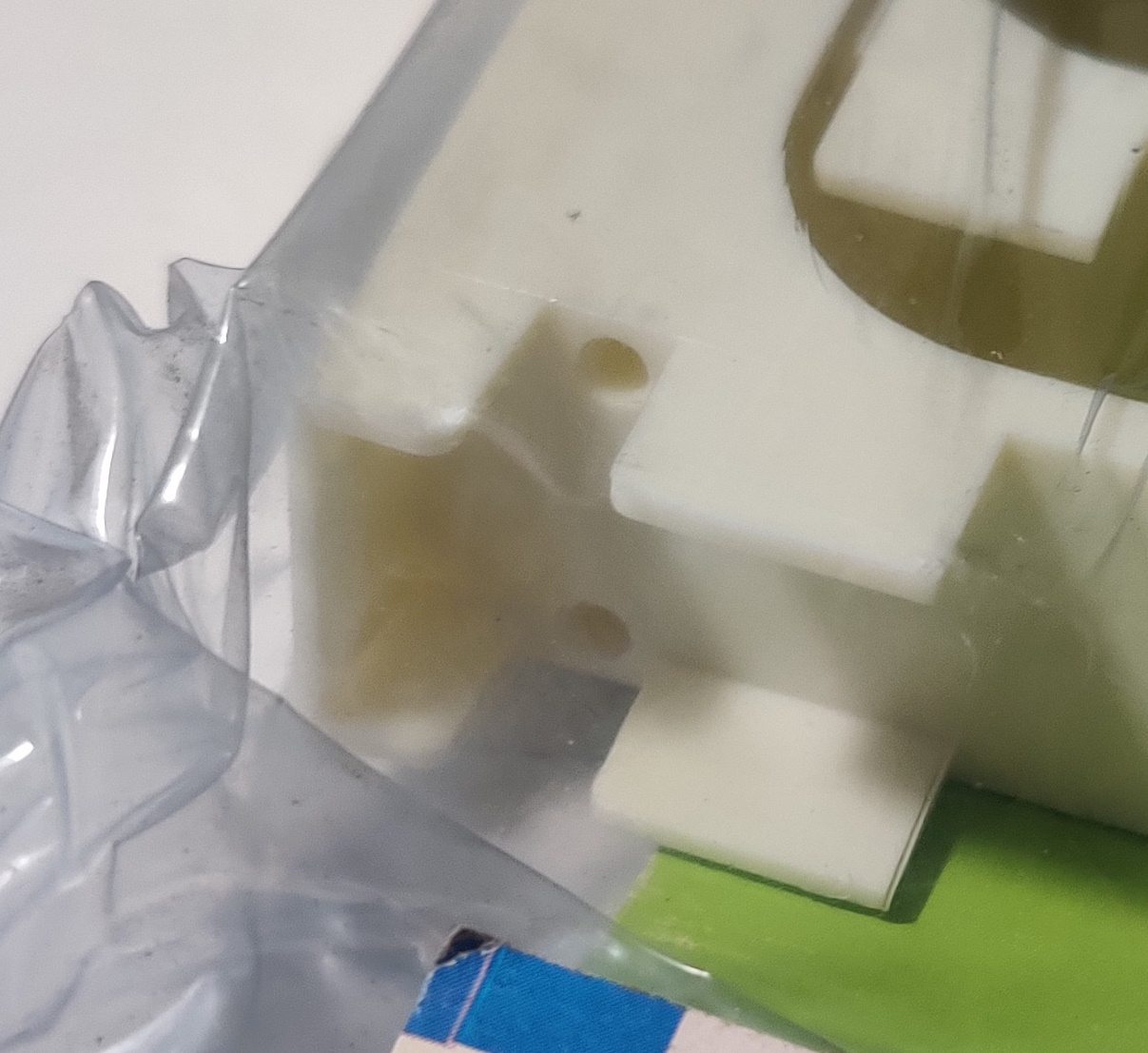
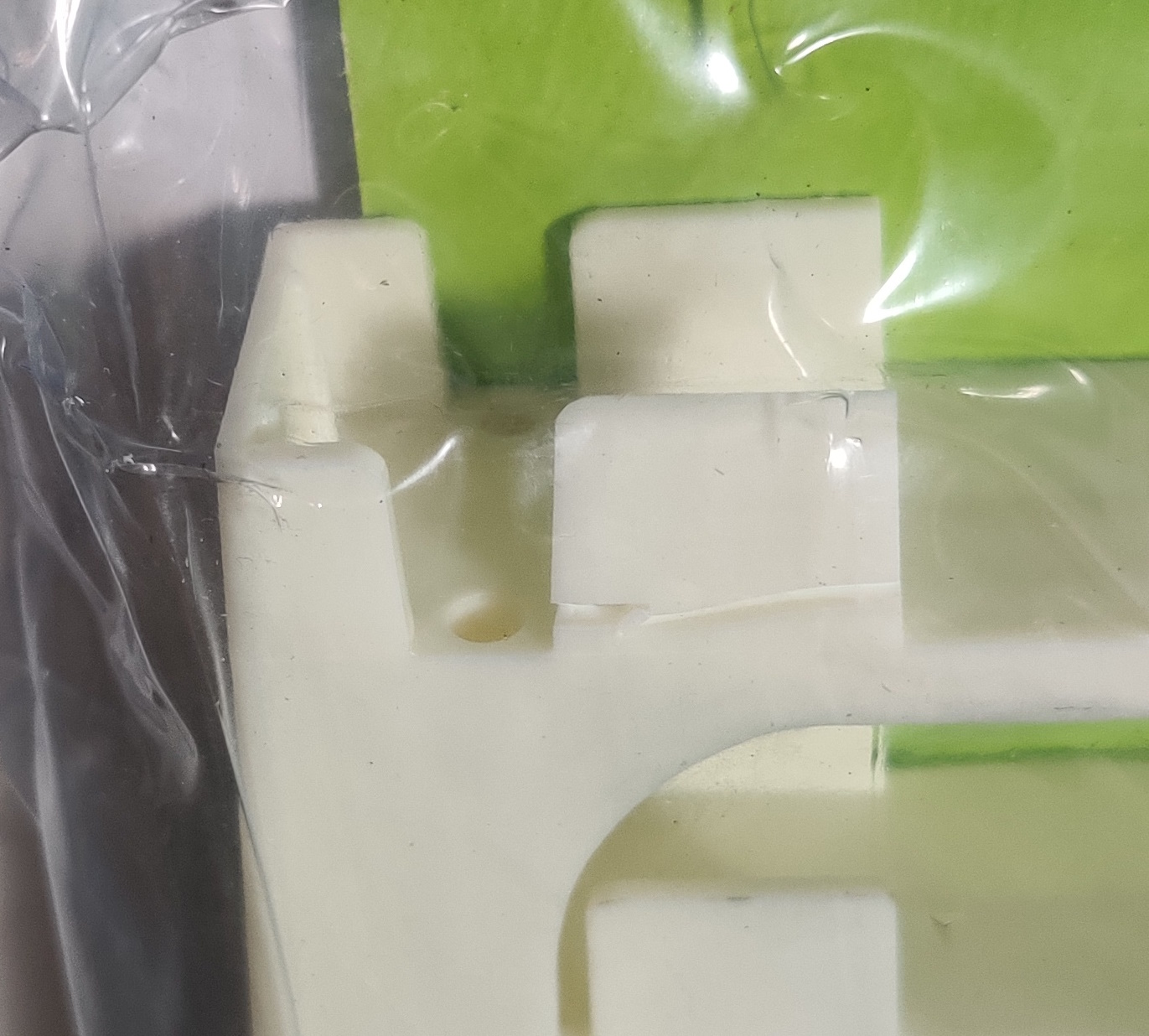
These girders can accommodate the nice wide catenaries also introduced for the double rail standard as well as the Iron Bridge side pieces, and a Double Track Iron Bridge was also released in 1968. These girders are somewhat fragile.
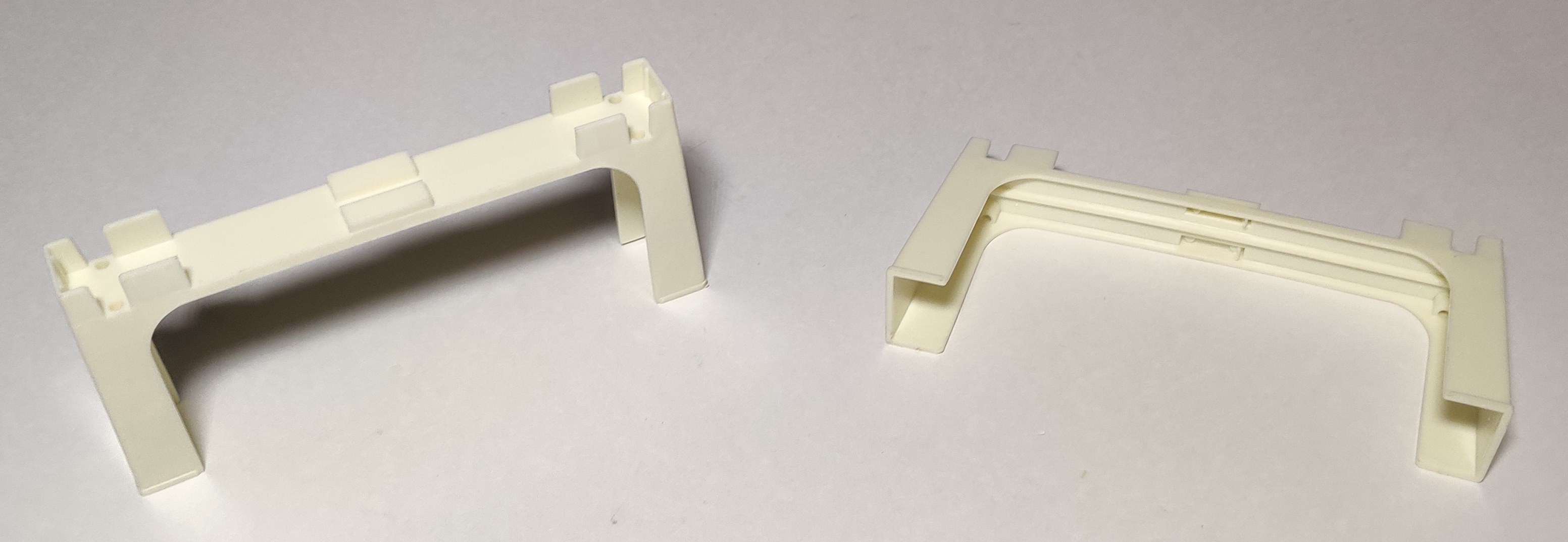
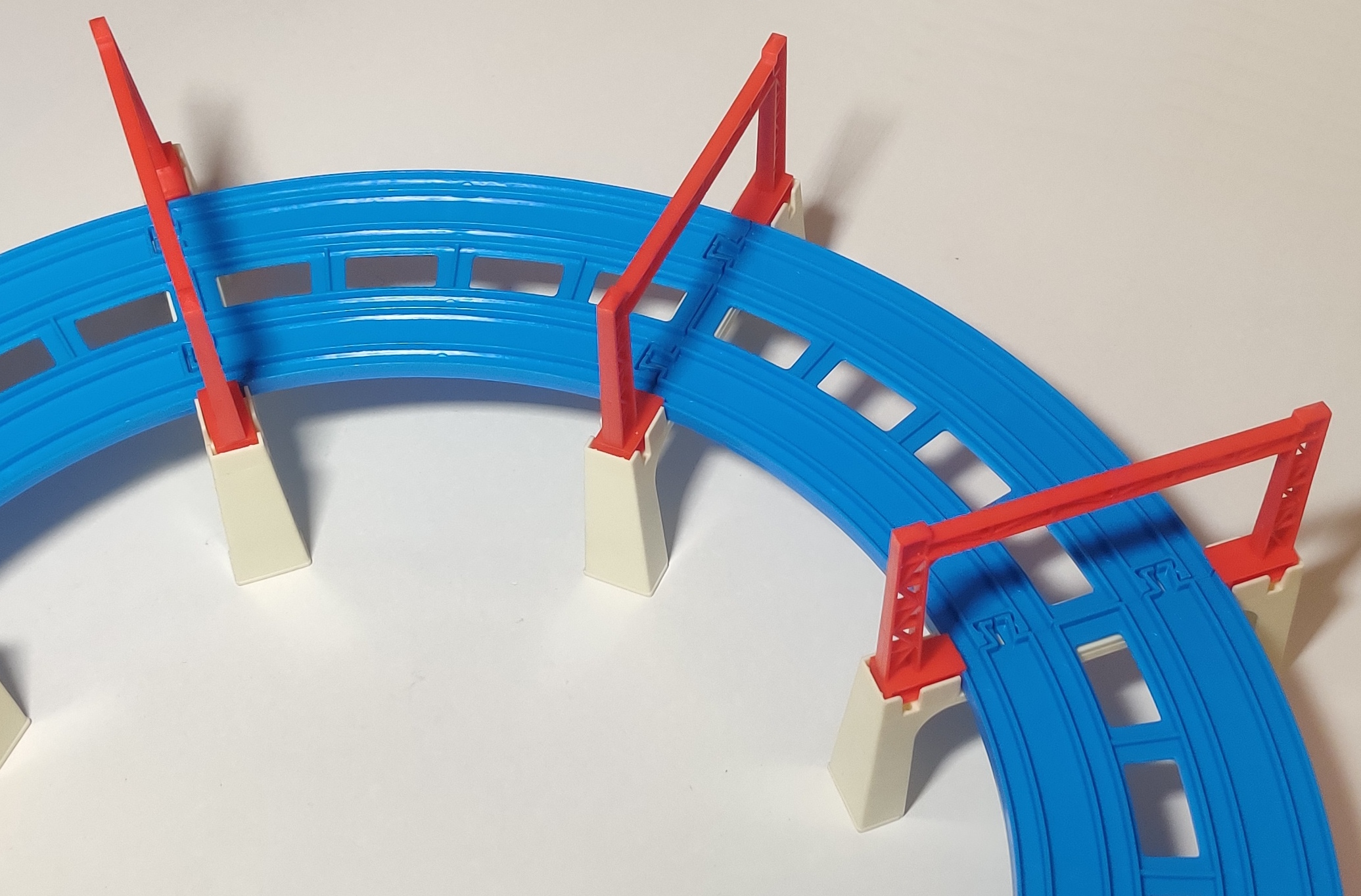
The piers pictured here are early 1970s examples from the Express Train with Elevated Track Set.
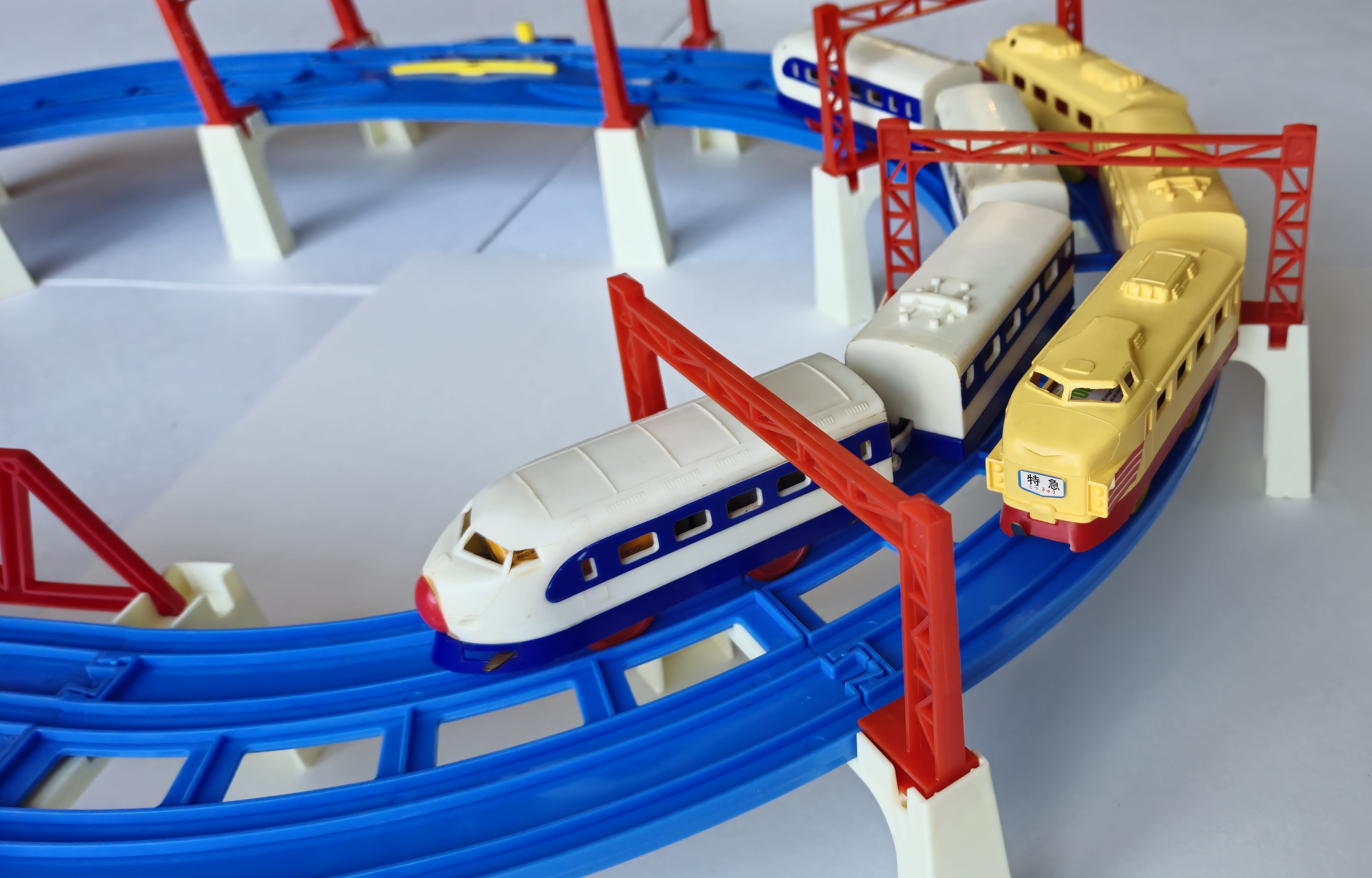
These piers remained in production into the early 1990s as there was not another style of double track bridge girder. Around 1988 they were given the designation J-15 and were sold as 複線橋げた Double Track Bridge Girder. After going out of print, there was not a double track girder until the J-22 Double Track Block Bridge Girder in the later 1990s.
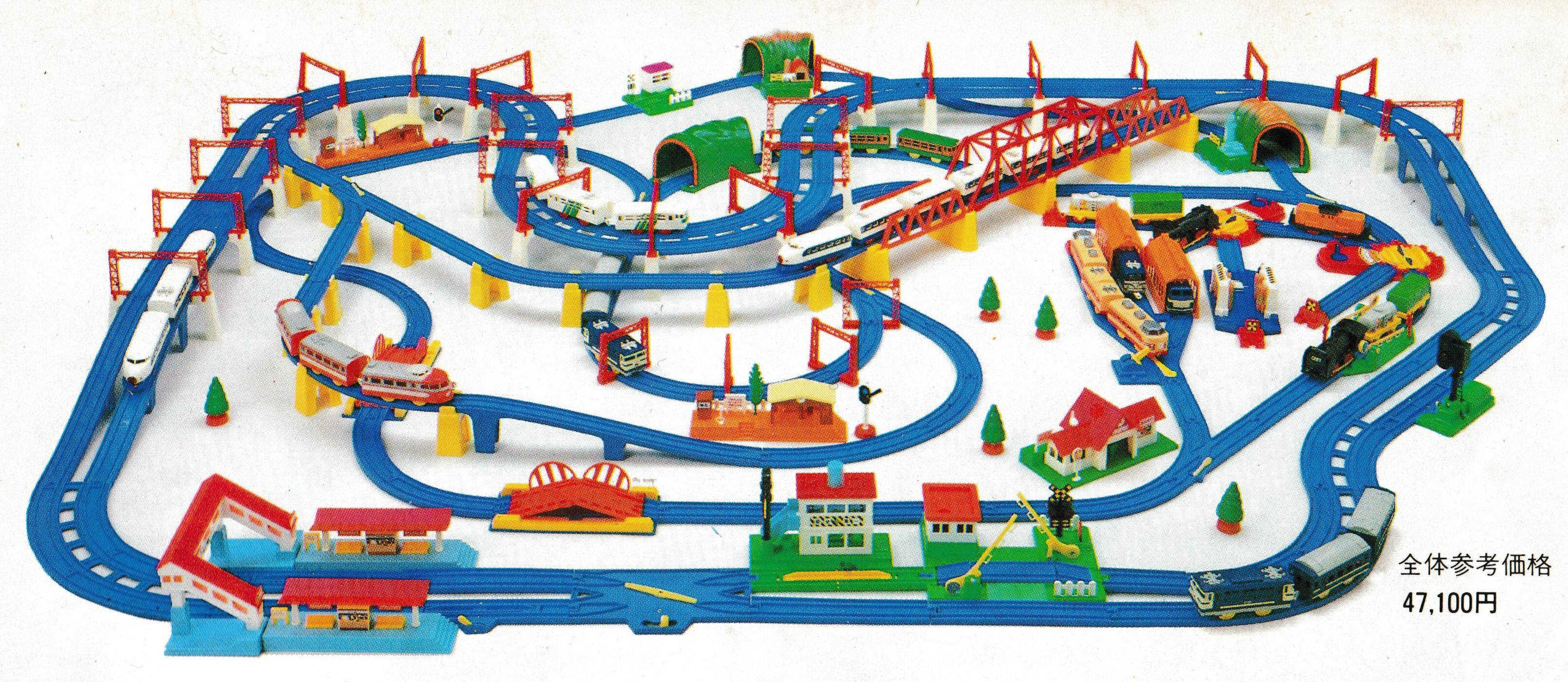
These old girders, in my opinion, look absolutely beautiful, especially when used in quantity and with catenaries as seen here in a page from the 1984 Plarail Catalogue.
Bridge Girder (1971-1979)
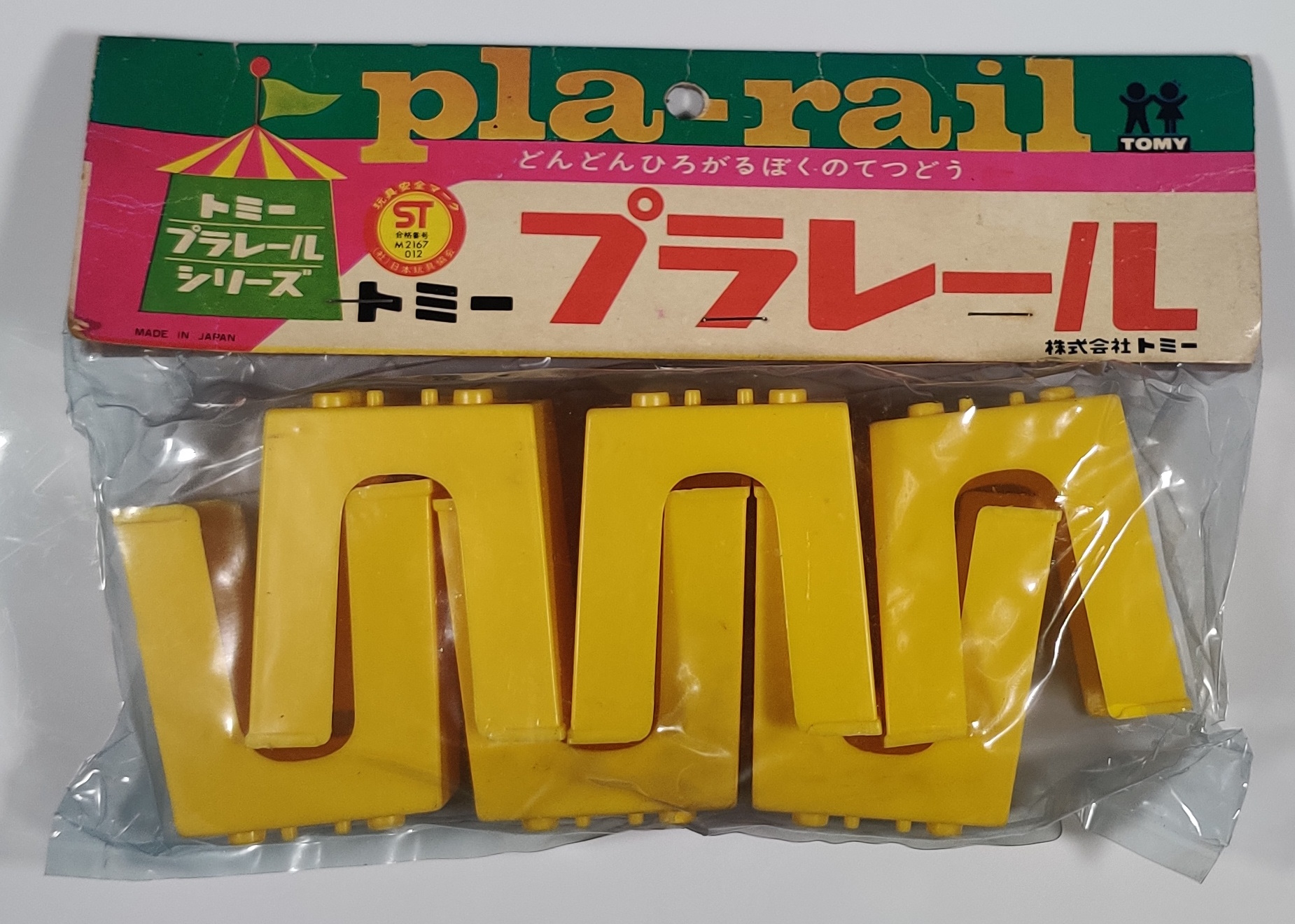
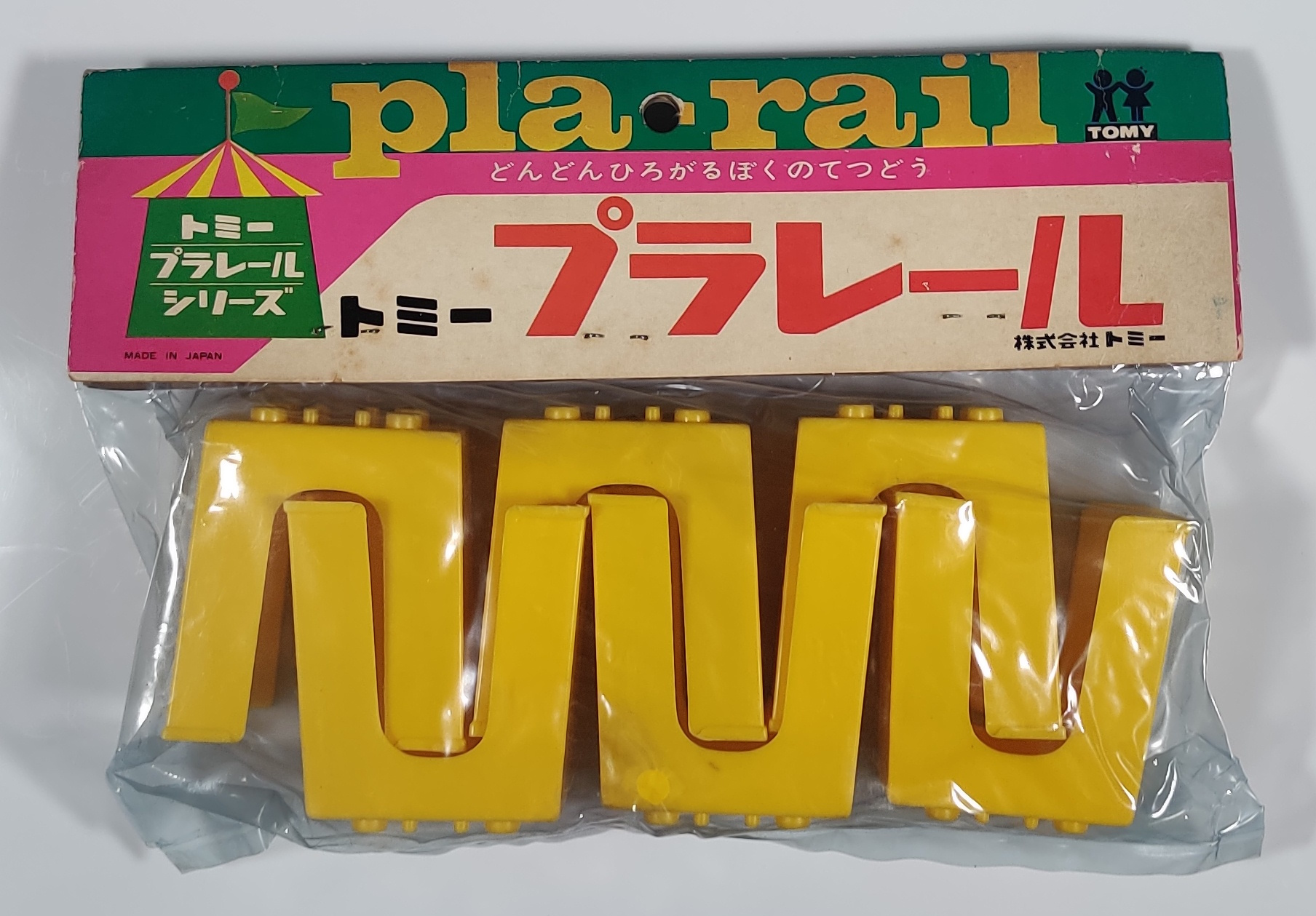
In 1971 the next generation of "standard" girder was released as Bridge Girders (はしげた), first in yellow plastic shown here in the early 70s "pla-rail" type packaging before changing to the orange shown below by 1974. The protruding lip at the bottom of the feet originally stopped before the upwards curve, and early orange girders were also produced this way, but by later 1974 or 1975 the ridge was changed to go slightly up the curve and then end.
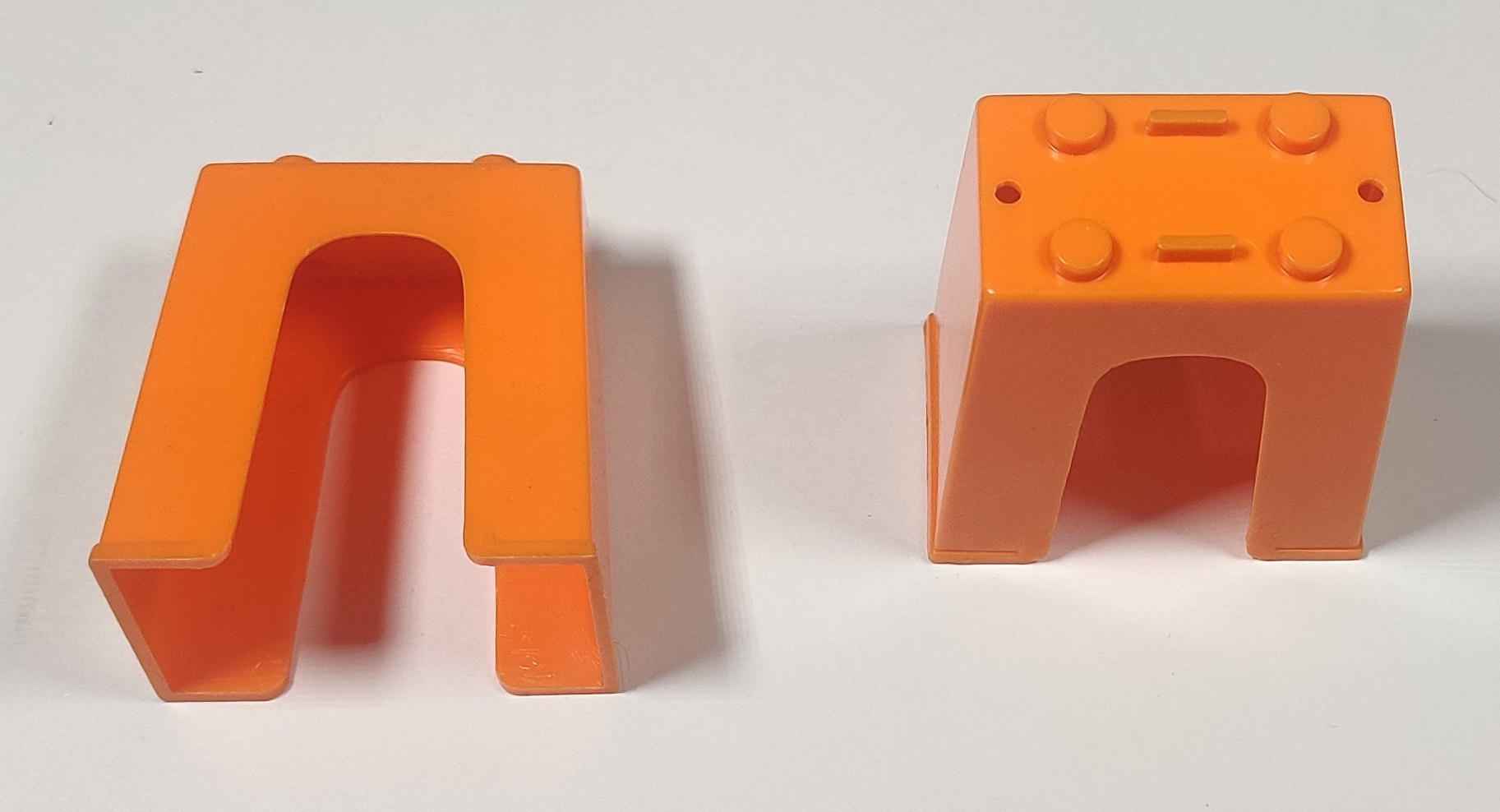
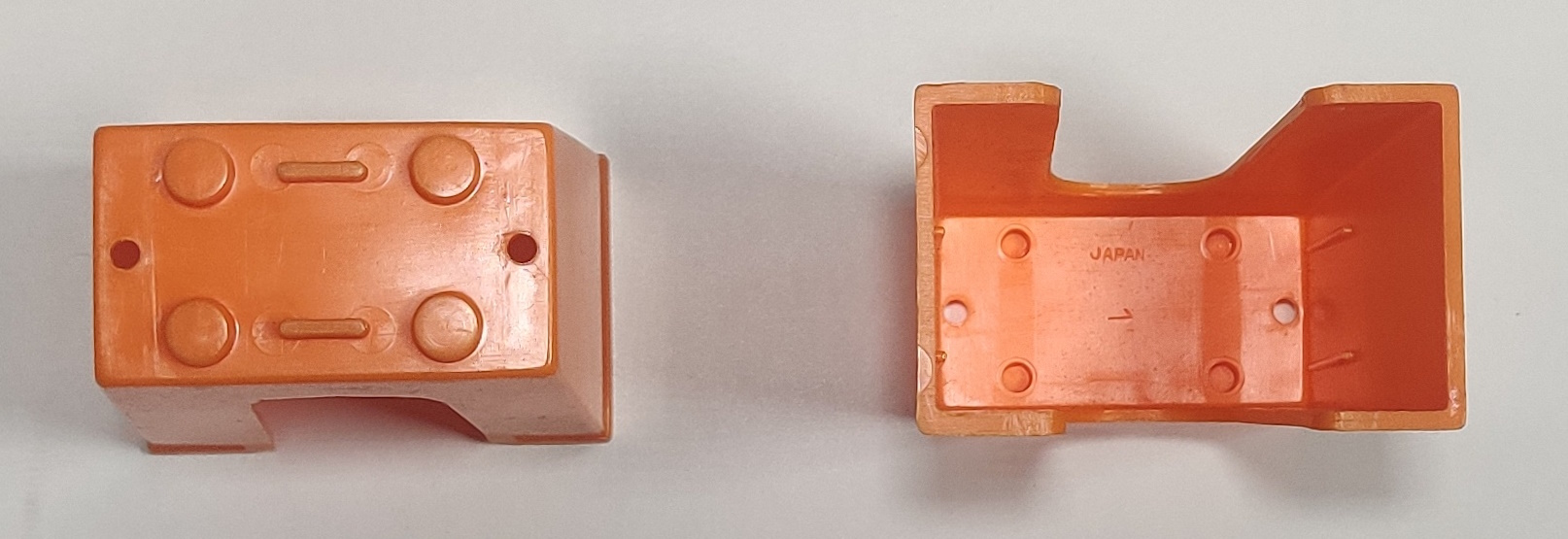
The raised circles fit into the bottom rail surface and the two raised ridges sit on either side of the rail joint connection, meaning the riser sits off-center from the apparent rail connection as the center of the actual molded plastic joint it is clipped around is biased inwards towards the concave connection. These girders lift rails approximately 60mm, which may be low enough to cause trains to hit elevated rails, particularly if these girders are used on carpet and sink in. Orange girders were at one point numbered 24 under the old accessory numbering scheme.
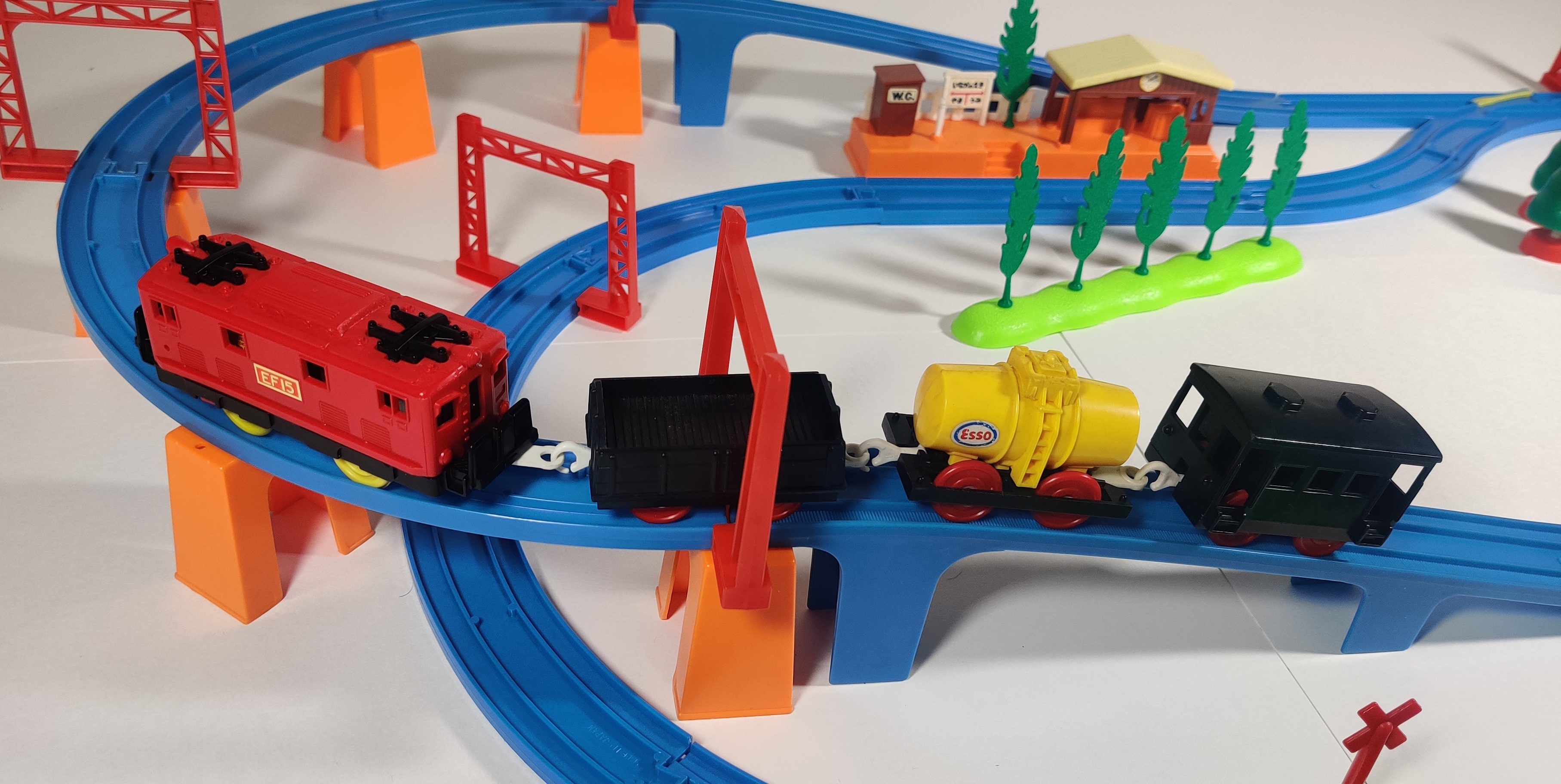
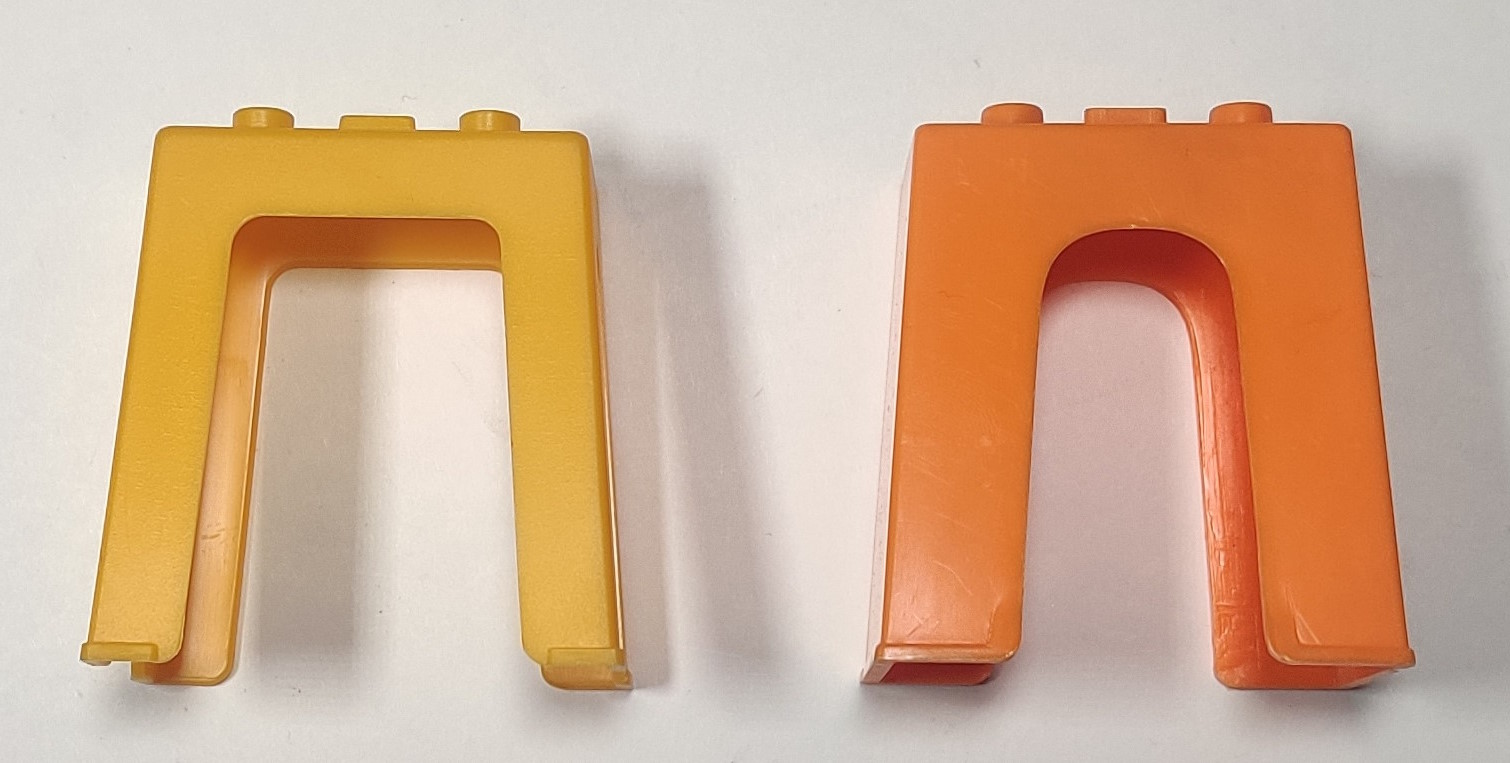
Because these girders do not stick up above the rail at all, electrical catenaries can be placed neatly on top, which often looks nice although they do stick out further to the sides. These bridge girders were used in sets and released individually in several packaging variations throughout the 1970s until being superseded by the "claw" or "clip" type J-13 Bridge Girders in 1979. Stelco produced a West German variant of the 1970s Bridge Girder for their larger Junior Express sets.
Bridge Support (1973)

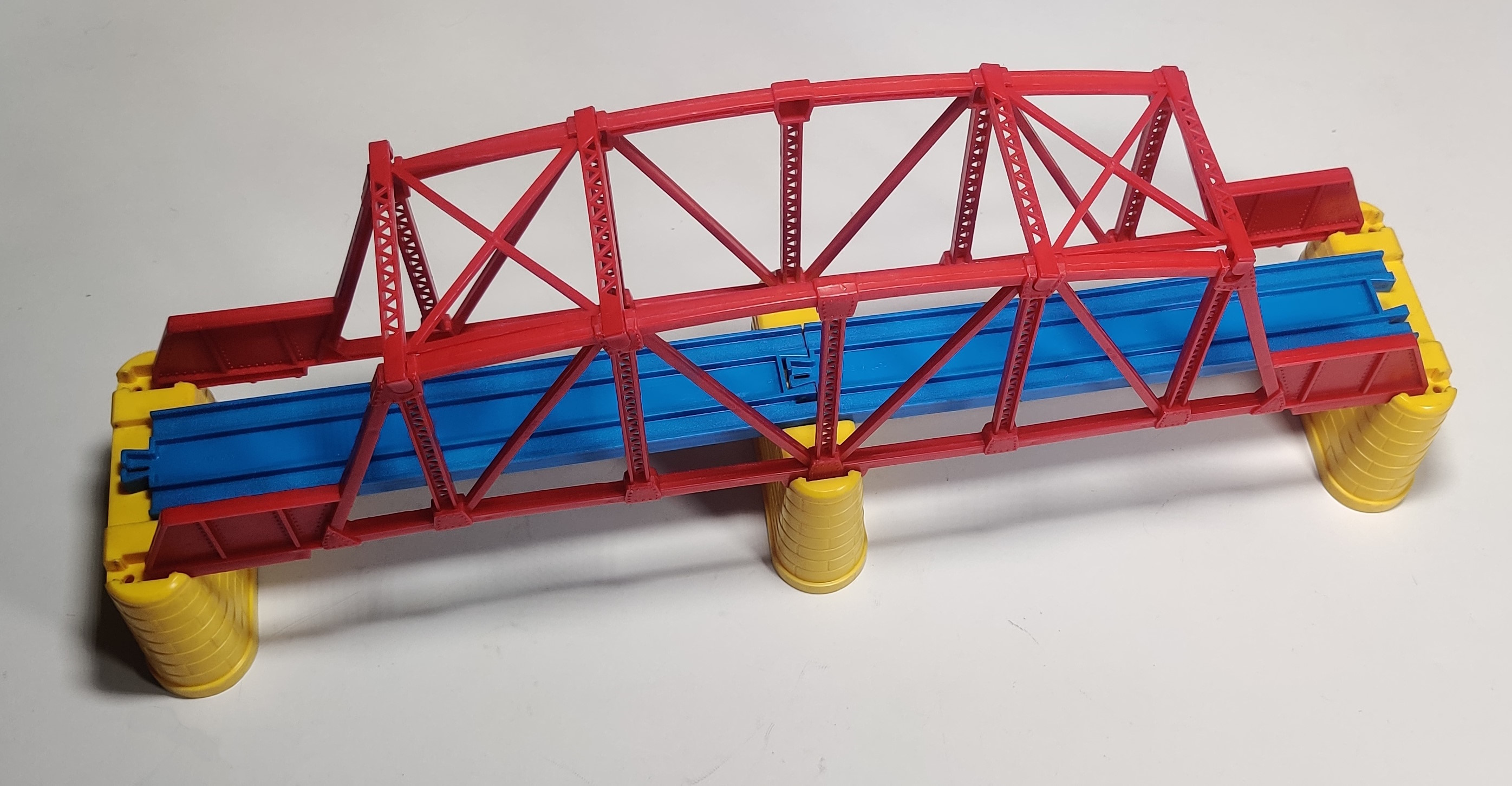
In 1973 alongside the Big Iron Bridge a new wide brick-patterned bridge support was introduced. This is a very nice looking support that continues to see use and is arguably the first "beautiful" Plarail bridge pier since the white 1960s type.
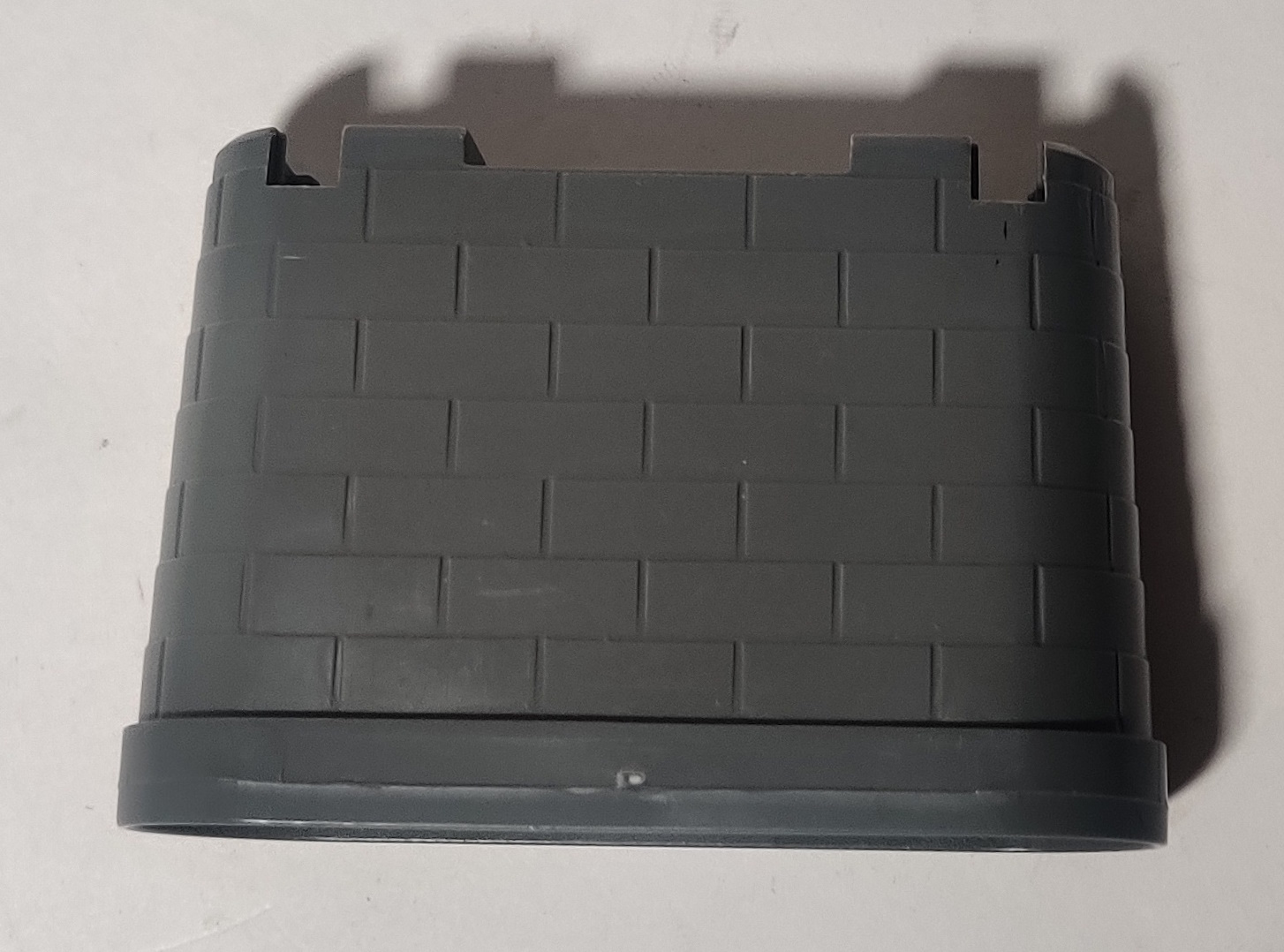
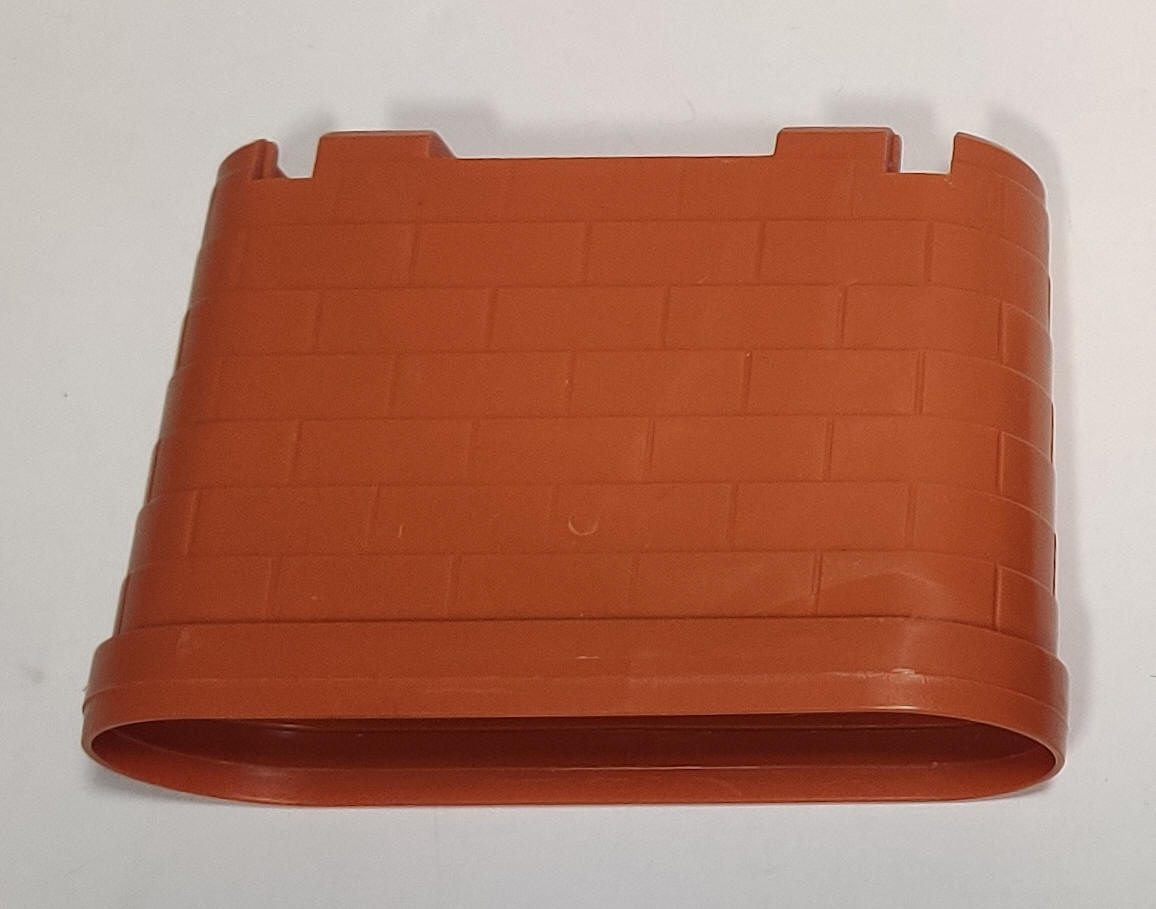
In the 2000s this style of support has been produced in a few different colors including a deeper reddish orange and grey.
Three-Dimensional Wall (1974-1976)
In a D-51 set in 1974 a series of thin orange stackable risers were produced that are the ancestor of the more modern Block Bridge Girder concept. In 1975 they were released individually before going out of production after 1976.
J-13 Bridge Girder (1979)
| <-- J-12 Pedestrian Crossing |
J-14 Block Bridge Girder --> J-14 "New" Block Bridge Girder --> |
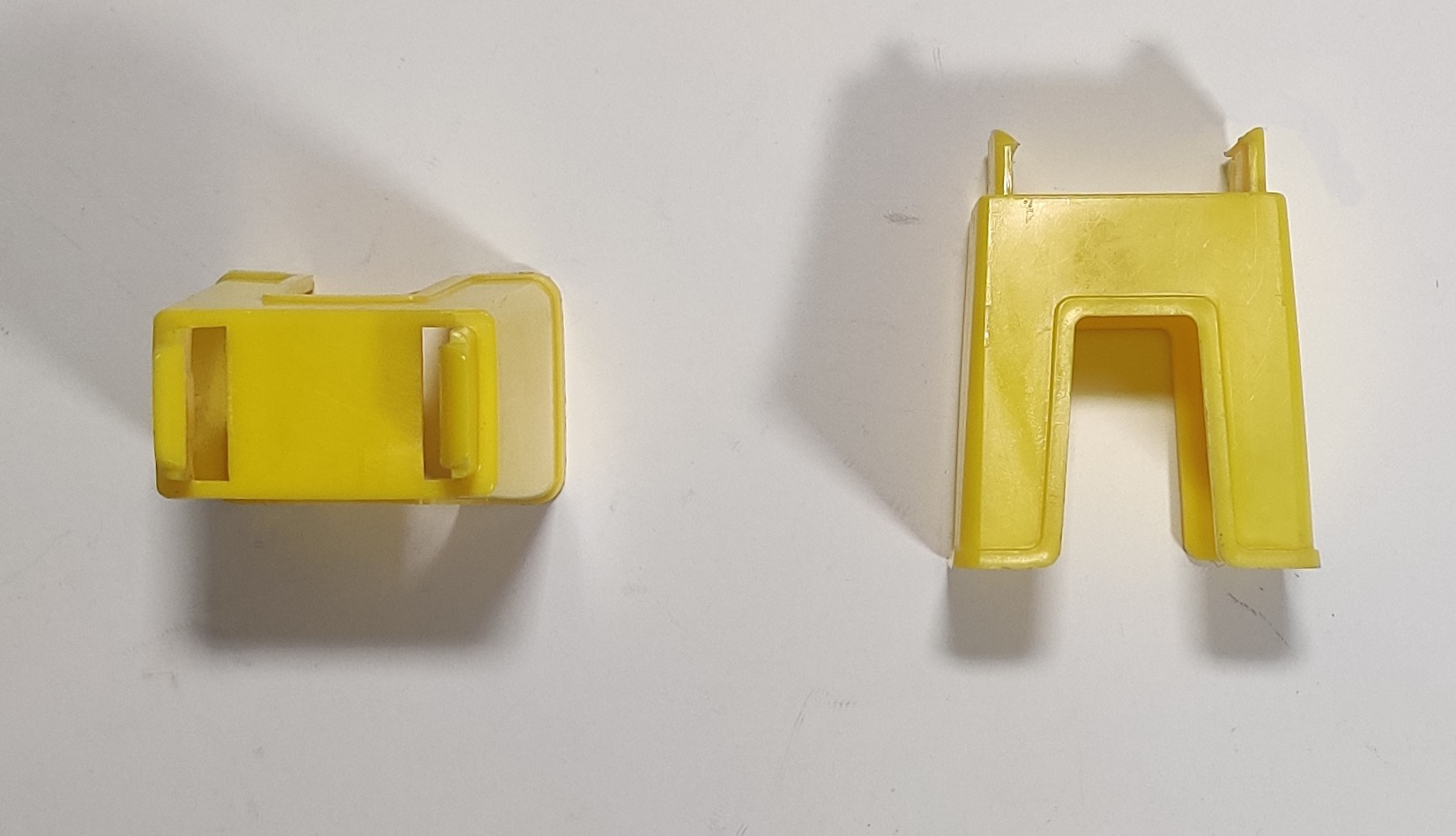
In 1979 a new "clip" or "claw" type of Bridge Girder (はしげた) was released that clipped around the side of the rail joint pretty securely. Like the previous early 70s clipless girders, these girders lift rails ~60mm, which may be low enough to cause trains to hit elevated rails particularly if these girders are used on carpet. They remained on sale into the early 1990s and were given the designation J-13 Bridge Girder (橋げた) in 1988.
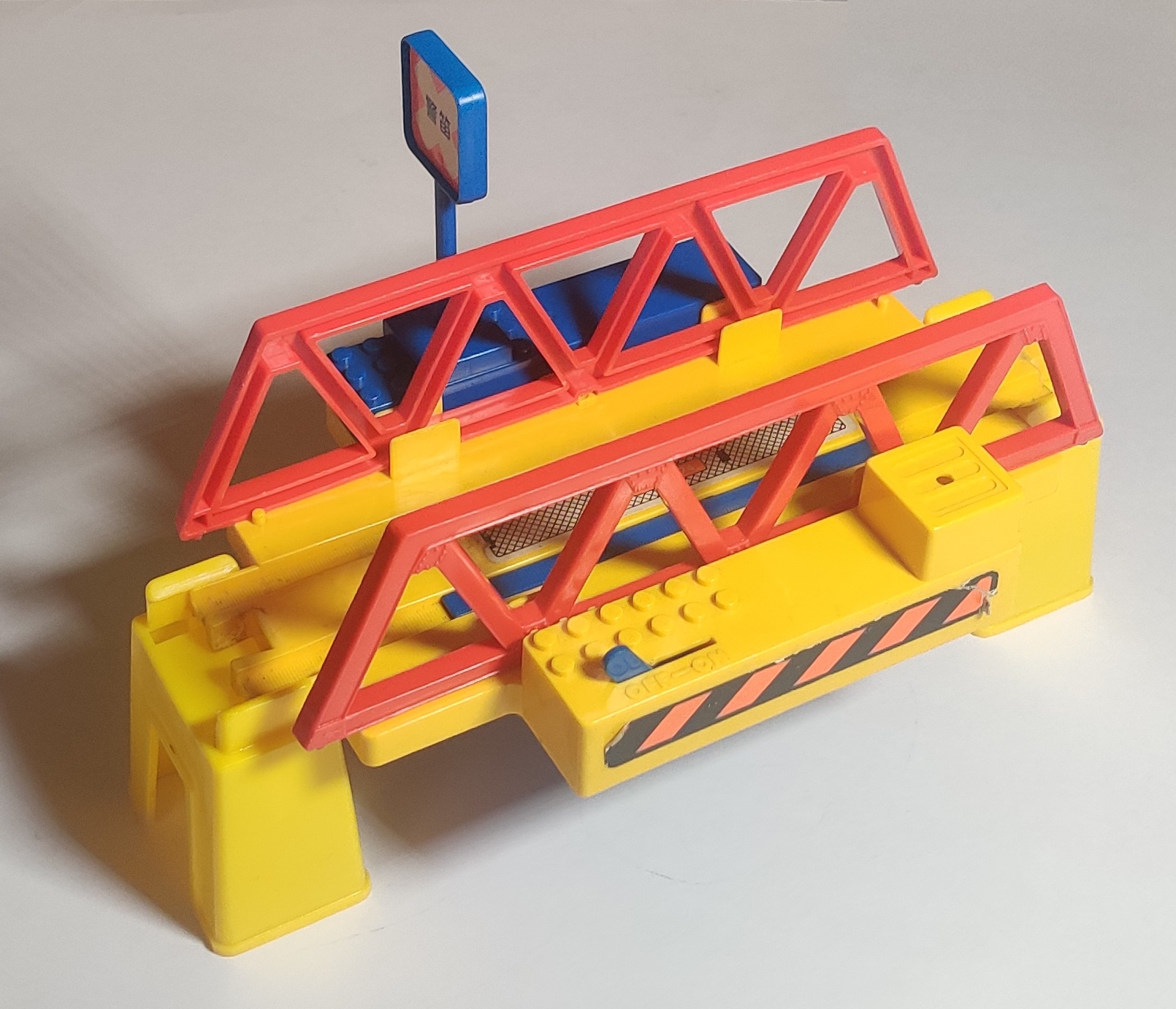
These supports are flat on top and can thus be used to connect to accessories and track pieces that do not necessarily have the underside track profile in their tooling. Some accessories such as the J-29 Horn Rail included some of these bridge girders.
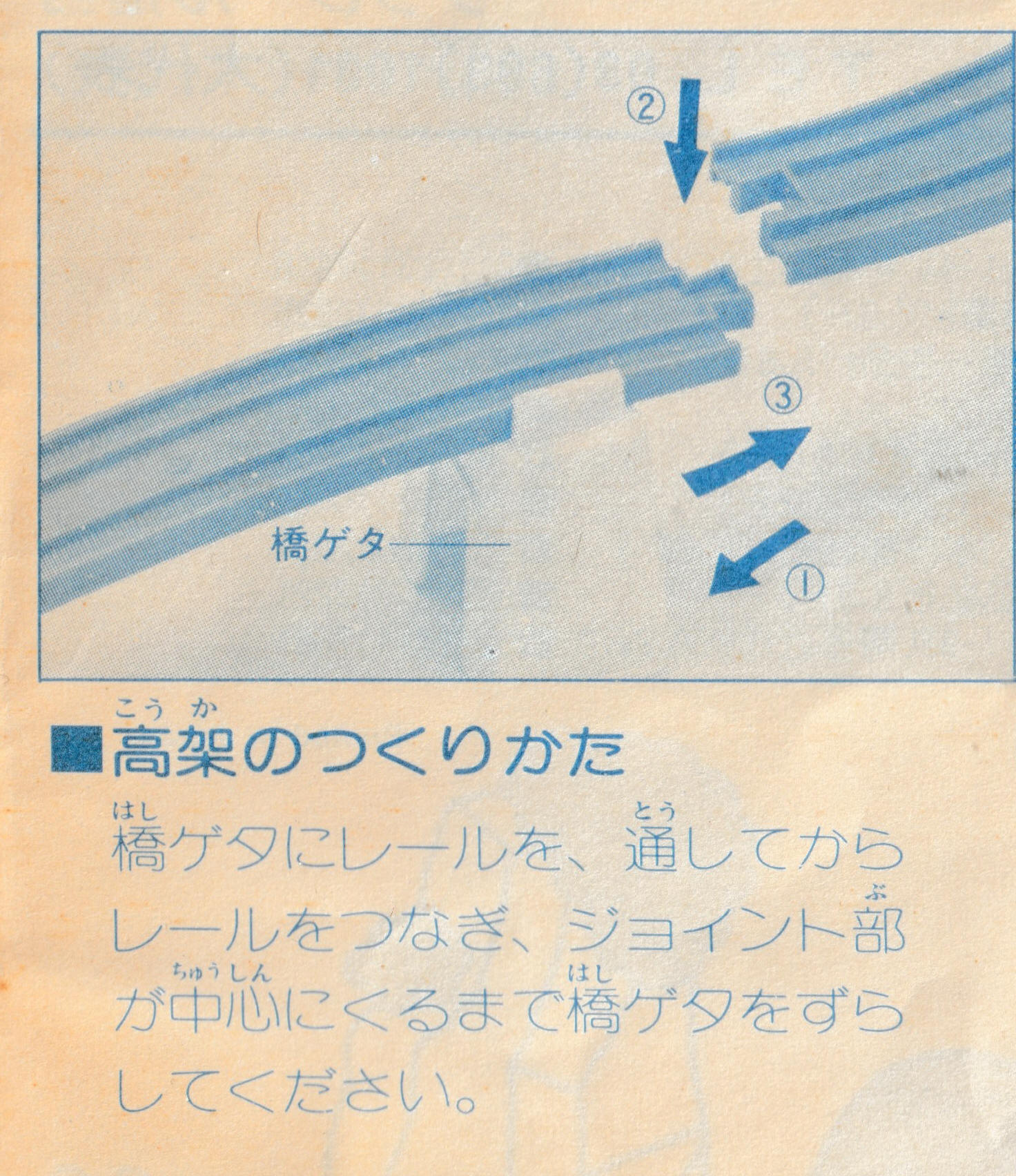
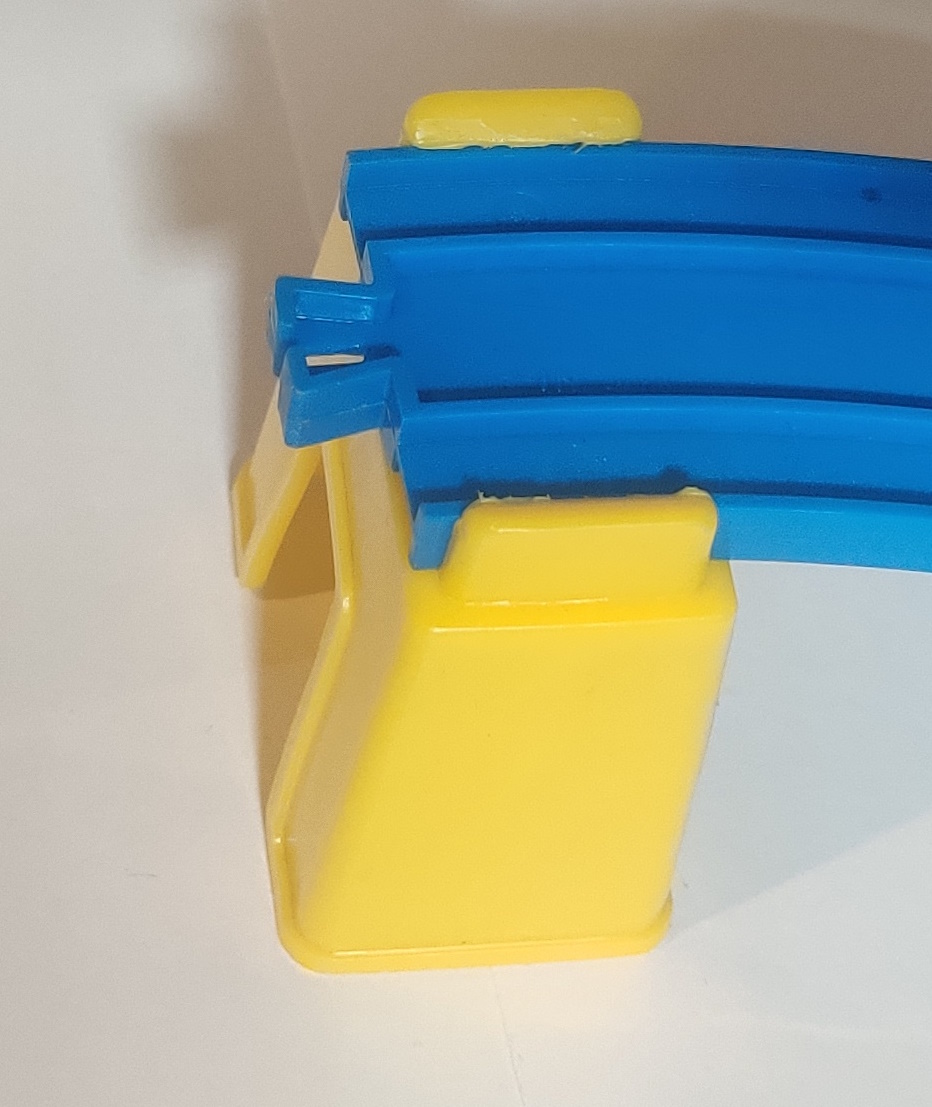
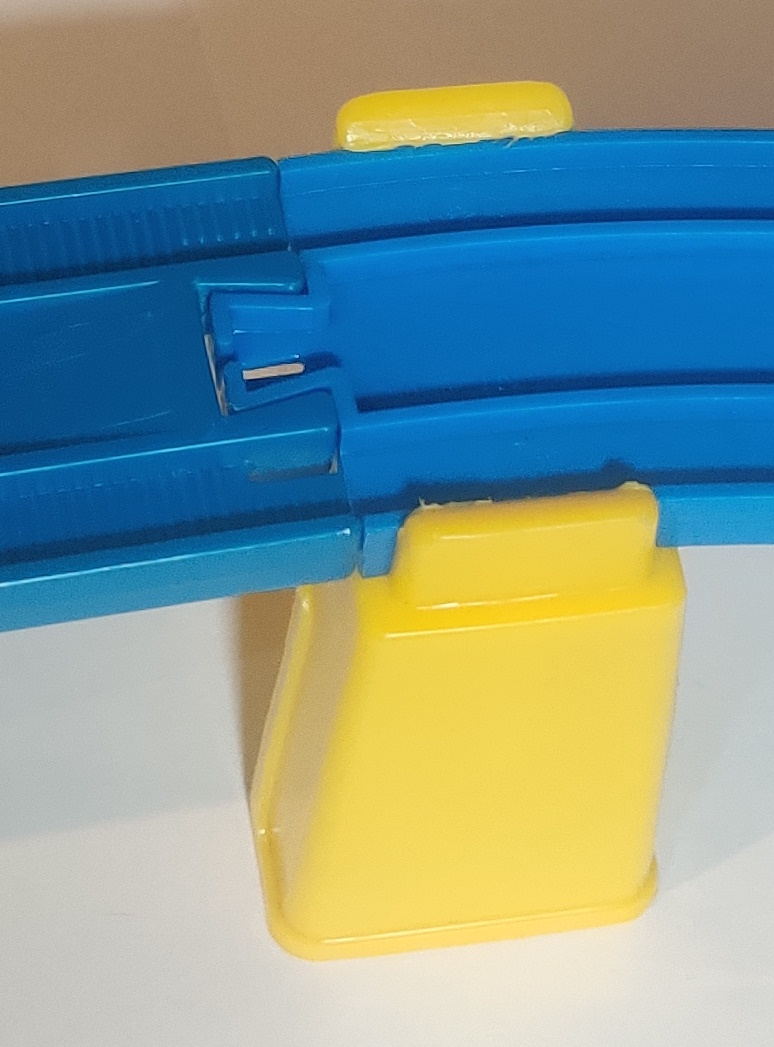
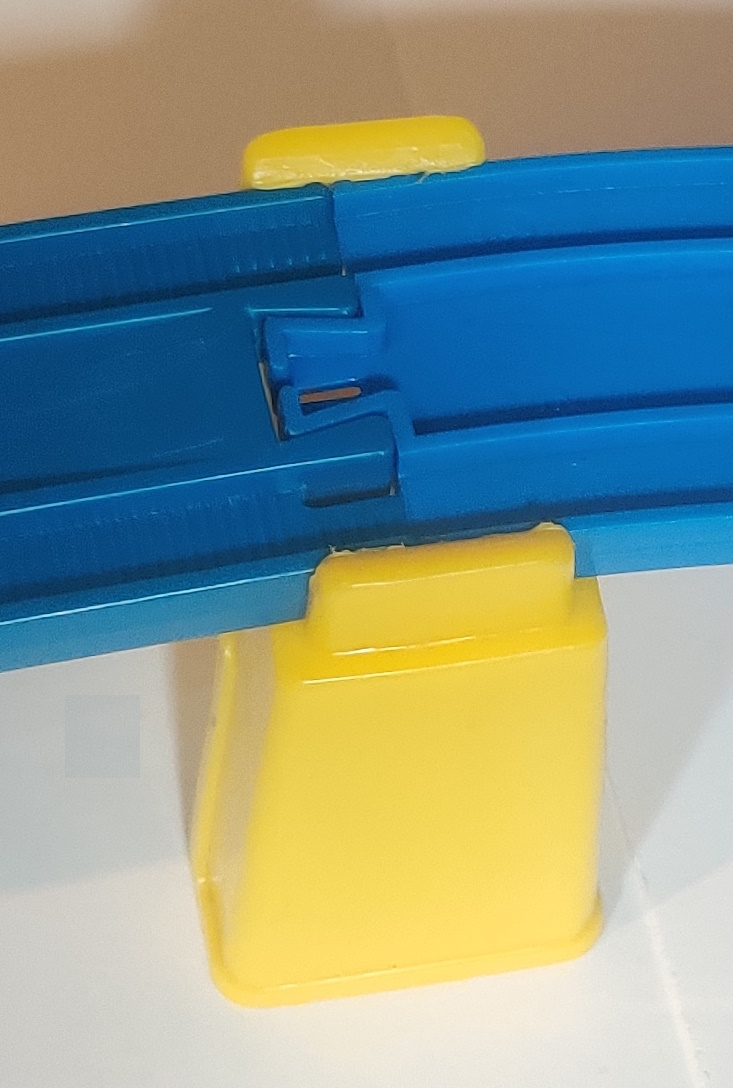
Because of the stiffness of the clips, instead of pushing a rail joint down into them it is usually much easier to use the girder by sliding the girder down one of the rails before they are attached, pressing the second rail down into place at the joint, and then sliding the girder back over the joint.
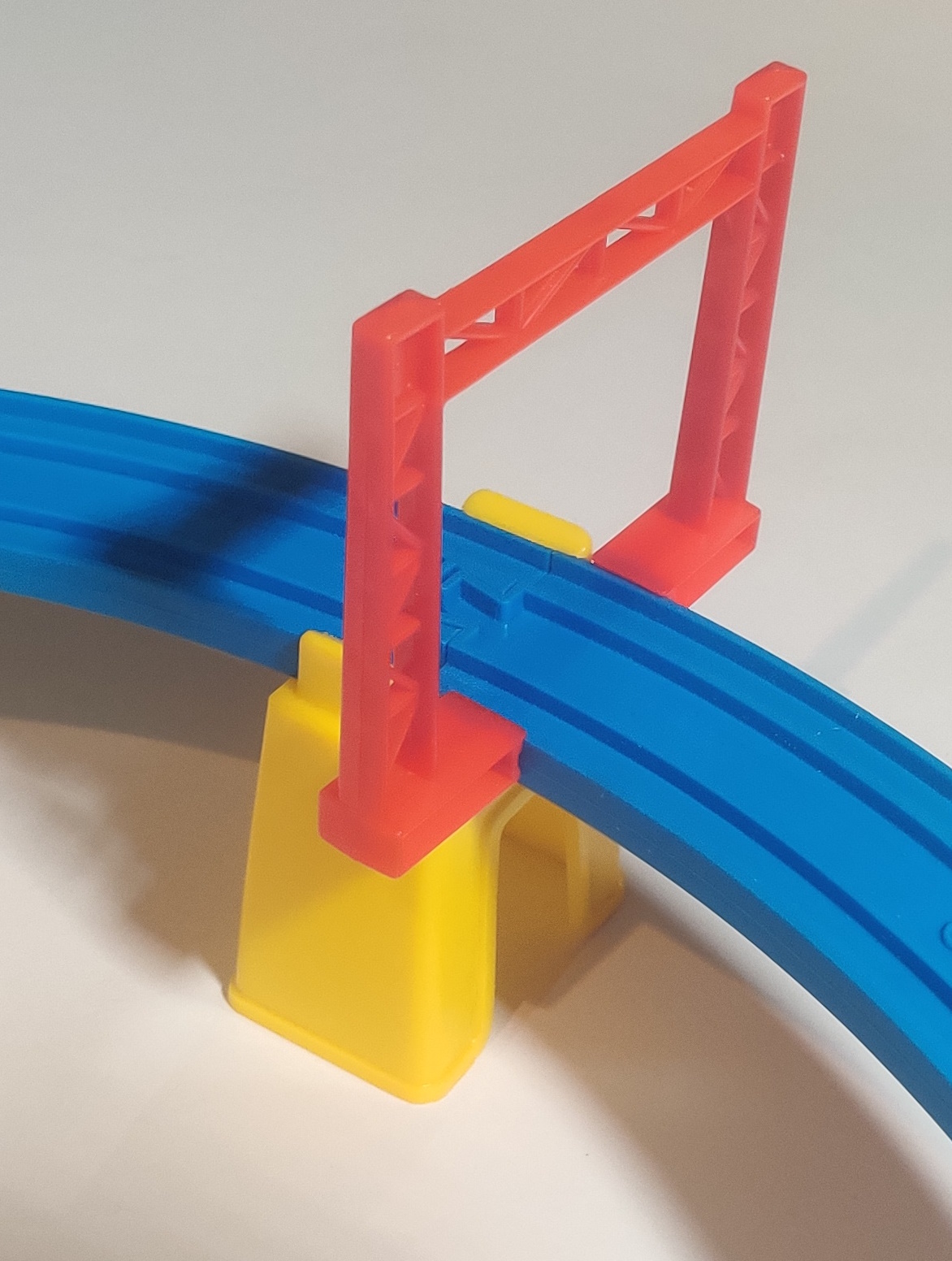
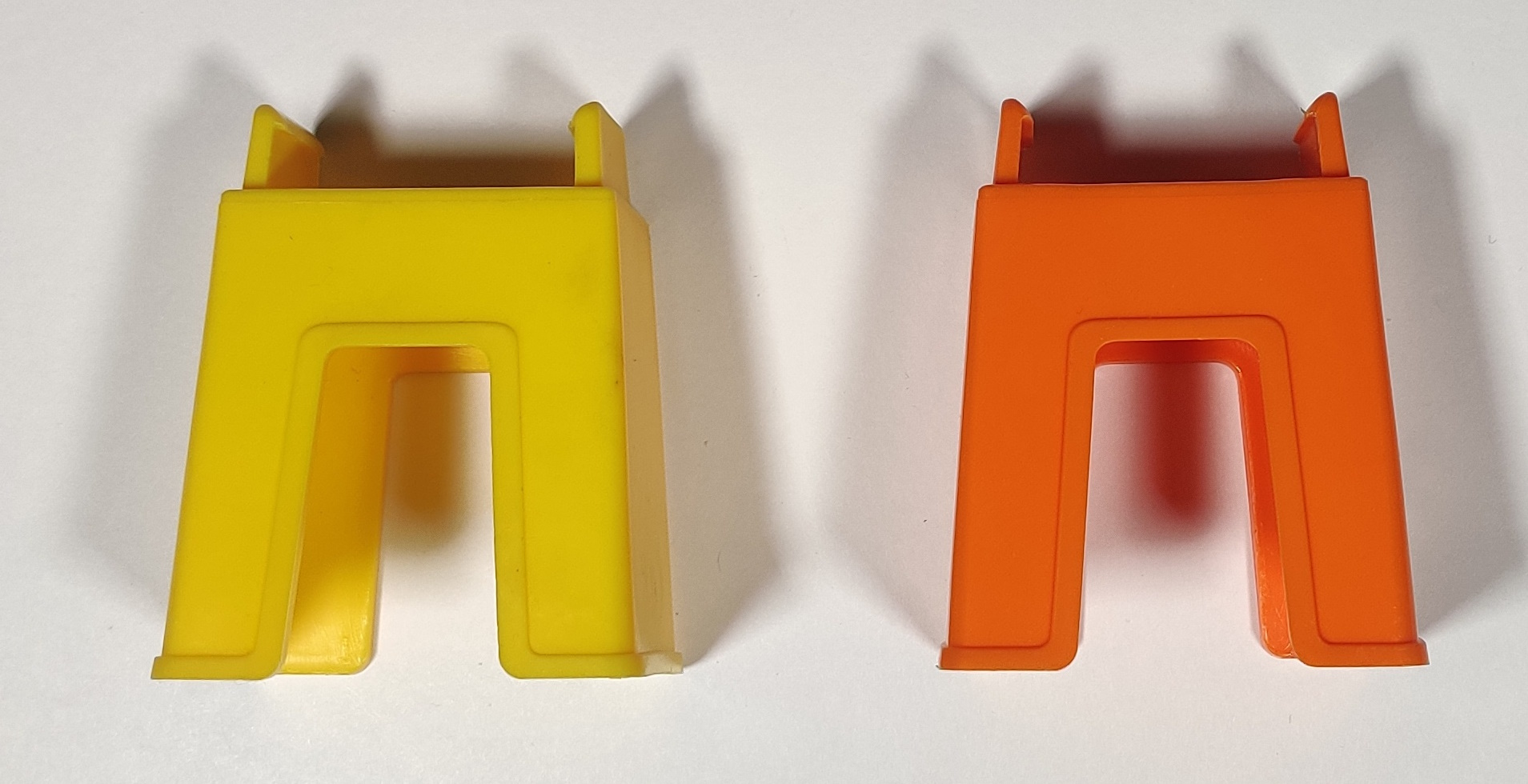
These bridge girders still work with electrical catenaries, but really the catenary itself is doing most of the work. As long as they aren't cracked or warped, you can place the catenaries freely around track and they will often stay there normally. An orange variant of these girders was used in the 1990 Mickey Poppo Set which also featured a unique color of rail.
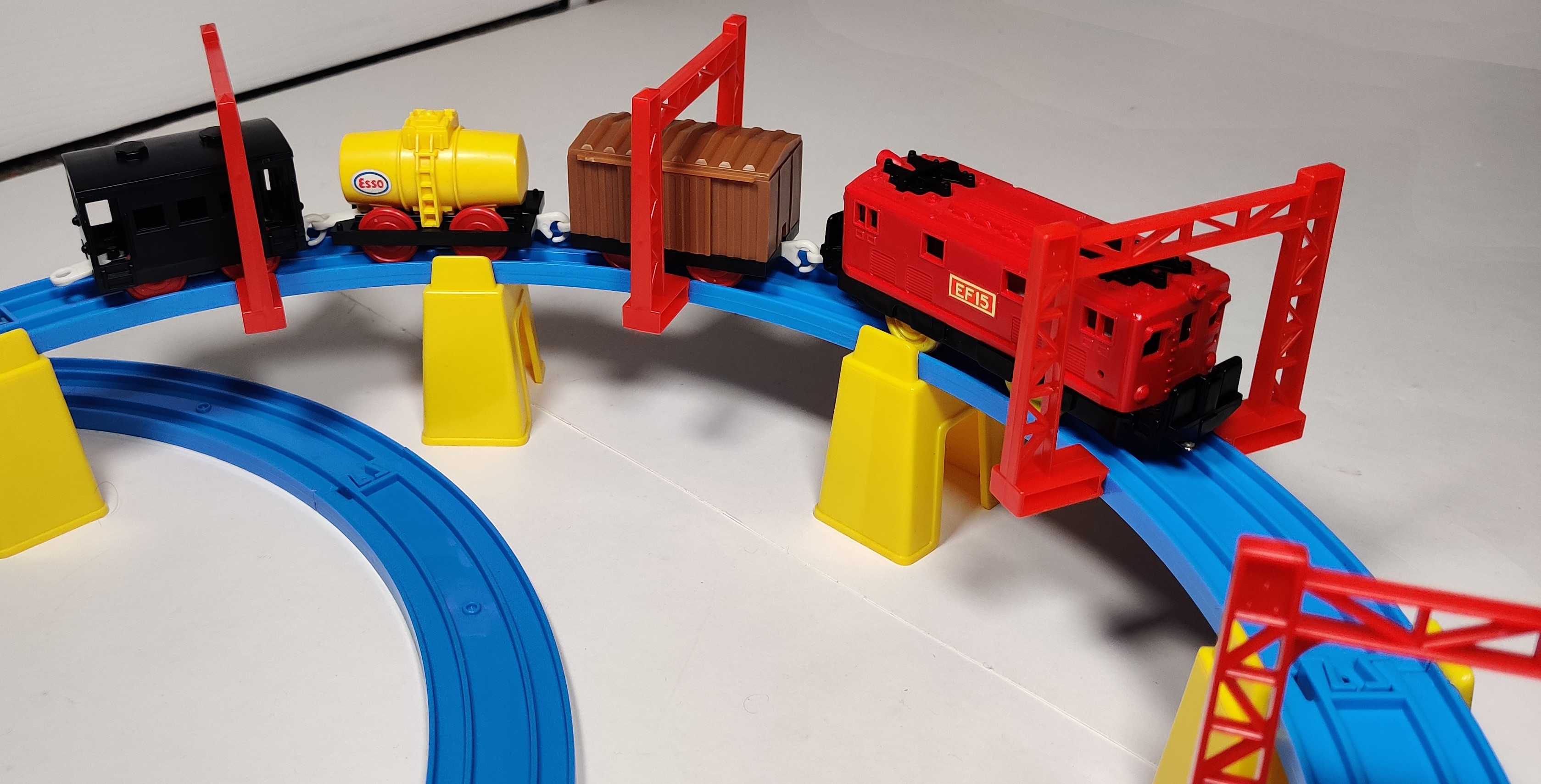
Like their predecessors, these bridge girders do still look rather nice in a longer raised section. Even though the J-14 Block Bridge Girder was released in 1984 this style of bridge girder remained on sale alongside it until around 1992. A handful of sets later in its life continued to use this style of bridge girder, but this seems to have ended with the Mickey Poppo variant in 1990.
Bridge Base (1983)
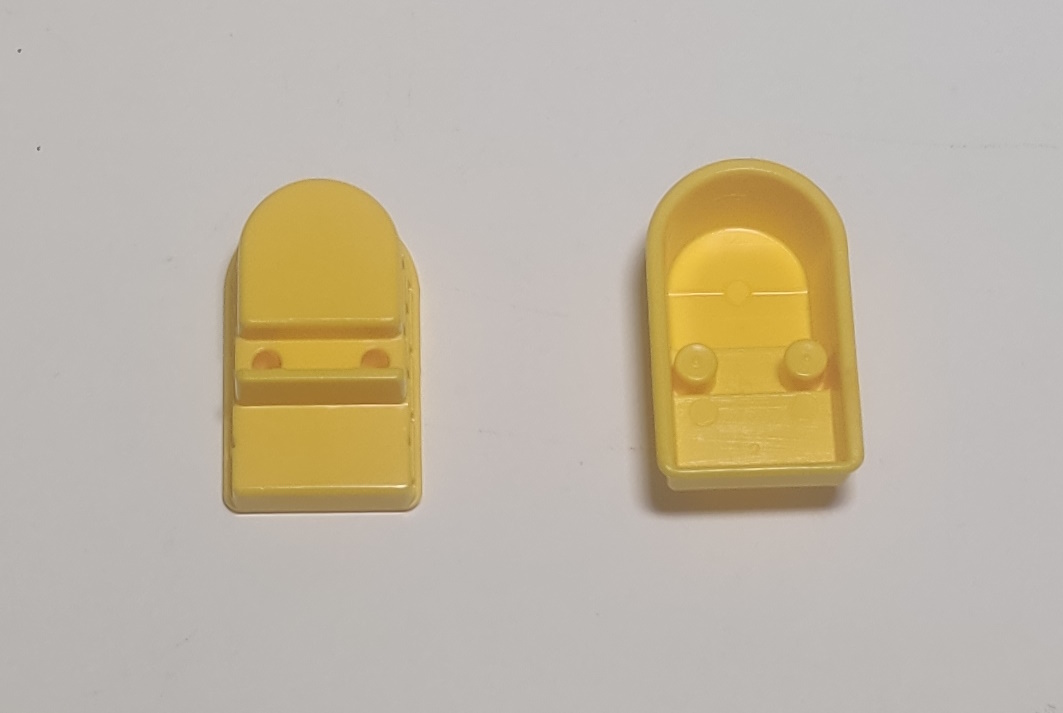
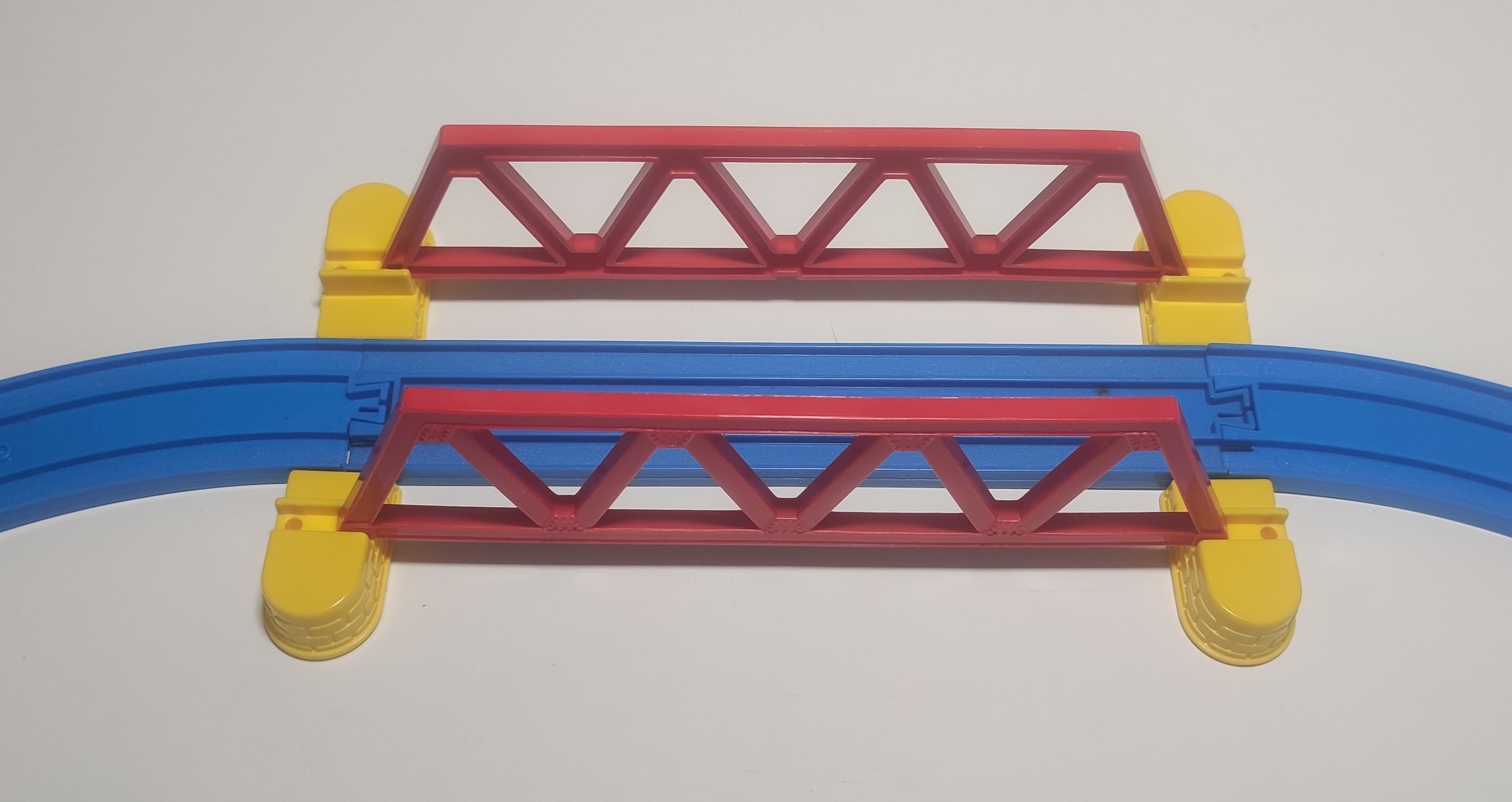
First produced in Japan in orange in 1983-1984 for the Melody D51 and Family Travel Salon Car sets and later in yellow in Thailand for the 1989 First Set. These allow a standard iron bridge to be placed directly trackside without being elevated further.
Elevated Rail Girder (1983)
Used first in an entirely elevated Hikari with Light set in 1983 to commemorate 20 years of the Shinkansen, the 1980s elevated rail system which was used again in 1997 had a special girder with two round accessory slots to hold single overhead wire poles and an integrated "bean" to connect the double-concave track sections. When the new elevated rail system was developed in the late 1990s it worked with regular (at the time grey versions of the "New" block girder but backwards-compatible) block bridge girders as well as the J-22 Double Track Block Bridge Girder.
J-14 Block Bridge Girder (1984)
|
<-- J-13 Bridge Girder <-- J-13 Cross Drawbridge |
J-15 Double Track Bridge Girder --> J-15 Mini Bridge Pier --> |
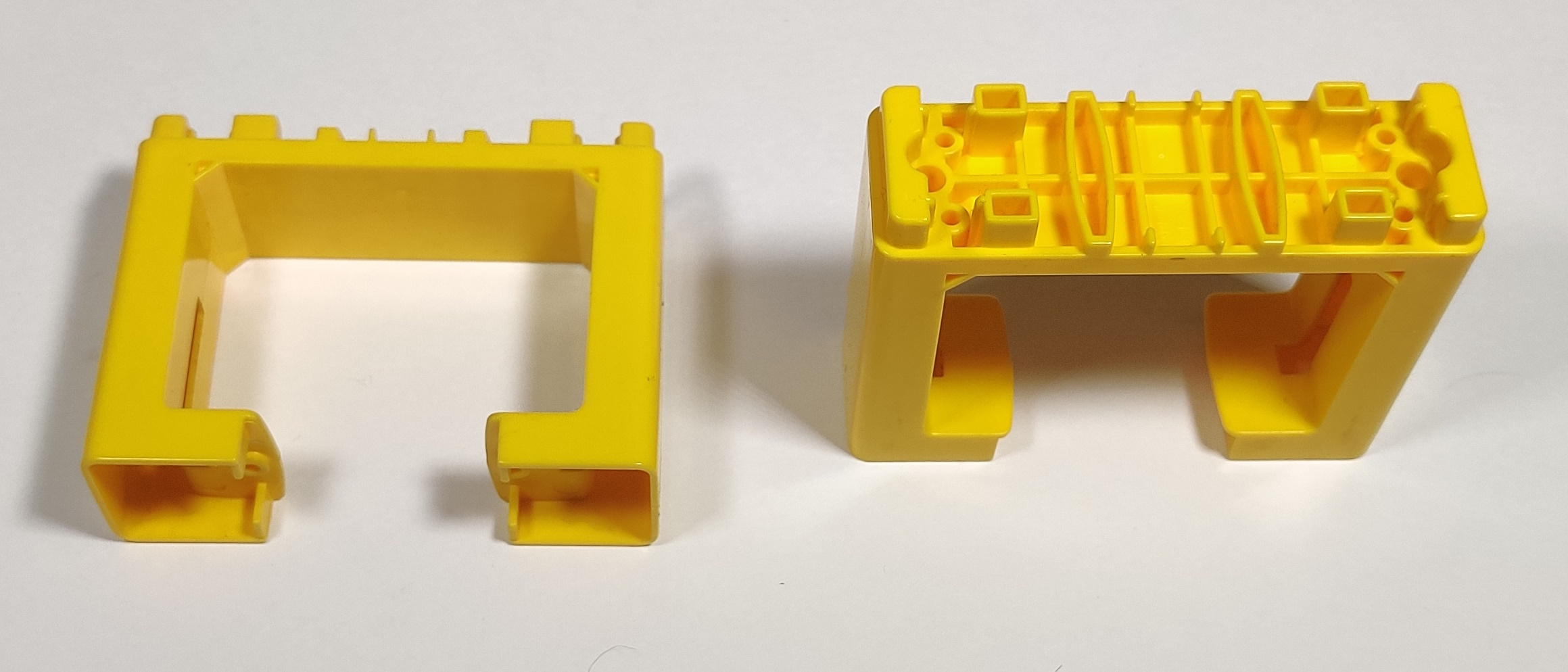
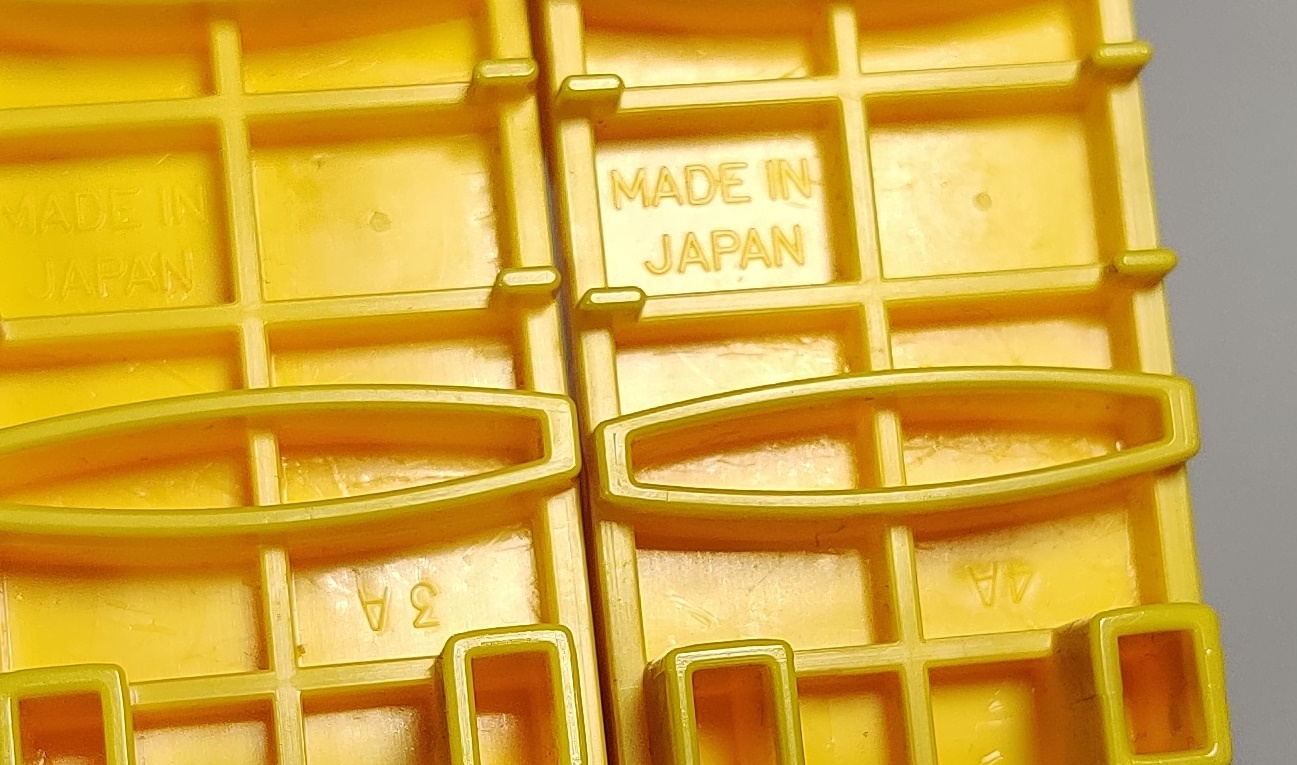
In 1984 a new stacking style of Block Bridge Girder (ブロック橋げた) was produced that would open drastically new ways to play with Plarail. The Block Bridge Girder was compatible with many Plarail rails and accessories, with a secure stacking mechanism that also clamps down on the top edge of rails to keep track securely fitted inside large towers. Future stations, rail, and accessories expanded out the usefulness of the block pier system. Block piers raise Plarail rails approximately 65mm.
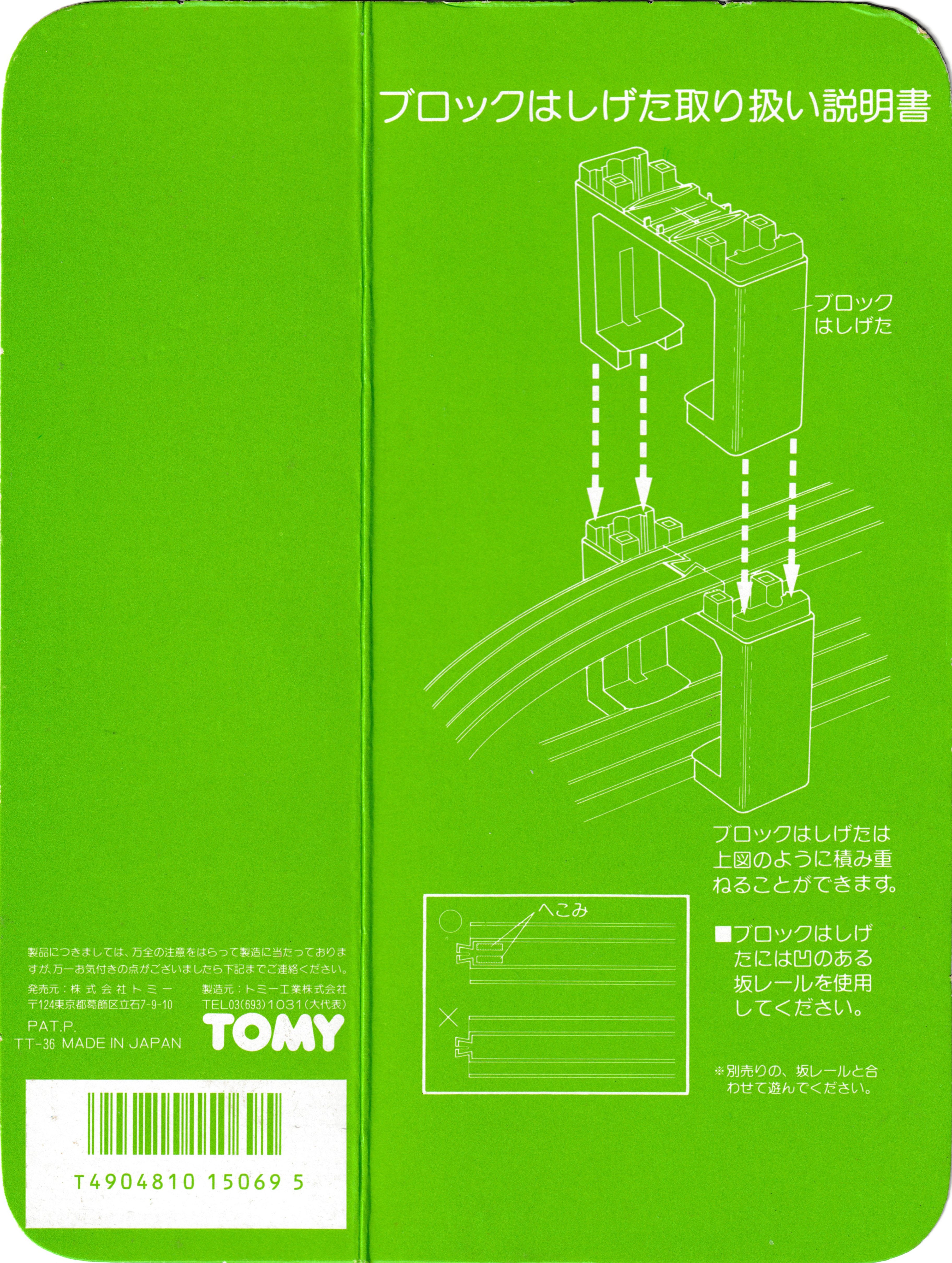
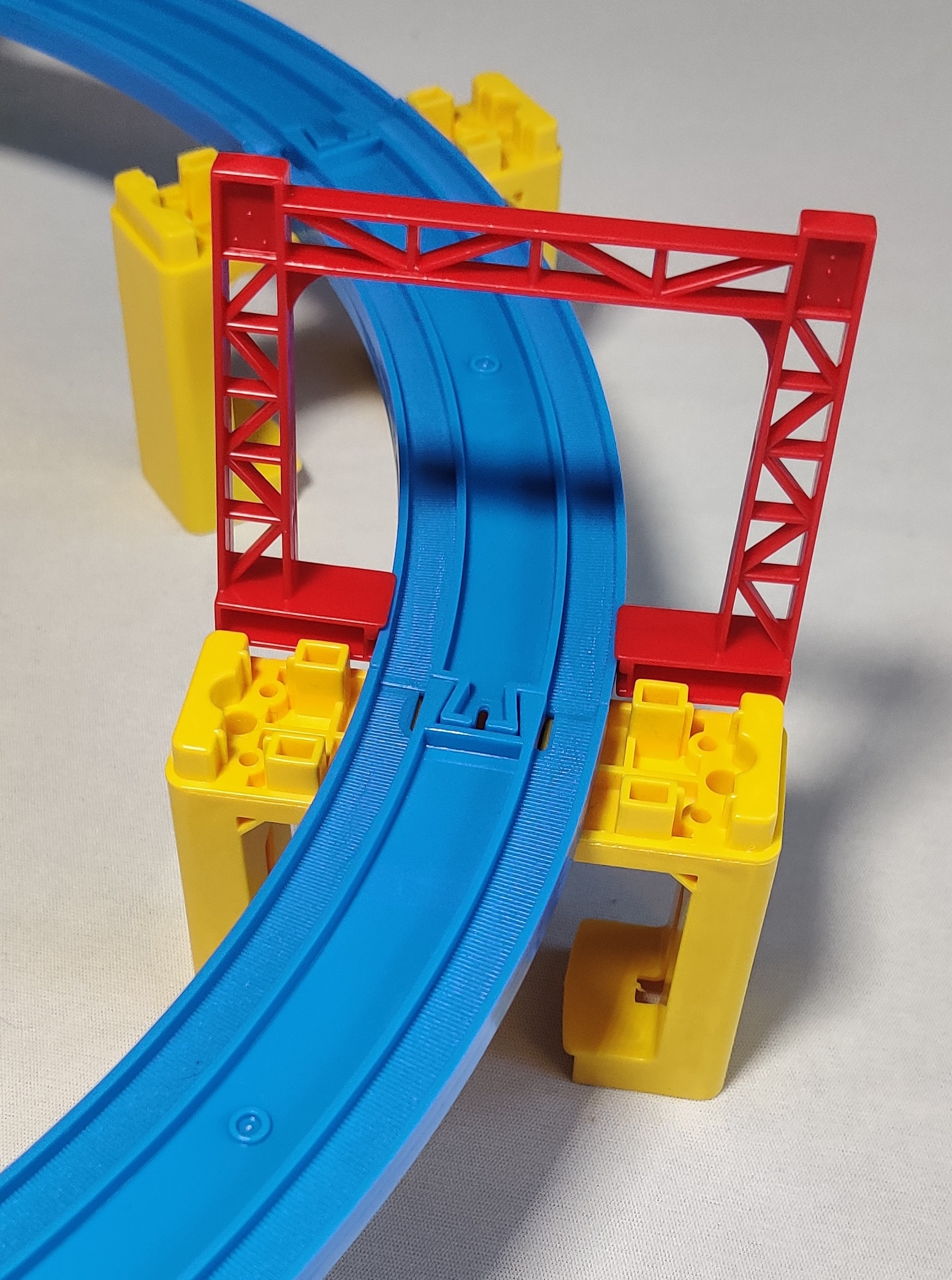
The cardboard backing included with individual six-pack releases show how to stack the block girders as well as a note about Slope Rails with updated slots in the tooling. Various holes and slots on the top of the riser allow for iron bridges, single overhead wires, and more into them. From their introduction in 1984 through at least 1988 the outer bump of the top connection points was a solid wall and could not fit a standard centenary, requiring they be placed to one side like previous designs.
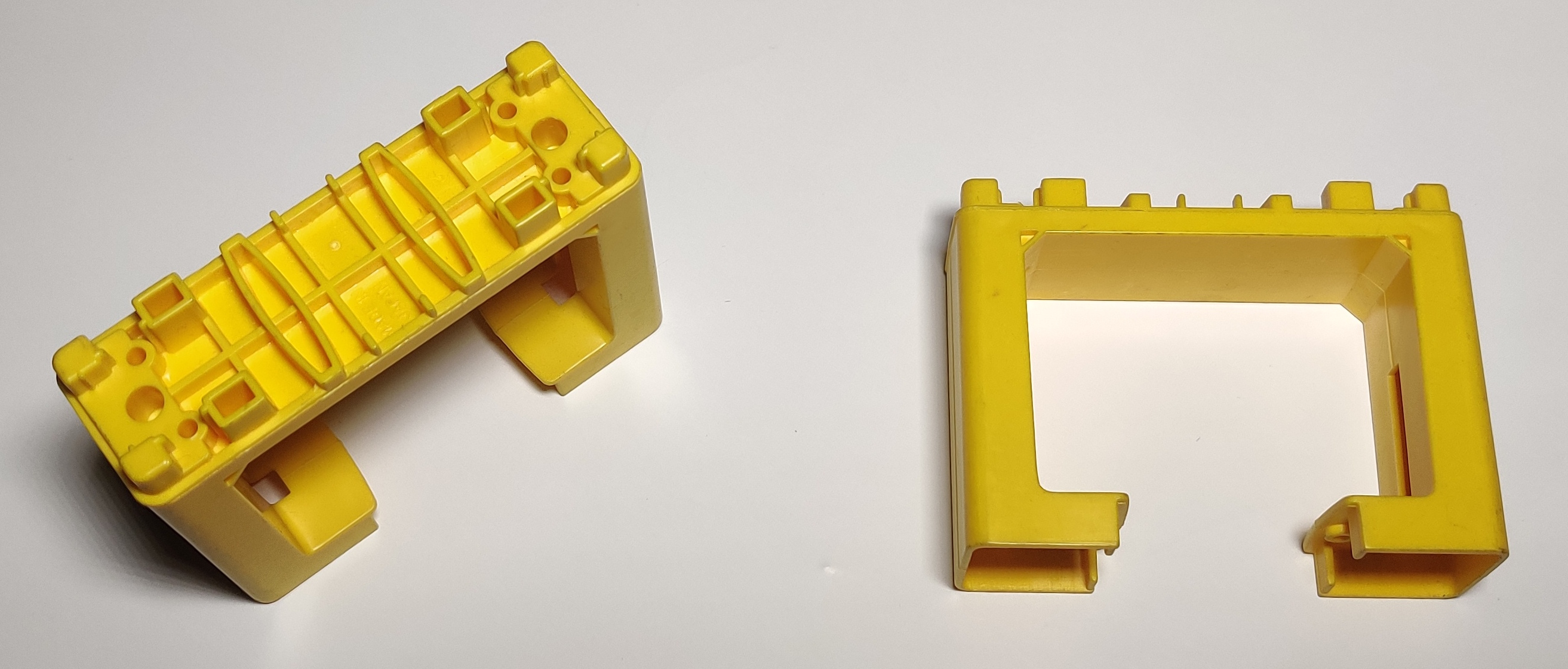
In the later 1980s the Japan tooling was changed to include the cutout in the outer wall to allow for catenaries. This was carried forward when Thailand production began around 1989 or 1990.
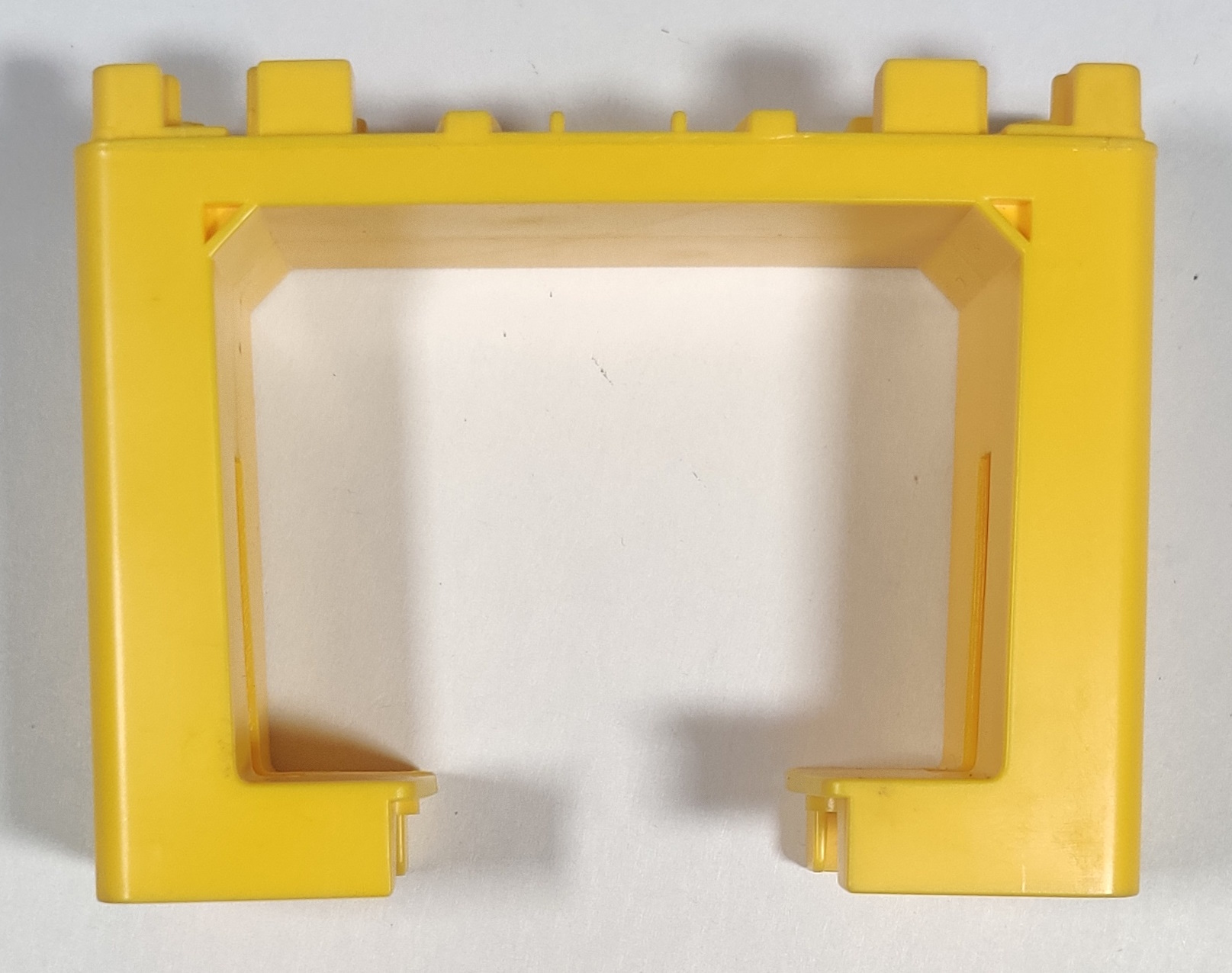
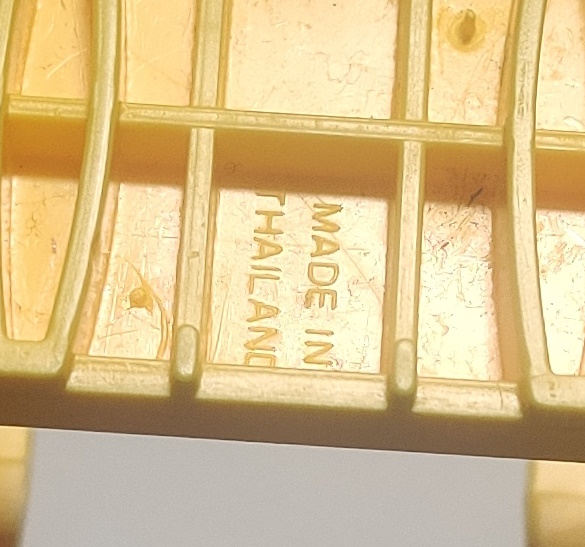
These piers were produced into the mid-late 1990s before being replaced by the "New" Block Bridge Girder which had more rounded corners to allow more trains to pass through tight spaces in elevated setups. Very early examples do not have the open triangles in the corners of the archway.
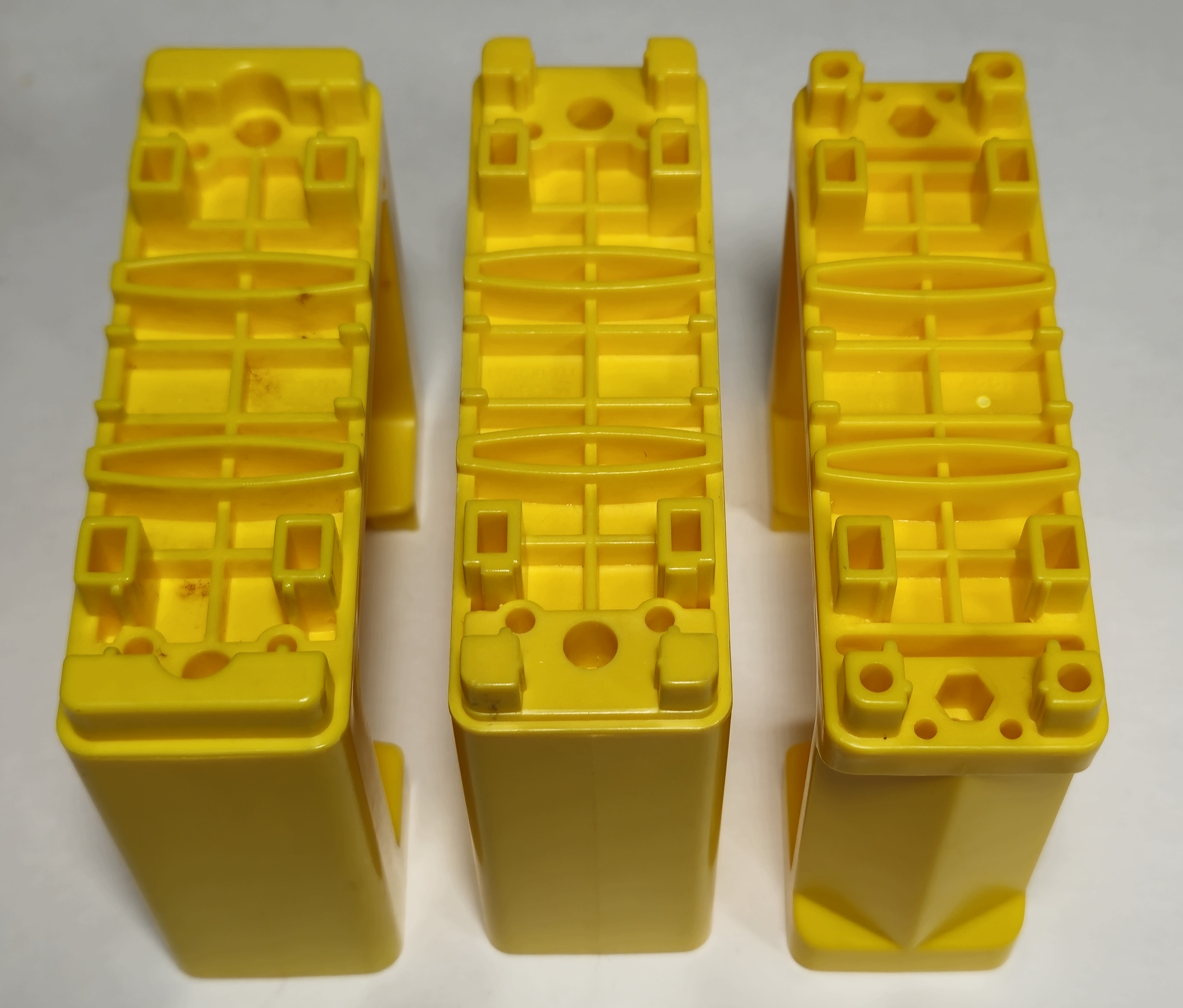
The original connection point with solid outer wall from the early releases, the updated tooling that accommodates catenaries more easily, and the later "new" type.
J-15 Mini Bridge Pier (1987/2001)
| <-- J-14 Block Bridge Girder |
J-16 City
Station --> J-16 Double Track Railroad Crossing --> |
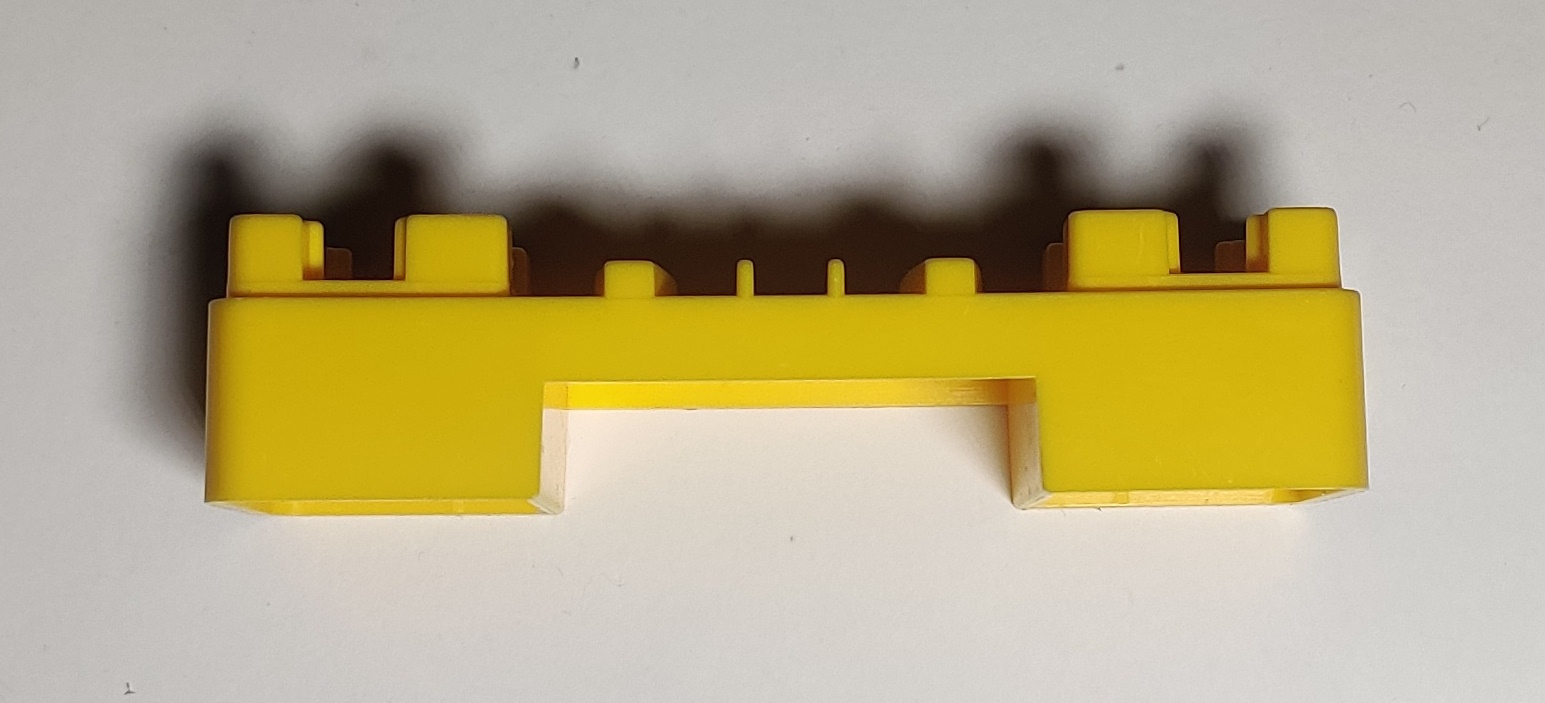
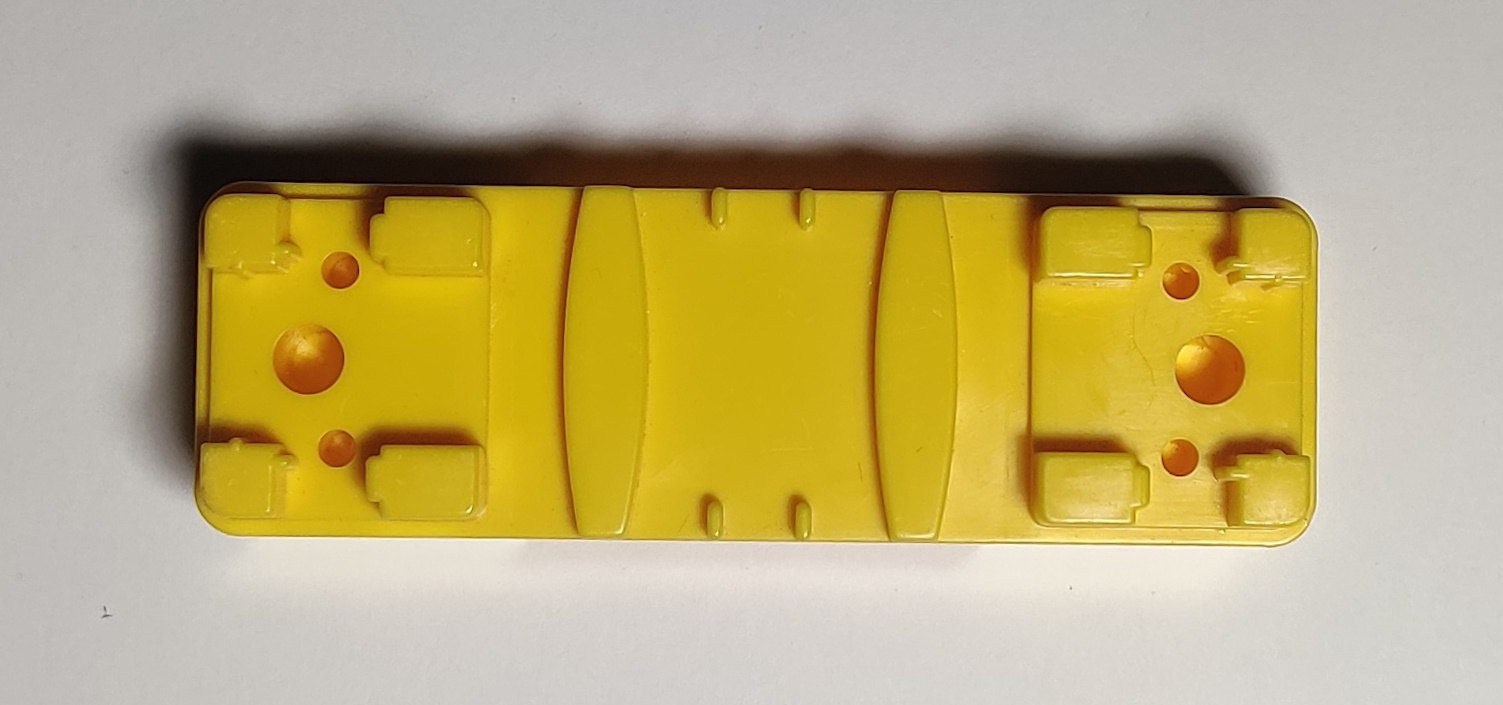
The "Mini" Bridge Piers (ミニ橋げた) are intermediate stacking piers that work with the J-14 Block Bridge Girder system. They measure approximately 1/4 of the height of a full girder, meaning four can be stacked to reach a regular block girder (or other bridge girder) height. They feature similar accessory compatibility as regular block girders because the connection portion is largely the same. Note the additional extended cutout in the outer wall - this change would also appear on later Block Bridge Girders and, of course, was carried forward for the "New" girder.
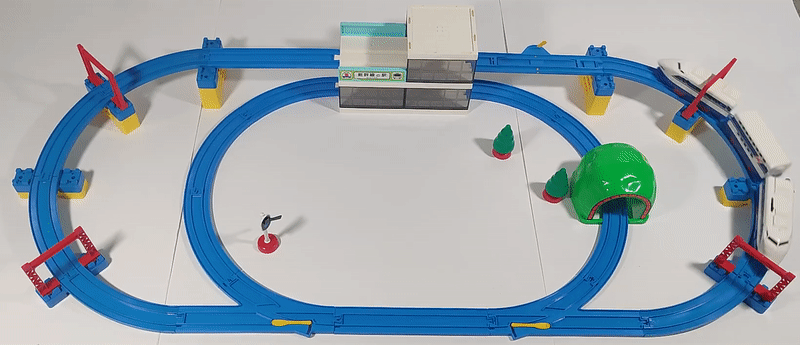
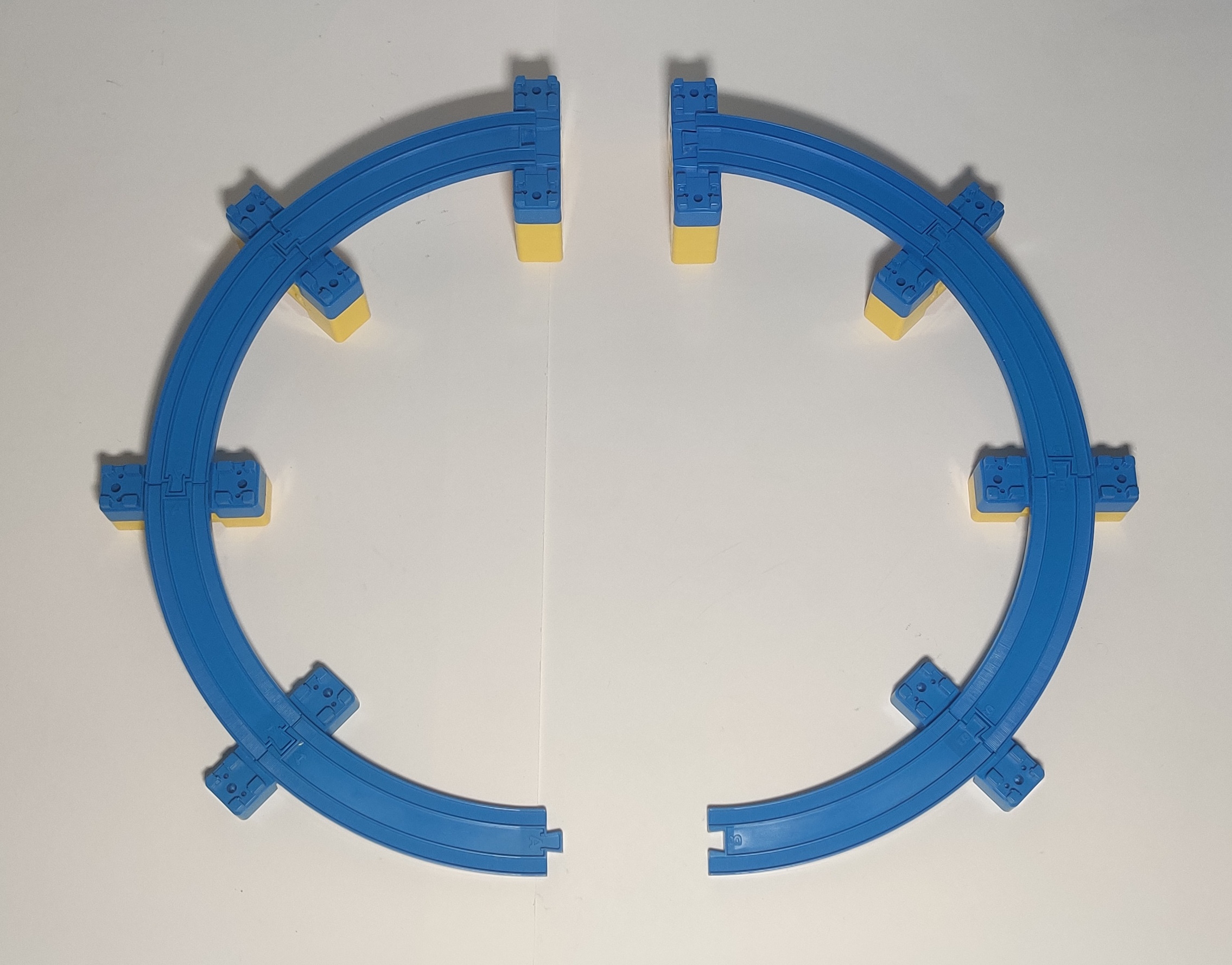
Mini Bridge Piers were first used in sets beginning in 1987 like the 2-Speed Shinkansen Three-Dimensional Station Set. Beginning in 1988 the R-18 Slope Curve Rail included 12 piers as well as four of each of the sloping curve rails that are molded to fit the 1/4 height increments. A normal straight rail works well on a diagonal between two subsequent pier levels, meaning a long gradual incline that is four straight rails long can be used to go up one standard block girder "level" as opposed to the two-straight-long Slope Rails.

These mini block piers were not released individually until 2001 when eight of them were packaged together as R-15 Mini Bridge Pier (R-15ミニ橋げた). Later on, the text changed to ミニ橋脚. These stacking block piers were also produced in red for the Tomy Train series in the early 1990s.
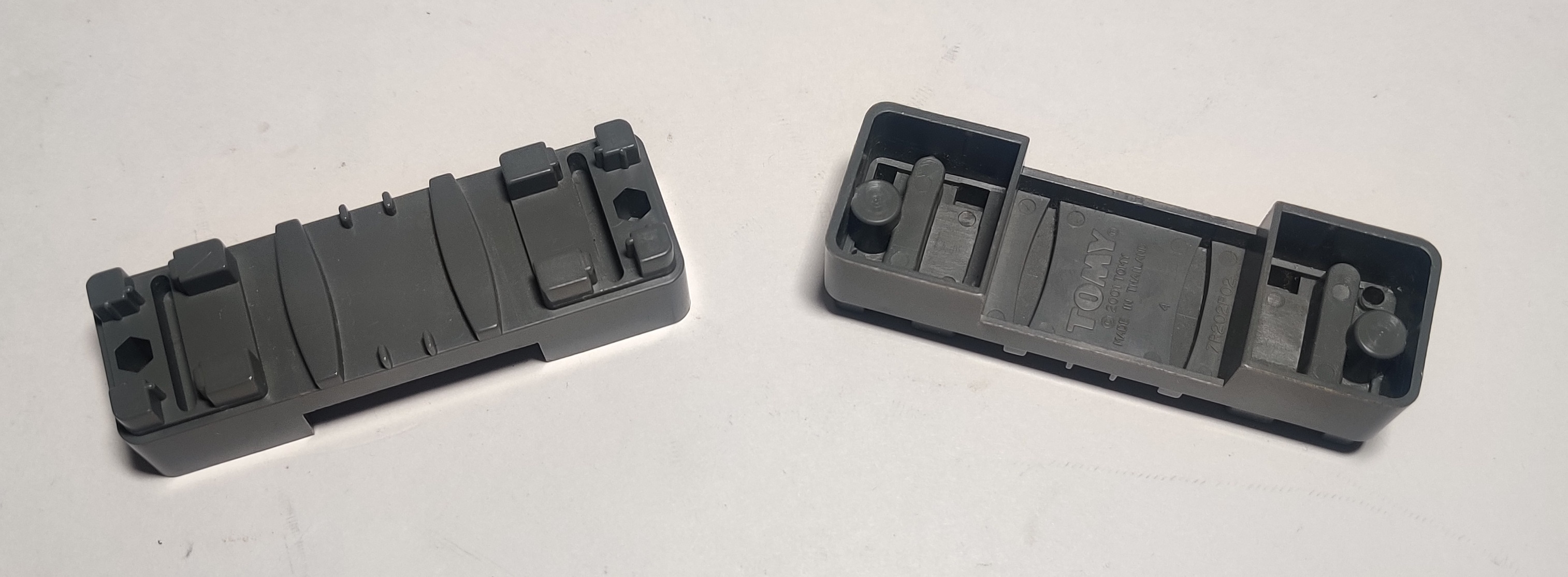


In the 2000s more color variations like light and dark grey and brown were also produced, adding to the more realistic look of new-millennium Plarail. The tooling was also updated to have the new squared-off Tomy logo. These newer block girders also changed the round accessory hole to be hexagonal like the full-height "New" girders and double track girders.
7500 Rail Bridge Supports (Tomica World) (1999)
In 1998 a six-pack of mini bridge girders began being sold via the Tomy Careline for the Tomica World range. In 2003 the six-pack was released in Thomas Motor Road & Rail packaging.
J-22 Double Track Block Bridge Girder (1997)
|
<-- J-21 Electro Railroad Crossing <-- J-21 Large Railroad Crossing |
J-23 Country Station --> |

In 1997 the new J-22 Double Track Block Bridge Girder (複線ブロック橋げた) was released that was cross-compatible with both the existing and soon to be "New" Block Bridge Girders.
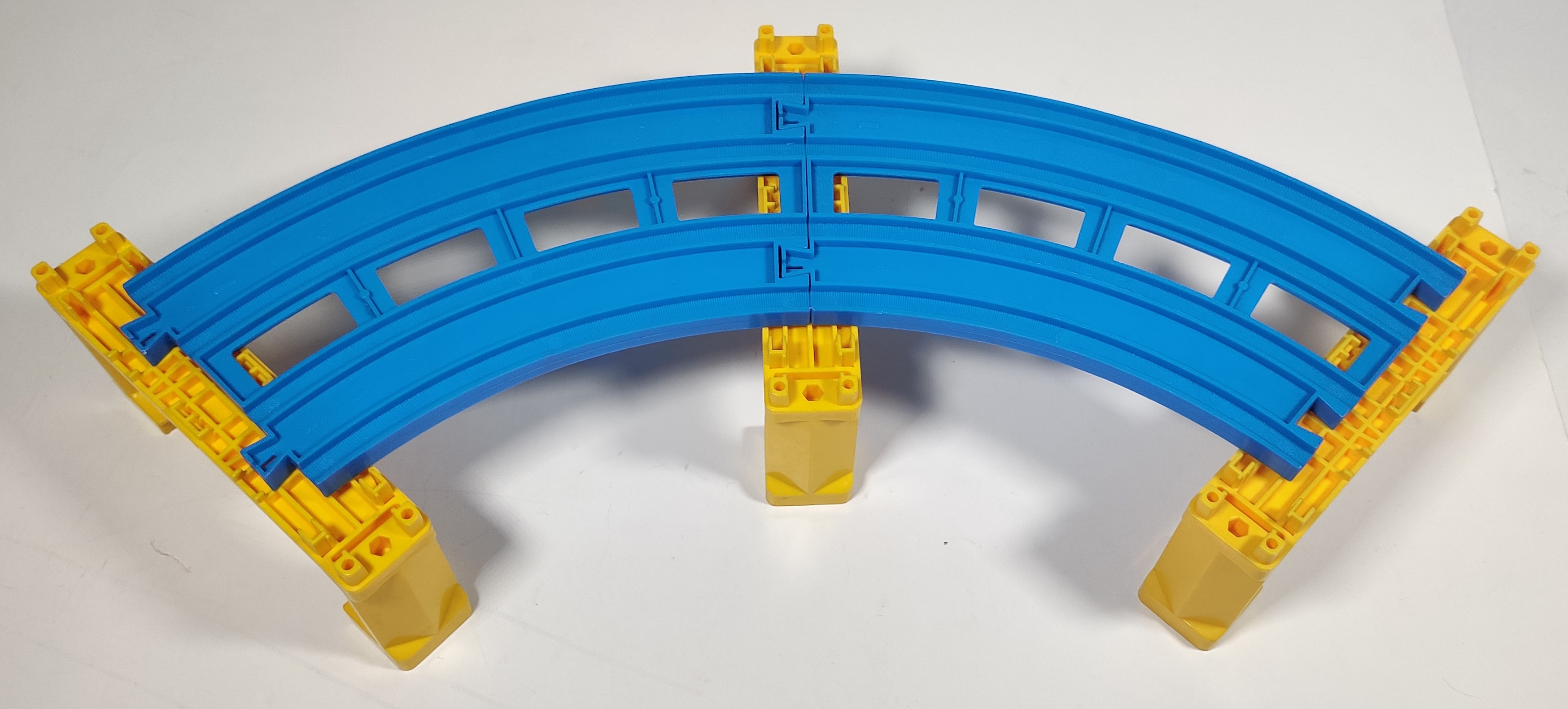
As the name suggests, these piers are designed for the double track standard. They can also accommodate double track catenaries on top.
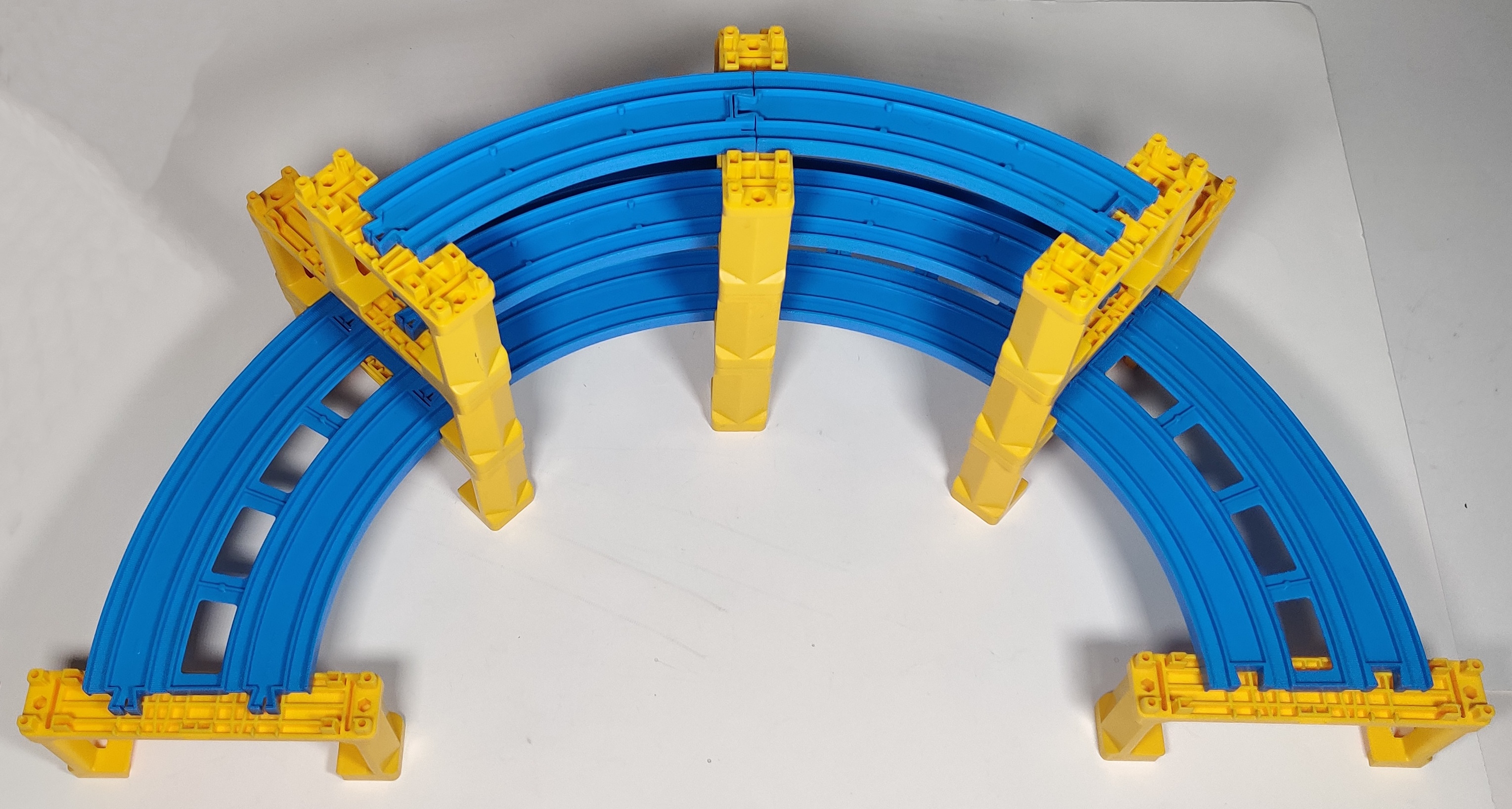
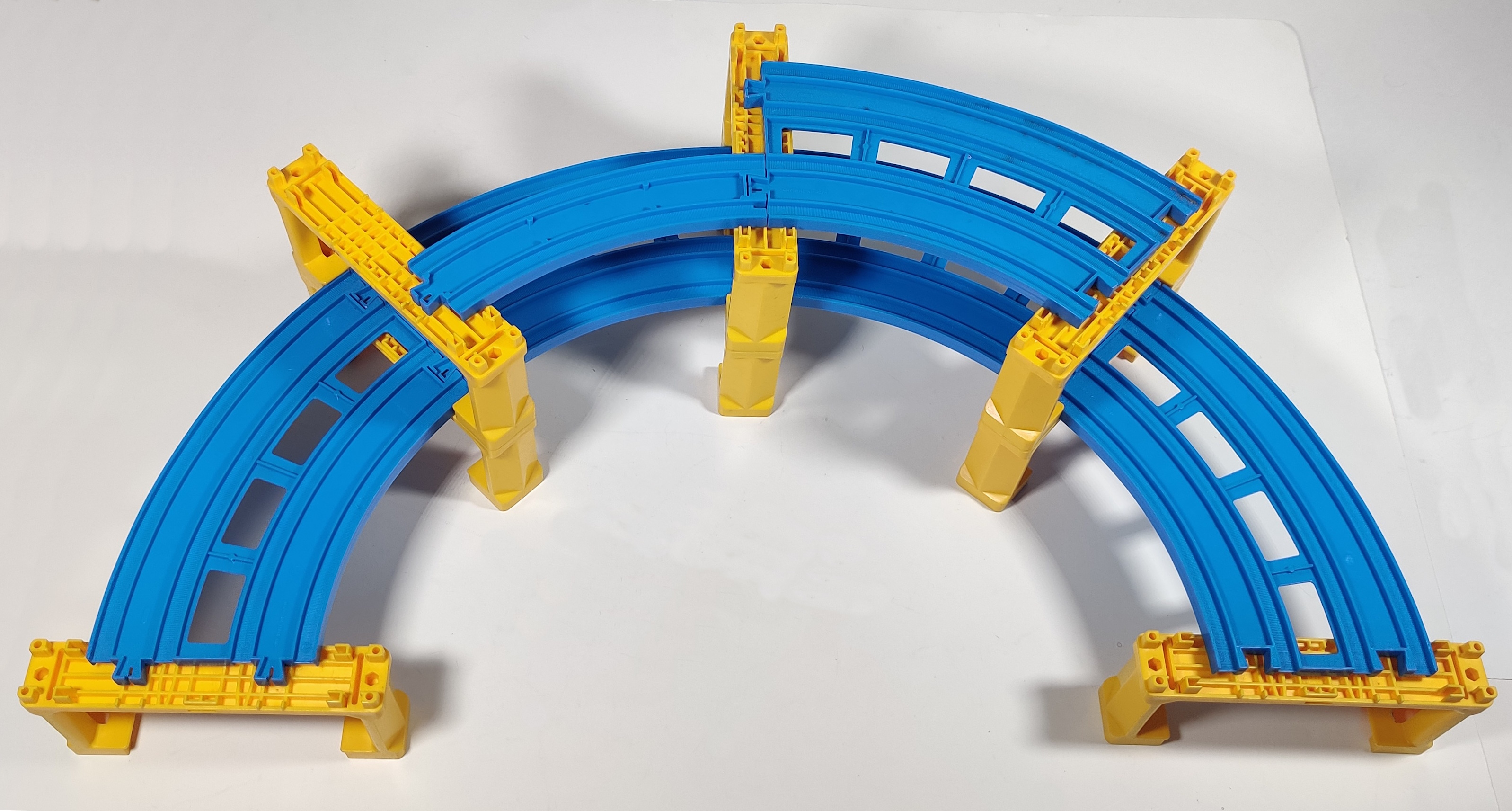
These new risers are rounded-off like the new style of block piers. A regular single track girder can be inserted over and on top of a two-track line. This single line can be over either the inner or outer rail of the lower level. A single block pier cannot be placed over double rail due to the connection area in between but it can be placed over an empty or single-line double pier.
J-14 "New" Block Bridge Girder (1997/1998)
|
<-- J-13 Bridge Girder <-- J-13 Cross Drawbridge |
J-15 Double Track Bridge Girder --> J-15 Mini Bridge Pier --> |
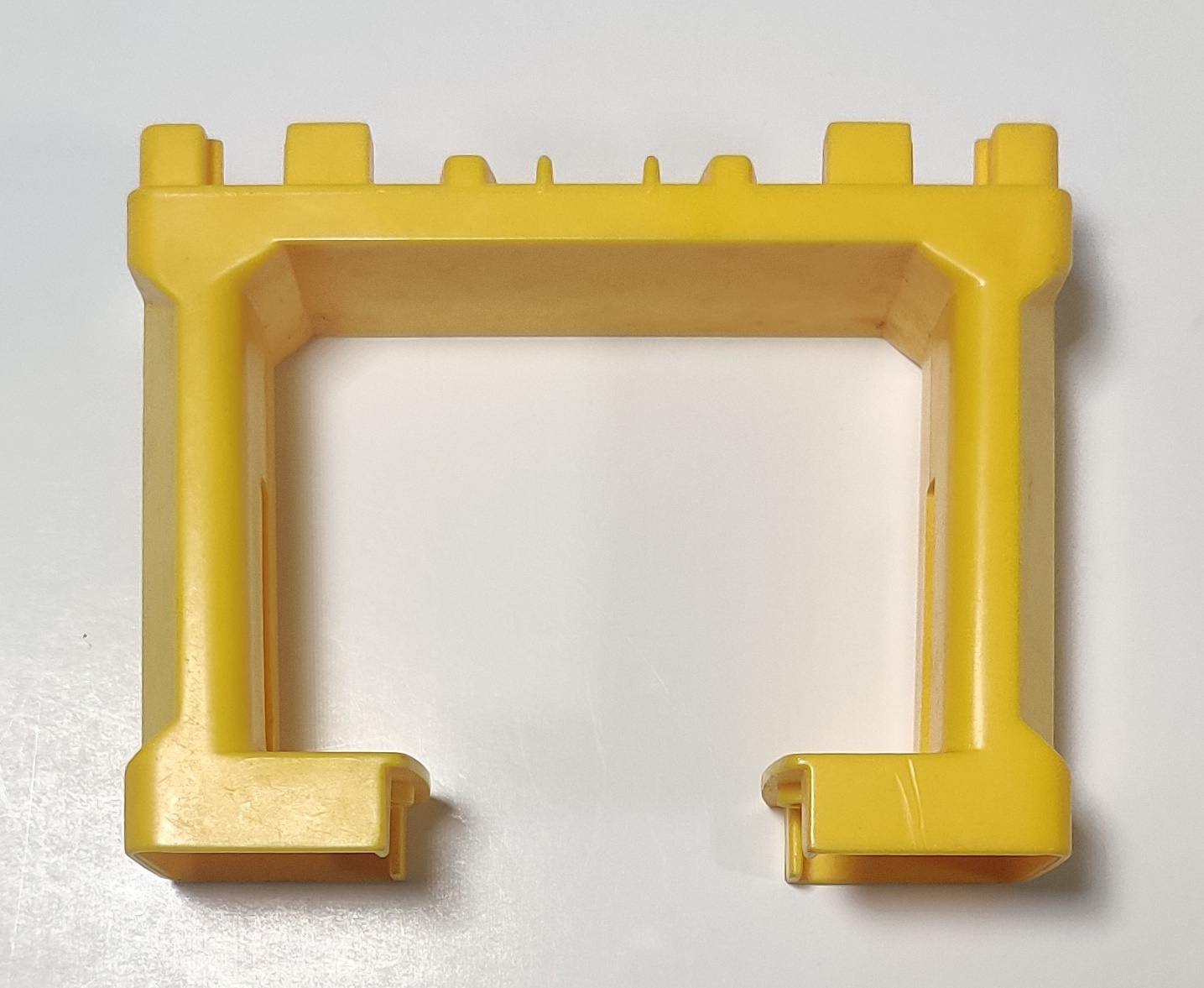
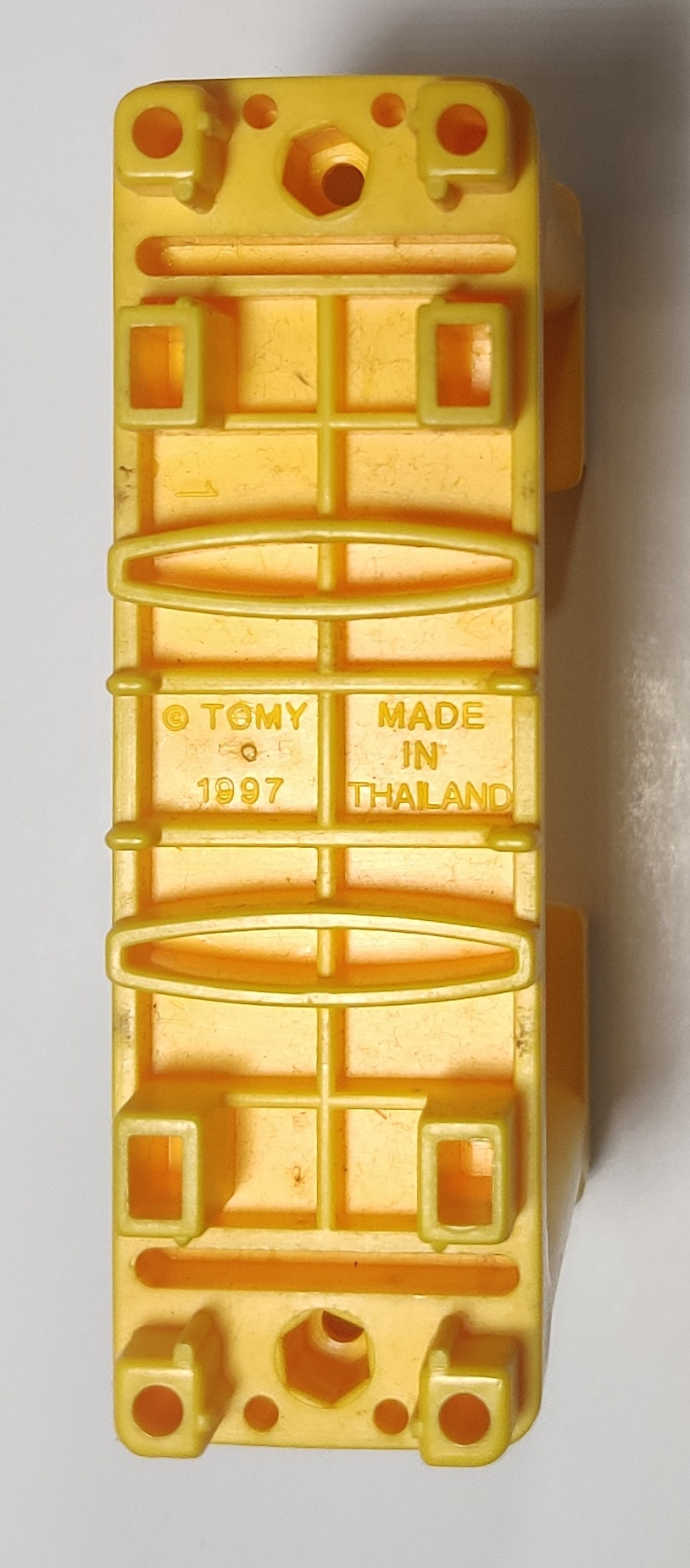
The "New" Block Bridge Girder (ニューブロック橋げた) was released in sets in 1997 and individually in 1998 and is an updated version of the Block Bridge Girder but with rounded support walls to help prevent trains from hitting against the supports in complicated layouts. Early examples are dated 1997 and marked Thailand.
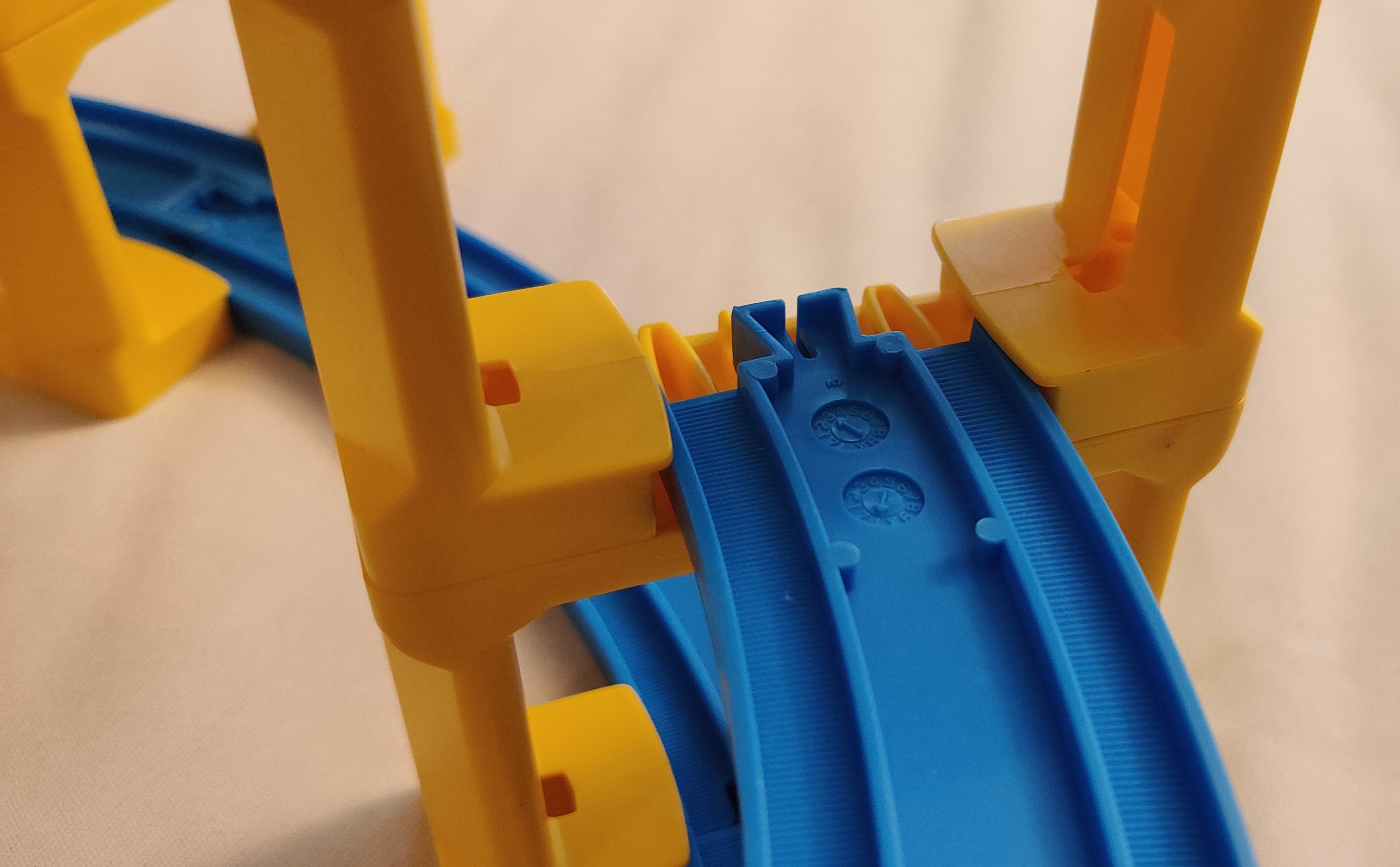
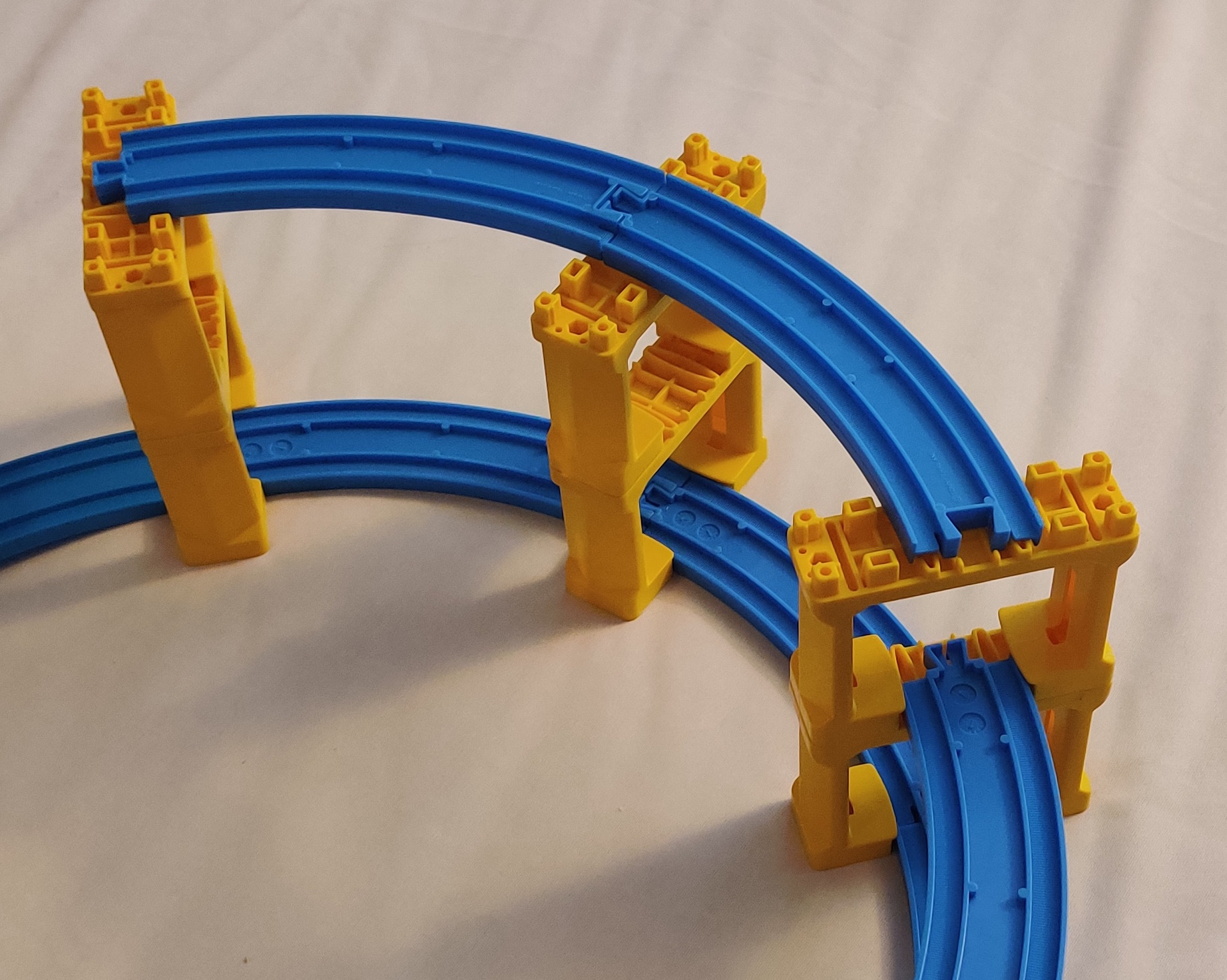
These girders can be used more or less the same as the original block girder. With many of them, very large and tall elevated towers and spirals can be made. Like the original block girders, they clip in over and around lower track connections - Adding or changing a track piece lower in a tower requires disconnecting the piers holding the joint together, which is annoying to do when a large spiral has already been built on top, so it is best to build in layers and hope you do not need to change something further down later on.
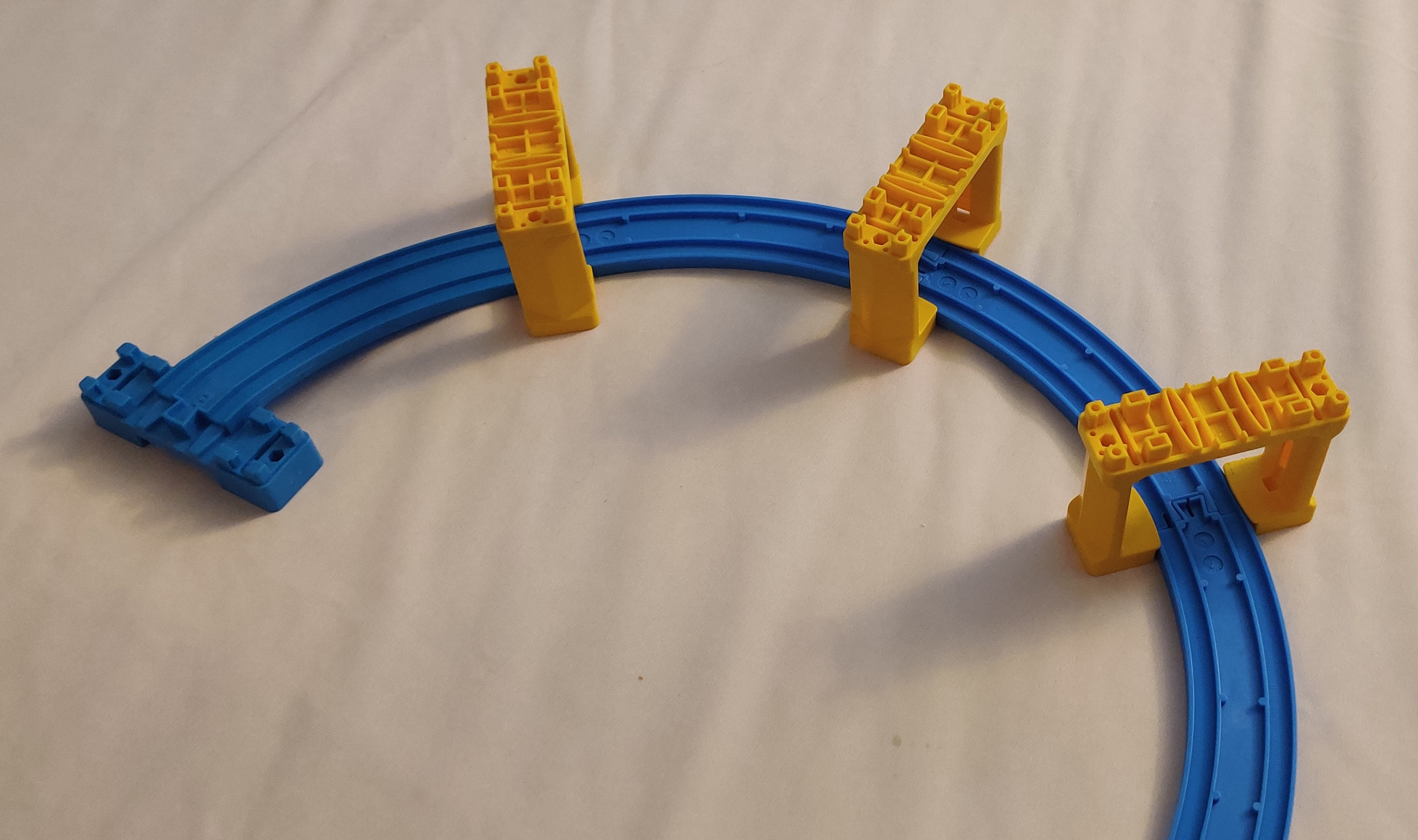
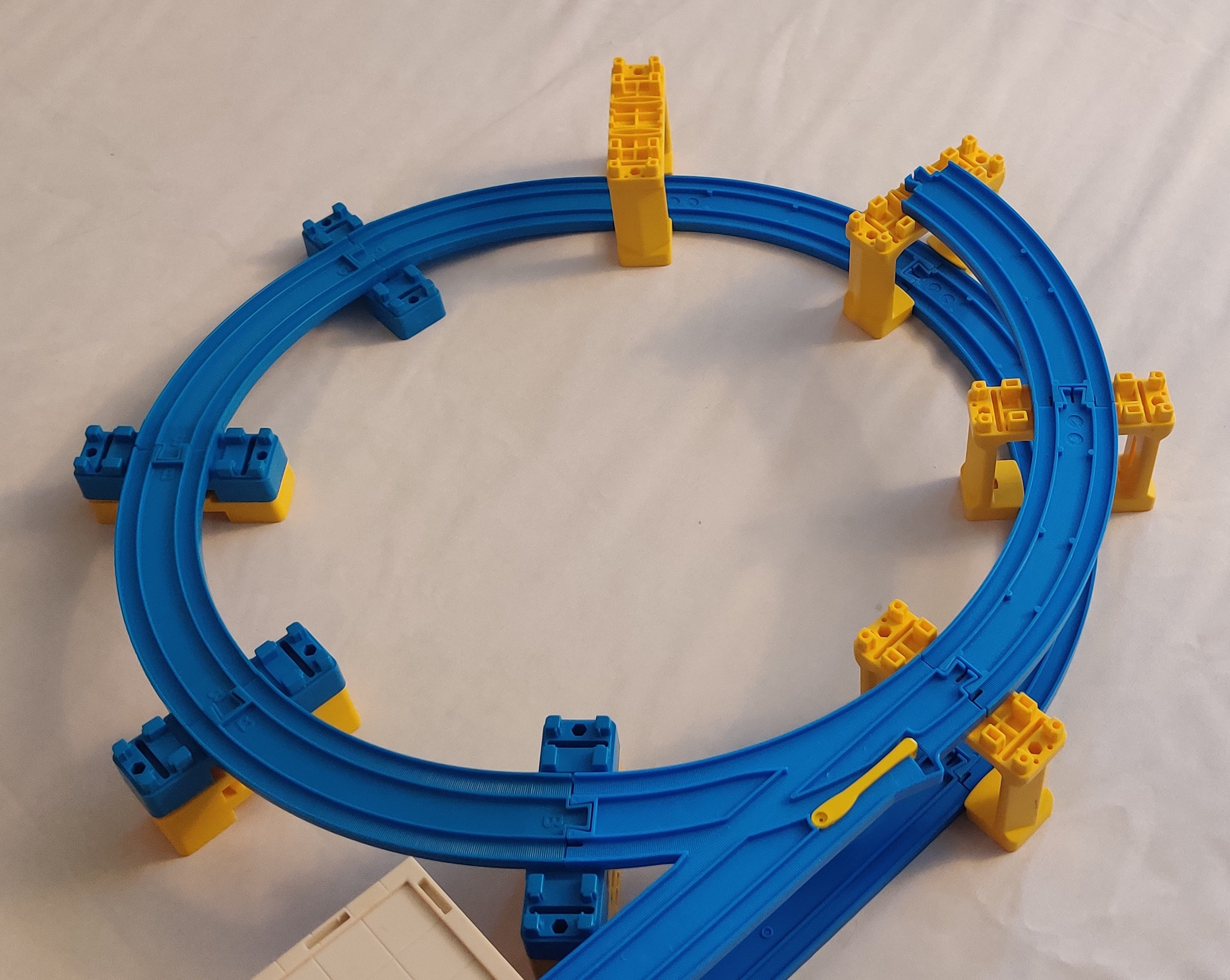
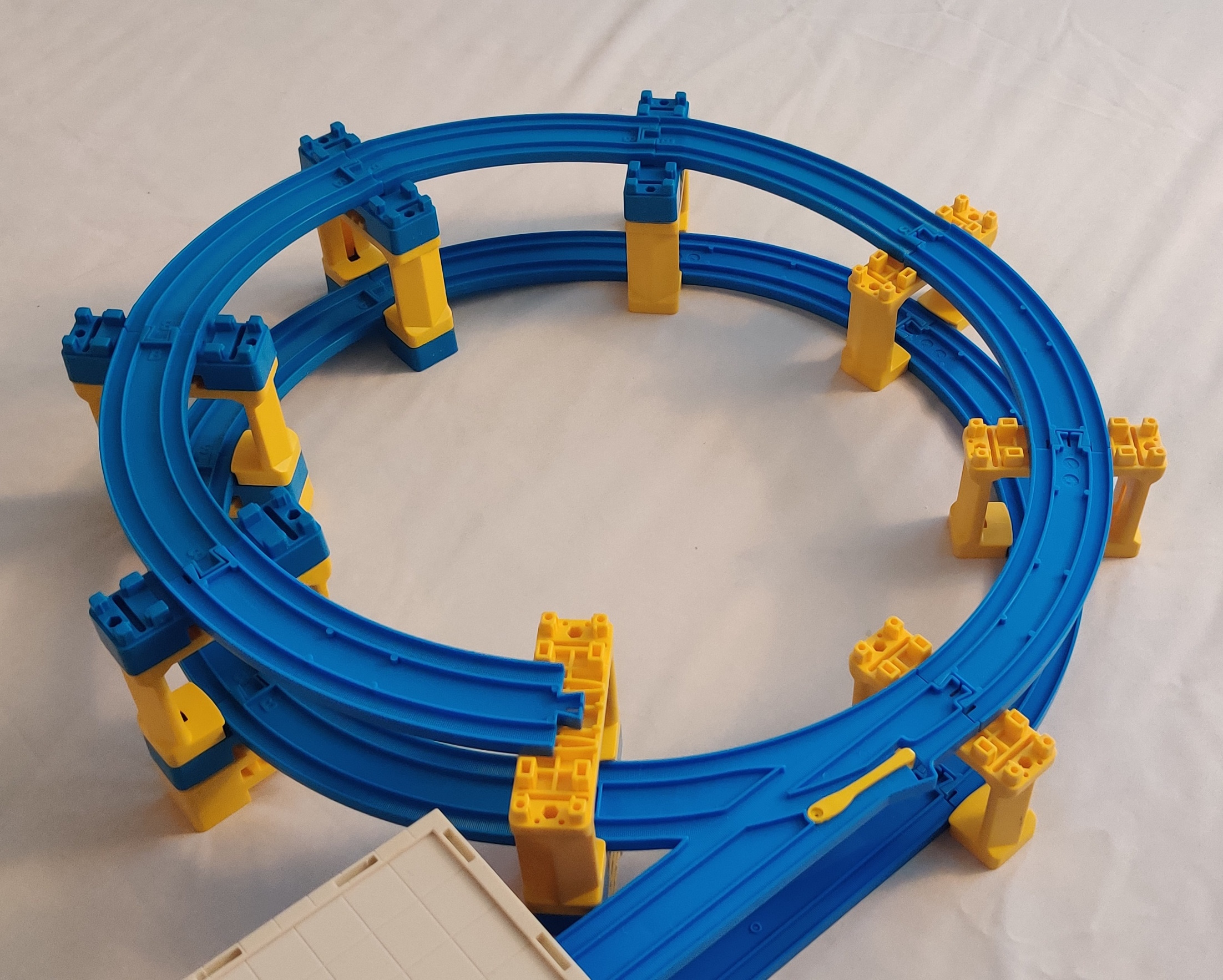
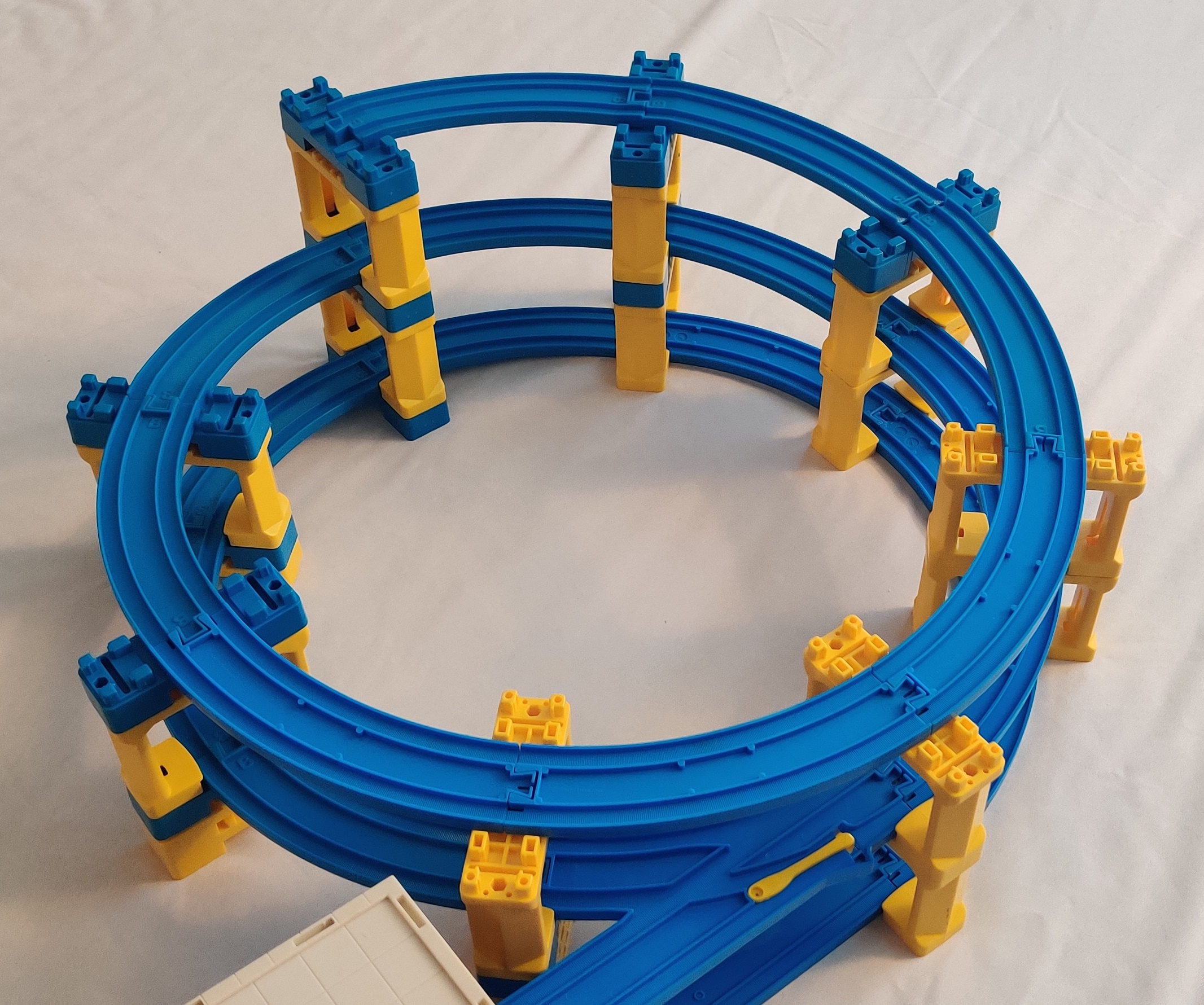
The easiest way to handle building spirals, I find, is to add a few track pieces on the current layer at a time, and then use girders over some of the completed joints to help hold the track in place and be ready to place the next layer.
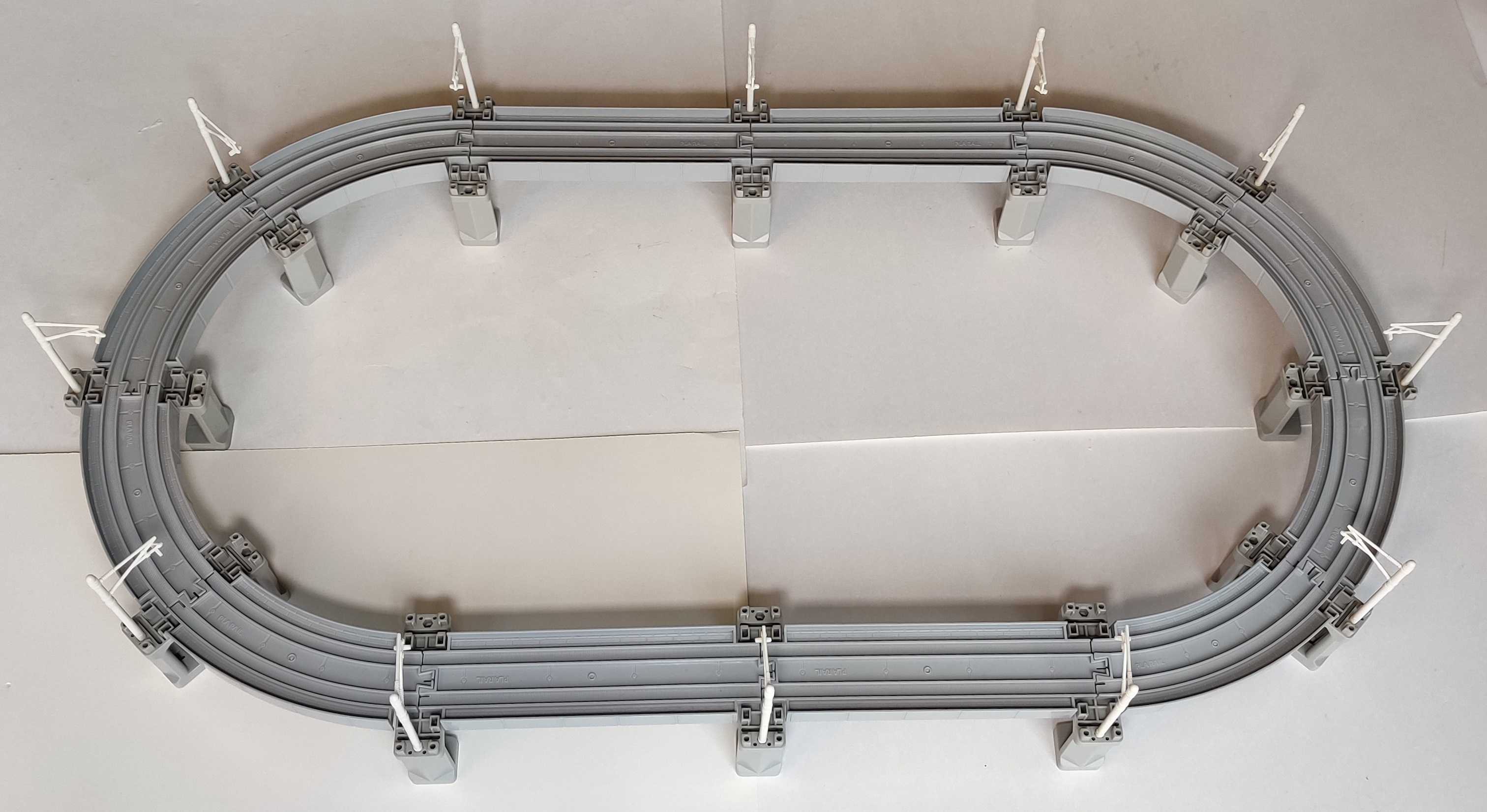
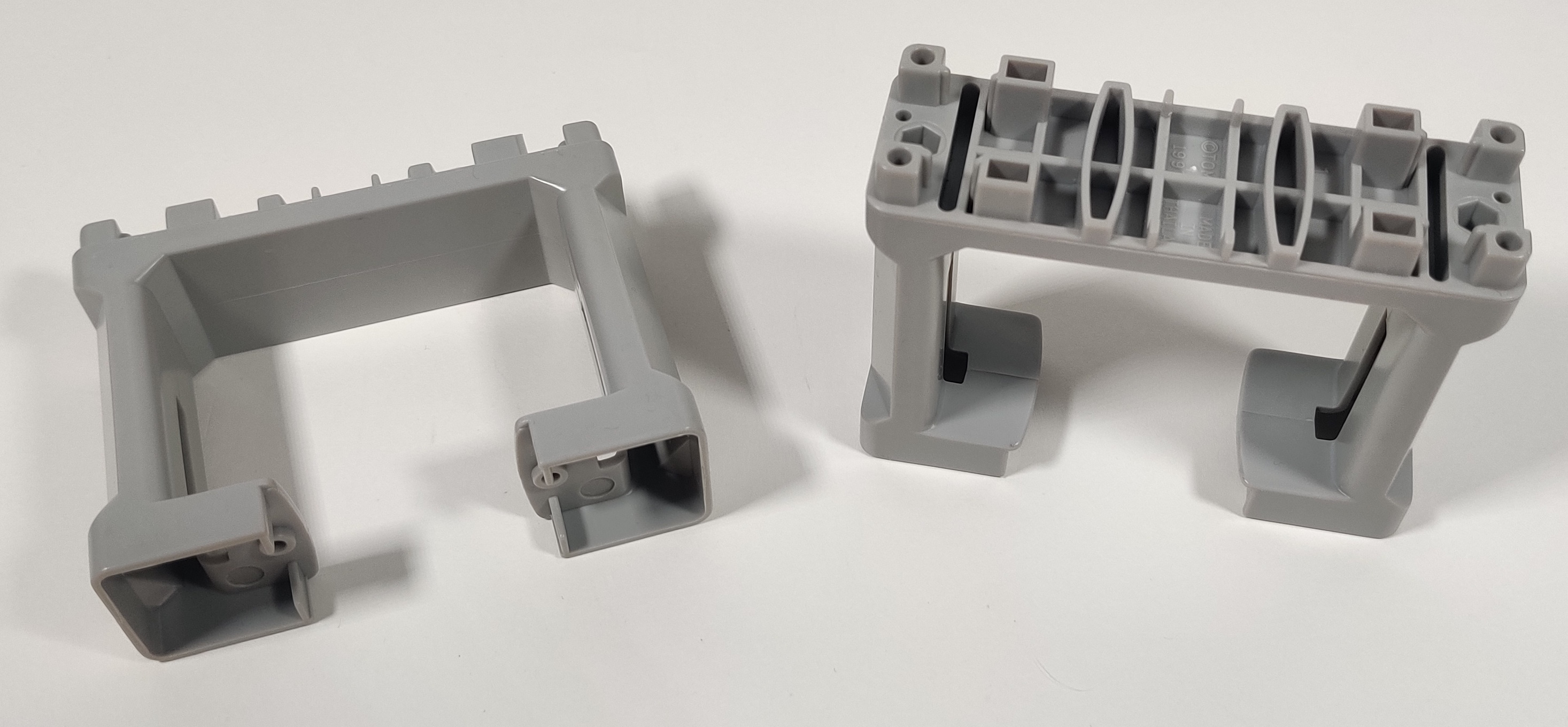
Like the mini piers, New Block Girders were produced in a few different colors in the 2000s like grey for the elevated rail series. The large circular accessory holes on either side of the rail joint were changed to be hexagonal... I think this might let the holes grab on better with smaller contact areas, and that might make it easier for children to pull out accessories without breaking them. Of course, they still work with single overhead wire poles.
7489 Girder (Tomica World) (1998)
In 1998 a six-pack of "new" style girders began being sold under the Tomica World range. They were also included in many sets.